Welcome to the November Issue of
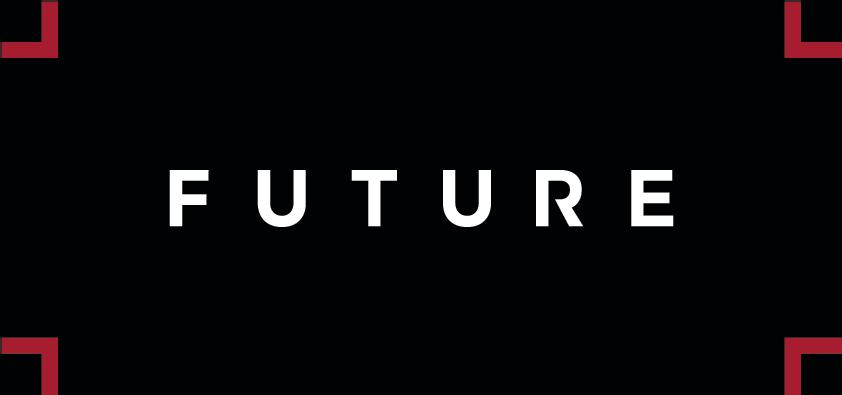
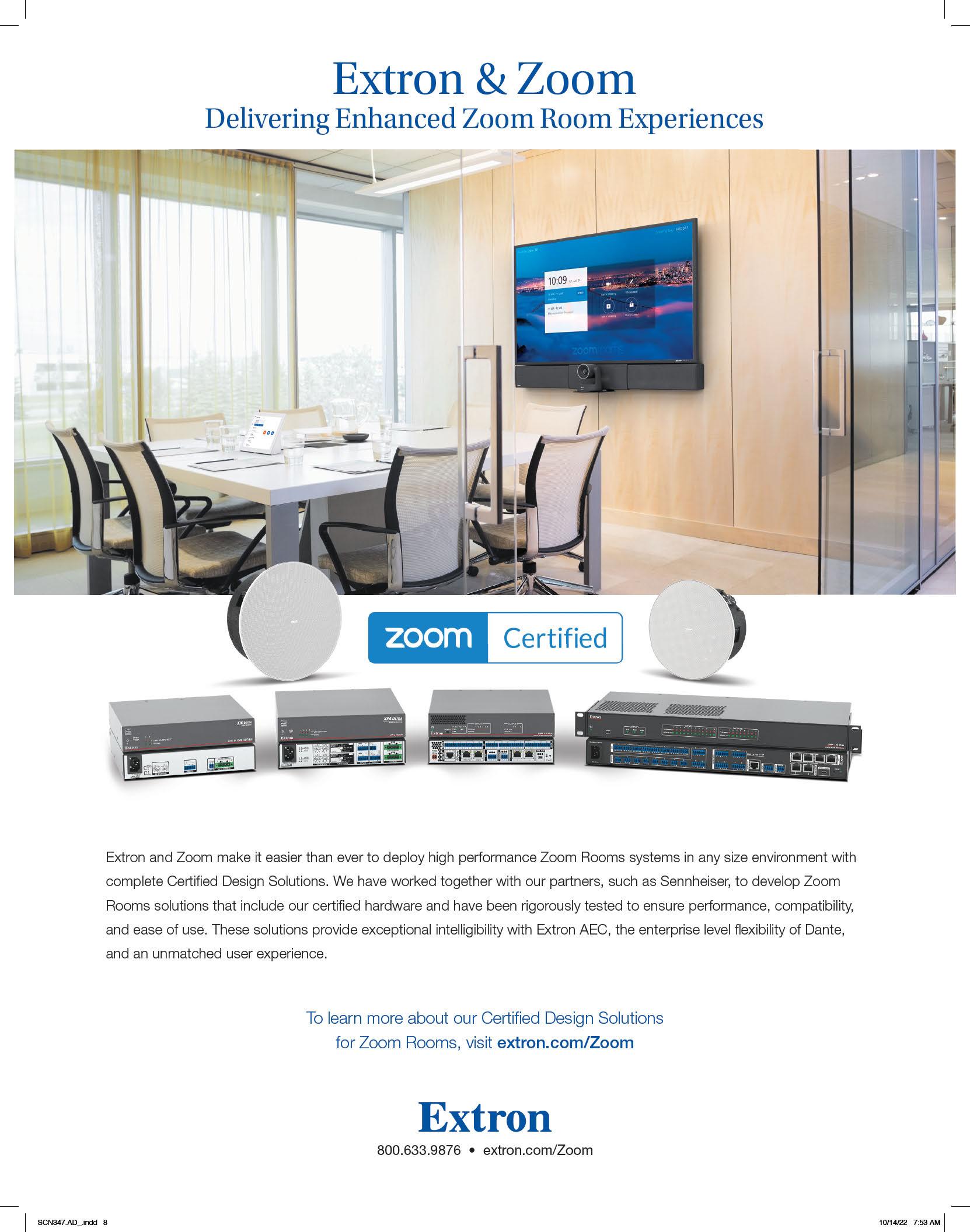
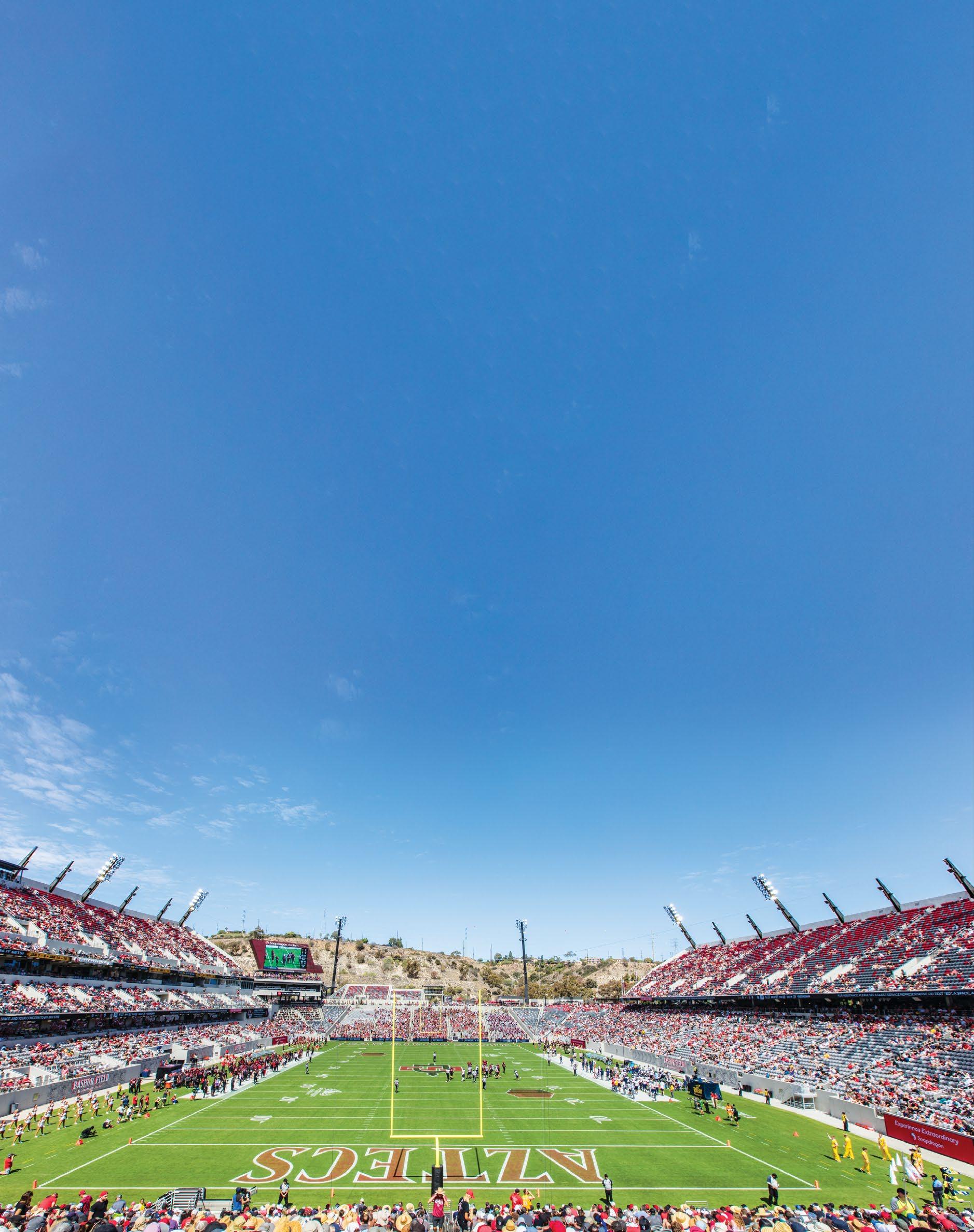
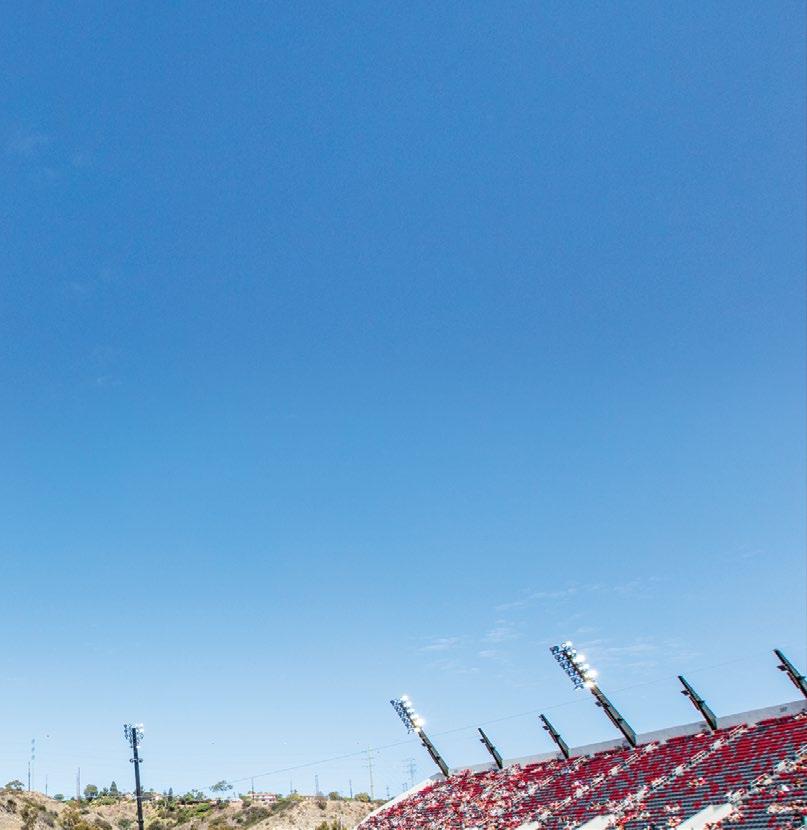
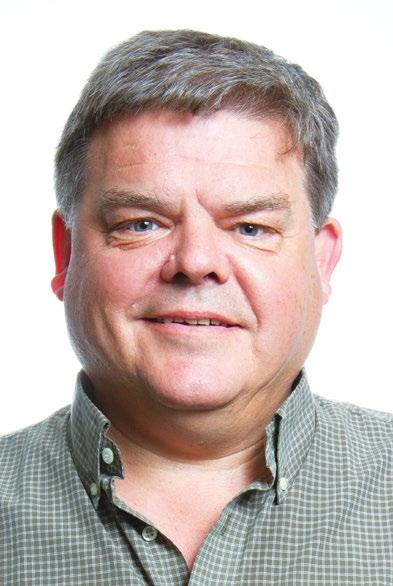
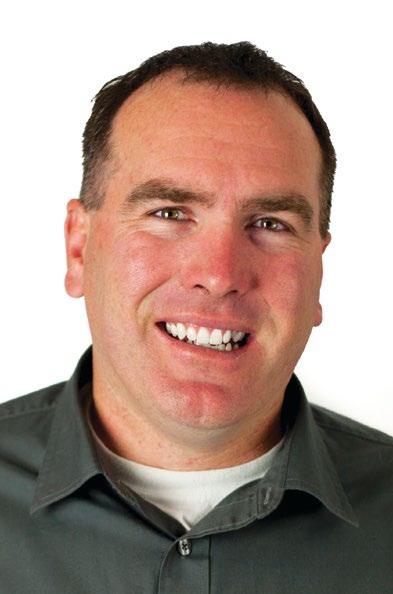
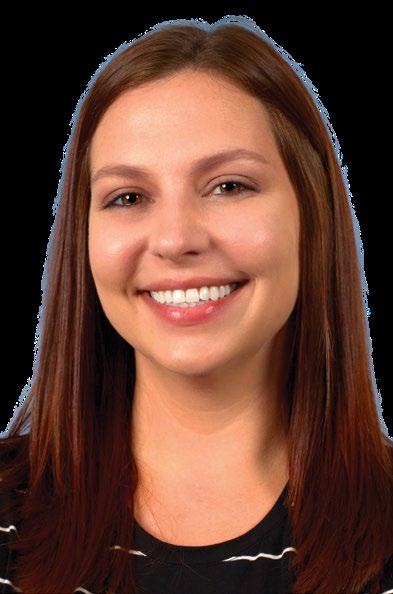
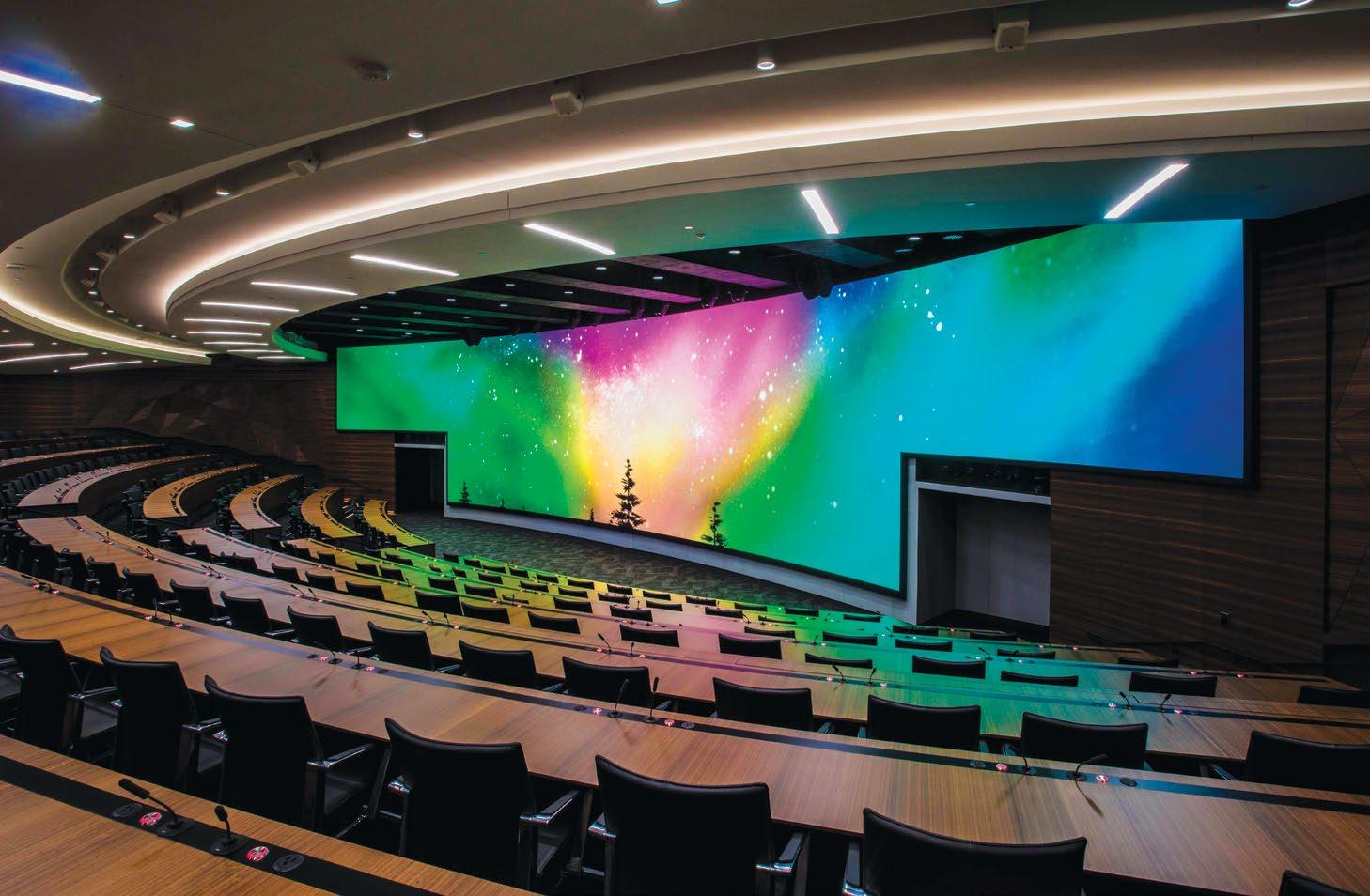
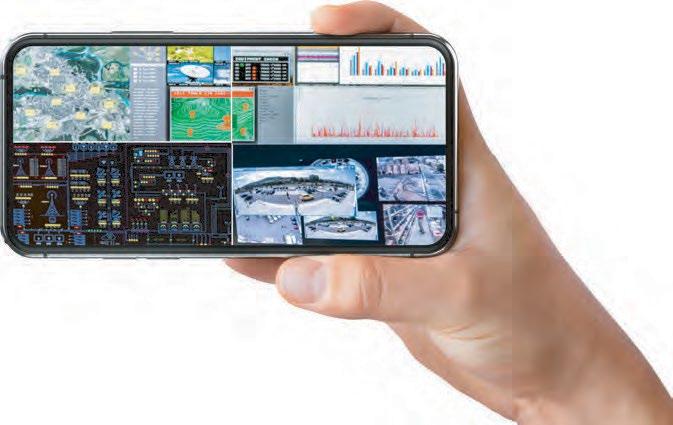
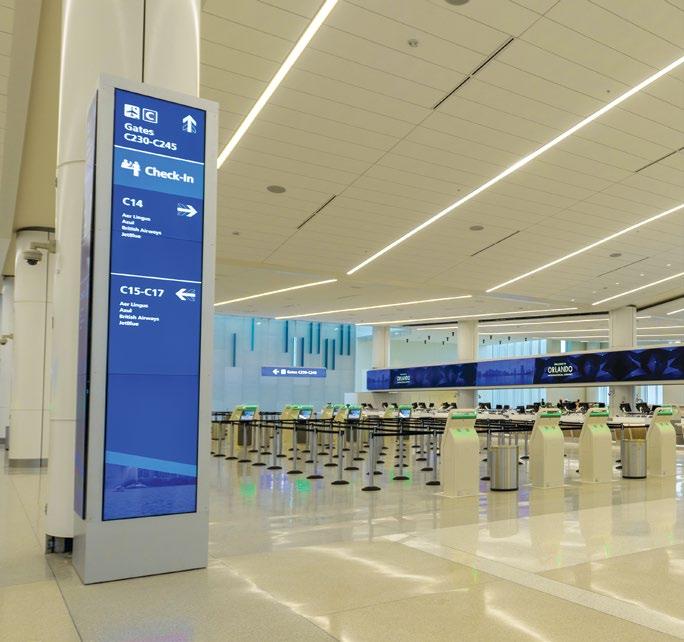
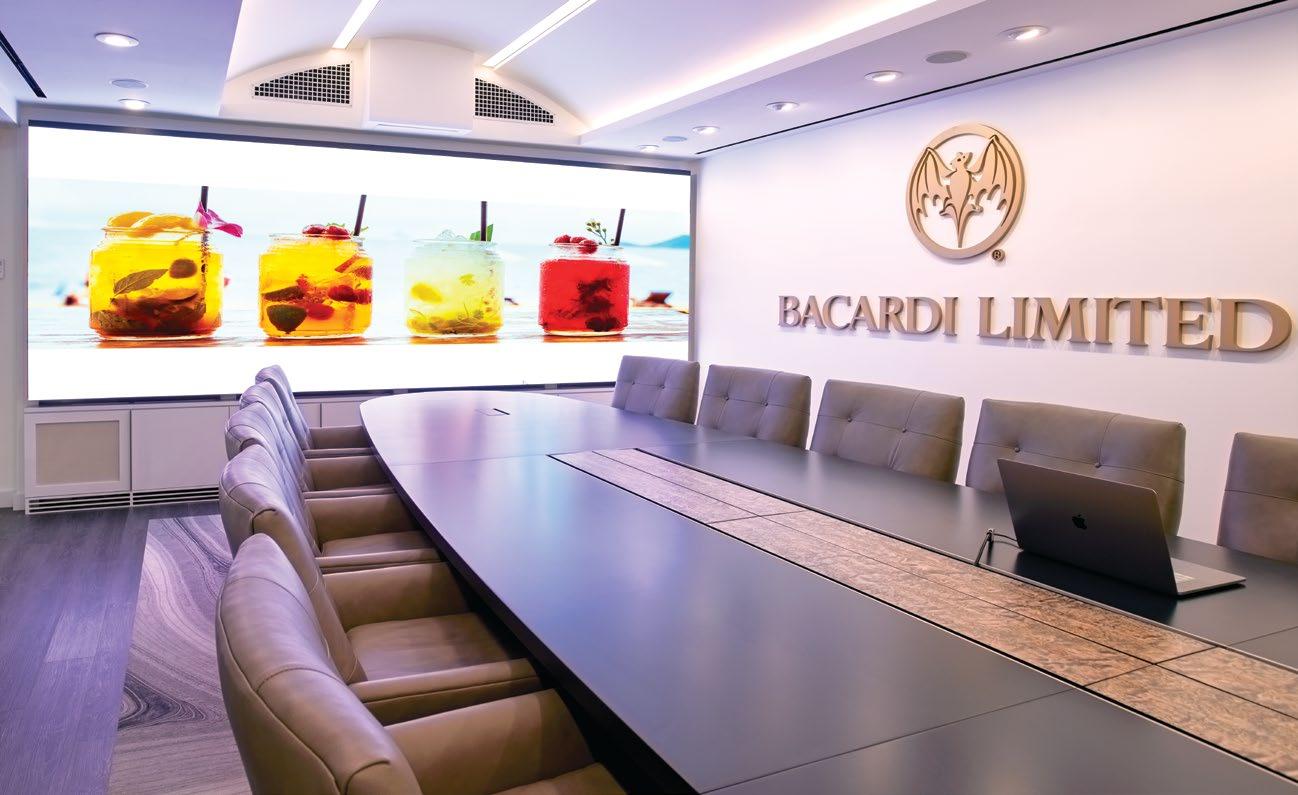

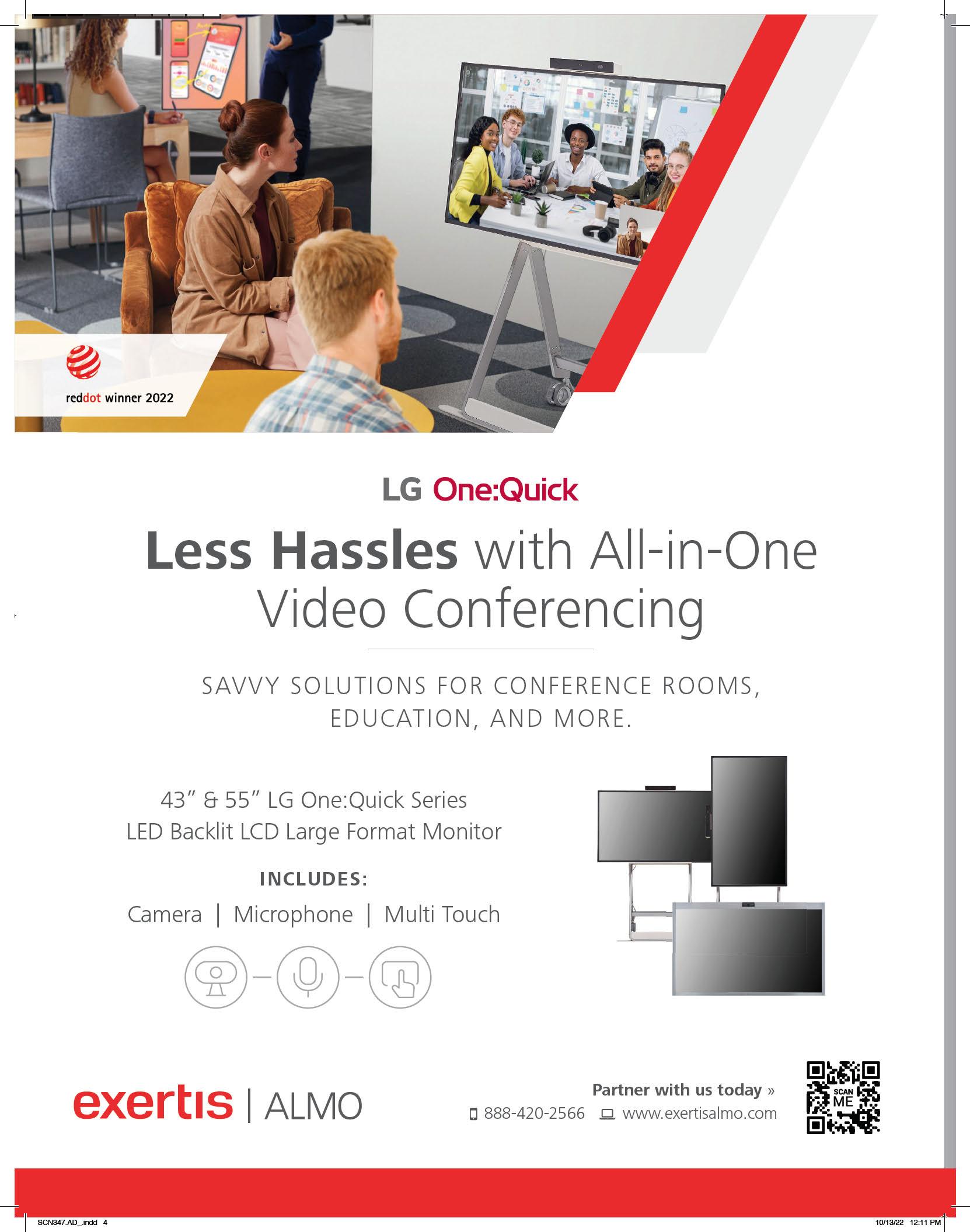
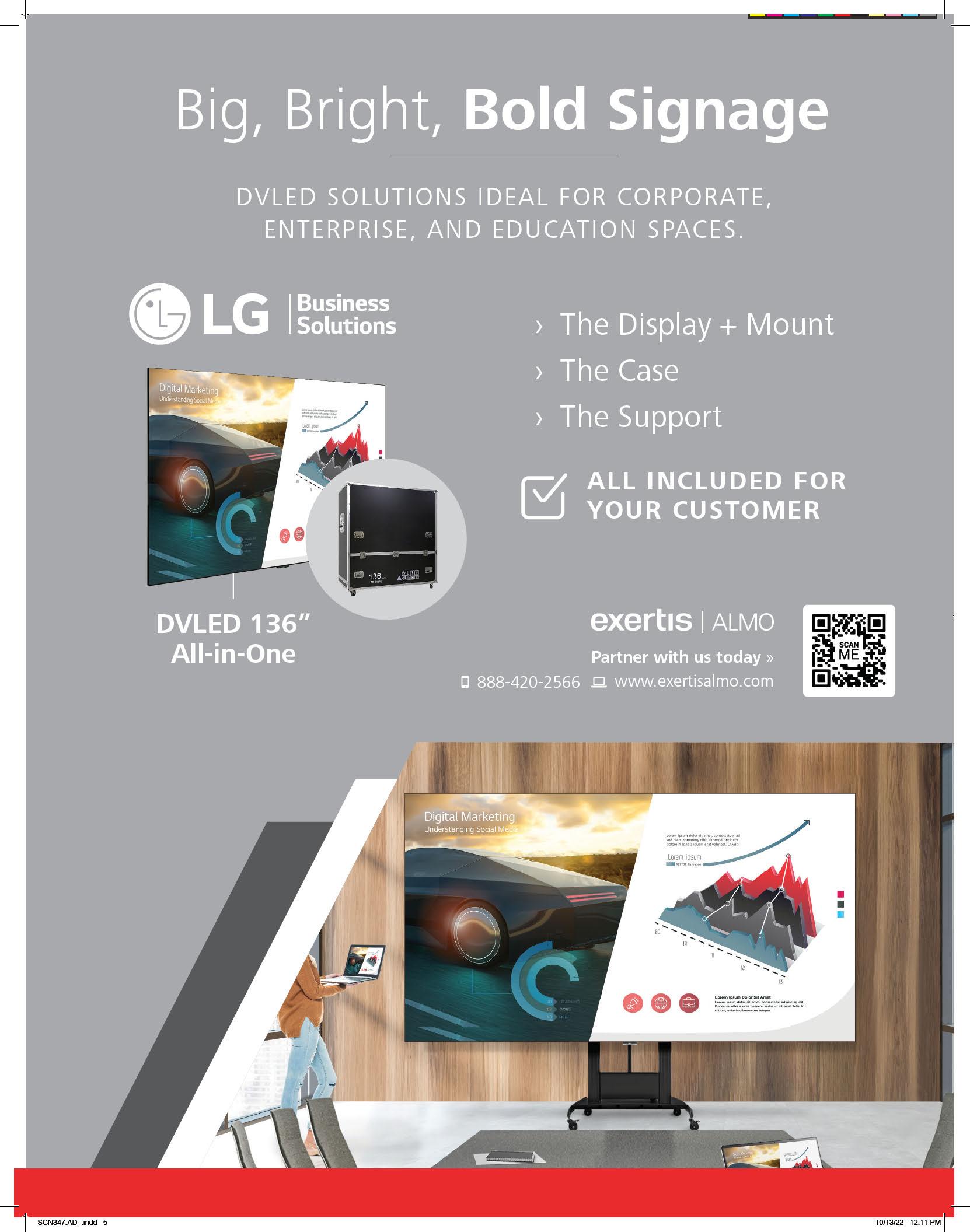















Take a look at 10 of the top installations completed this year.
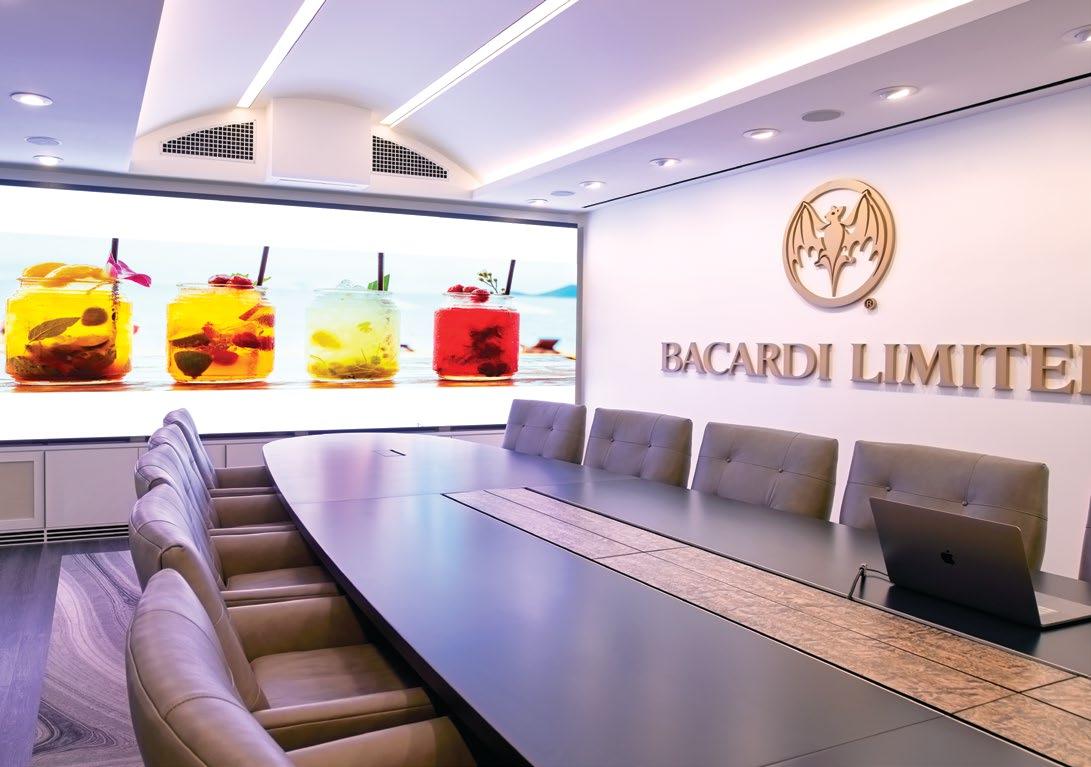
CEO Michael Wiener explains how a Las Vegas experience inspired him to create Vanguard LED Displays.
By Mark J. PescatoreBroadcast Pix CEO Graham Sharp talks about the company’s transformation to software-based solutions.
By Mark J. PescatoreThere are three critical components necessary for any successful Pro AV project.
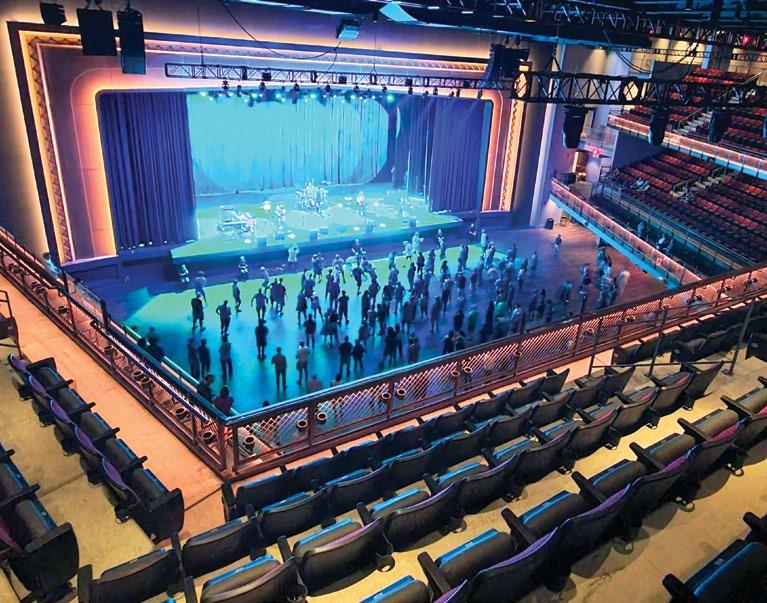
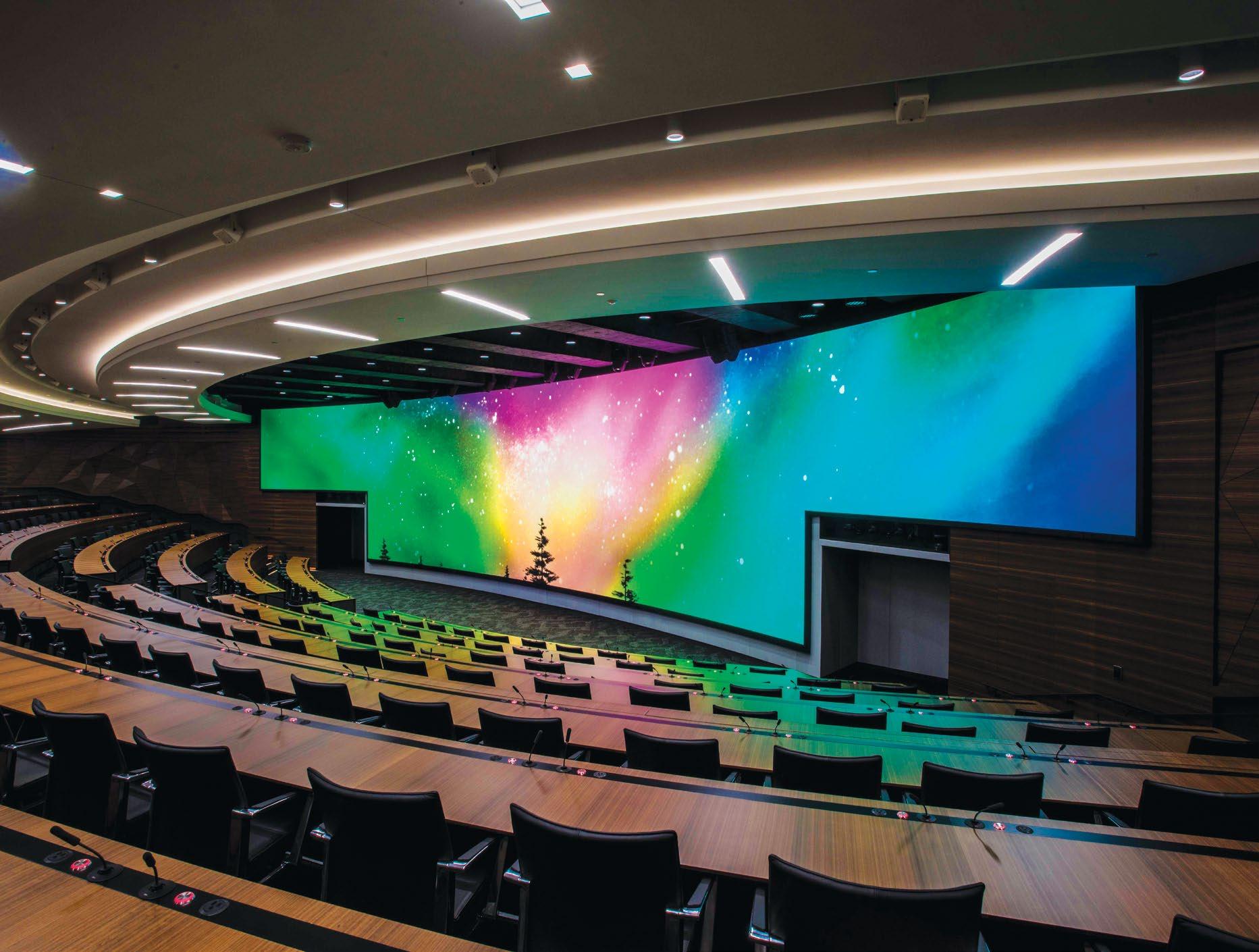 By Douglas Kleeger
By Douglas Kleeger
Business
A camera tracking system and video wall are just parts of a new virtual production studio at DeSales University.
By James CarelessHow can integrators make the most of remote monitoring?
By Evan Marty31 AJP Brings Vivid Imagery to Clemson’s Death Valley New technology improvements bring renovations without sacrificing gameday traditions.
Digital Scoreboards brings high-end, customized visual solutions to smaller school stadiums.
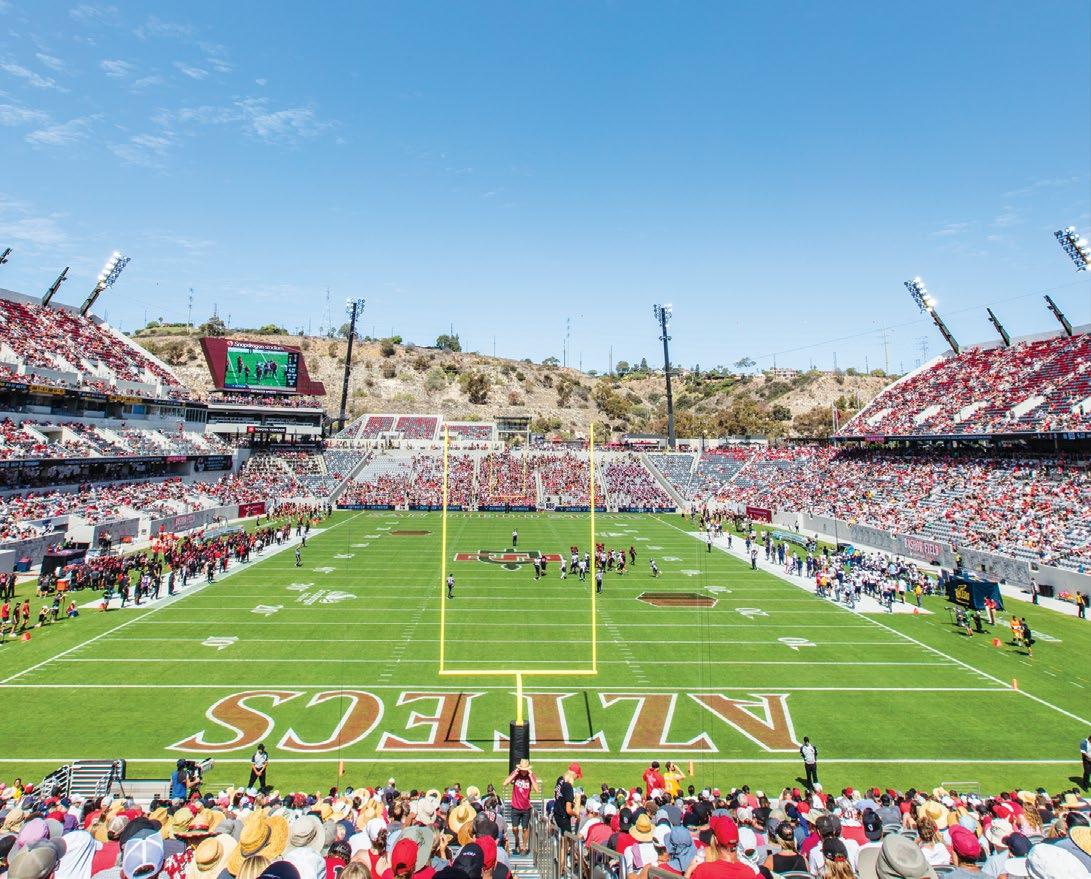 By Wayne Cavadi
By Wayne Cavadi
A new video wall at Denver Botanic Gardens highlights the region’s diverse ecosystem.
By Carolyn HeinzeResorts World Las Vegas Delivers an ambitious AVoIP strategy.
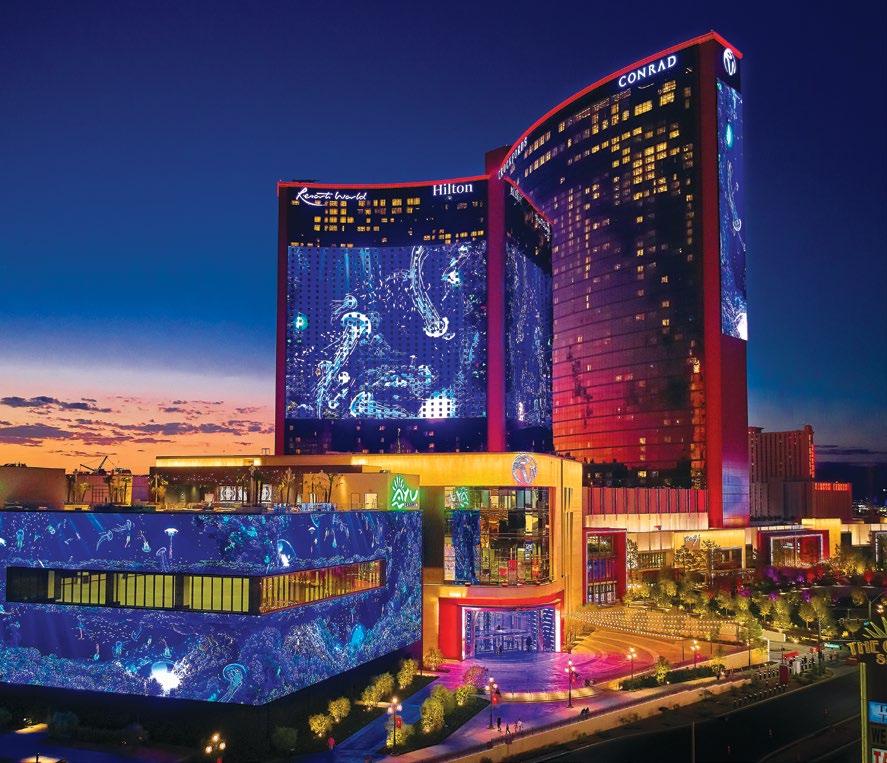 By Jennifer Guhl
By Jennifer Guhl
Accessibility continues to gain importance in live events.
By Bill BennettRead our hands-on test of the Sennheiser and Xilica Medium Room Kit.
By Chuck Gloman42 SCN Product Showcase 2022
Here are some of the products that sparked the most interest online this year.
44 Better Heard, Not Seen Industry experts offer installation advice for in-ceiling speakers.
By Wayne CavadiLive events are not slowing down, so we need effective work habits.
By Mel BaglioASSOCIATION NEWS
PRODUCTS
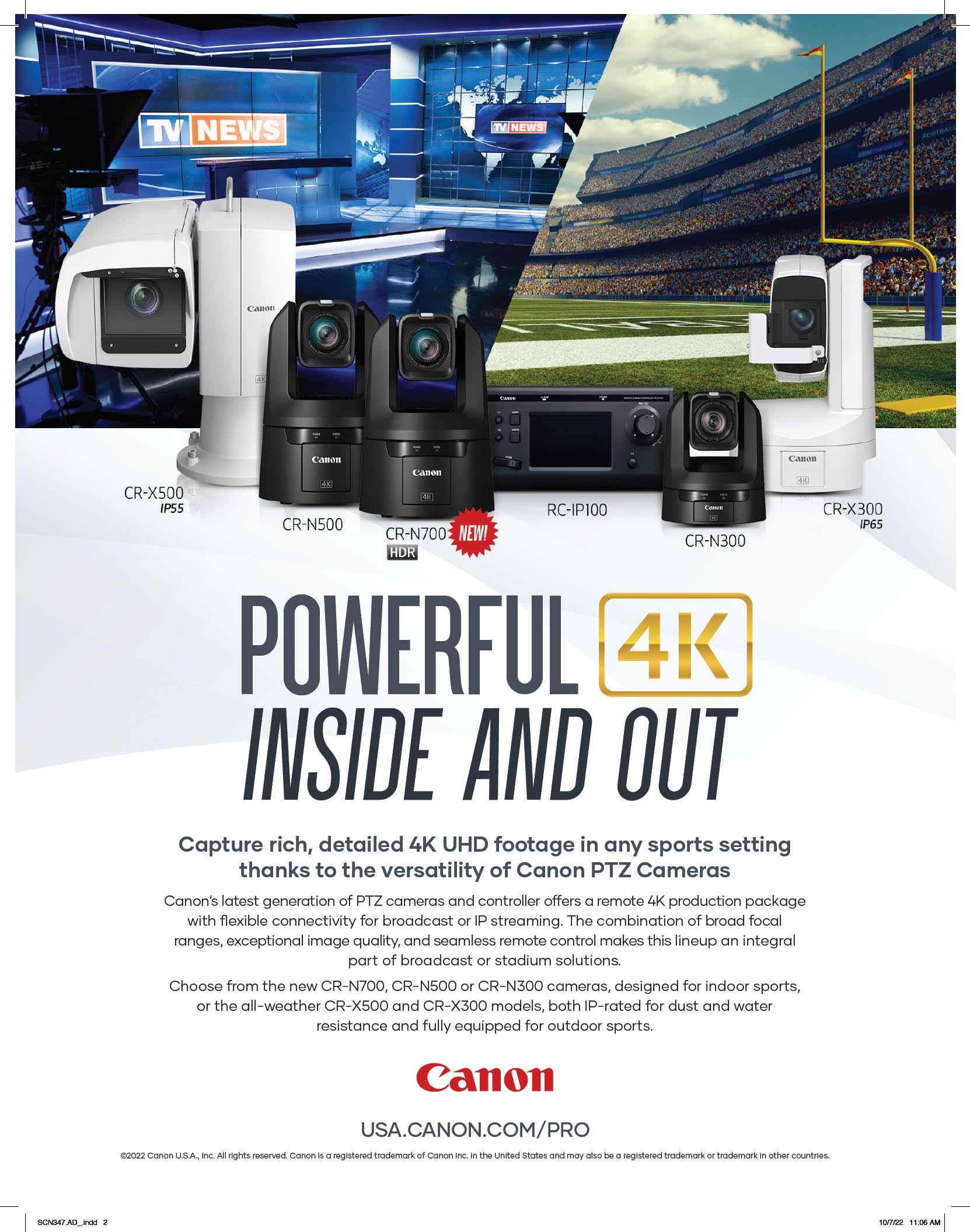
Below: Volunteers from Mimo Monitors, as well as other exhibitors and Exertis Almo and AVIXA representatives, worked with Generosity Feeds to prepare 5,000 meals to help fight child hunger in the area.
Produced by Exertis Almo, the E4 Experience traveled to Reston, VA (not far from Washington, DC) on Sept. 23. It was the first time E4 has been in the area since 2018, and I was invited to experience, well, the experience.
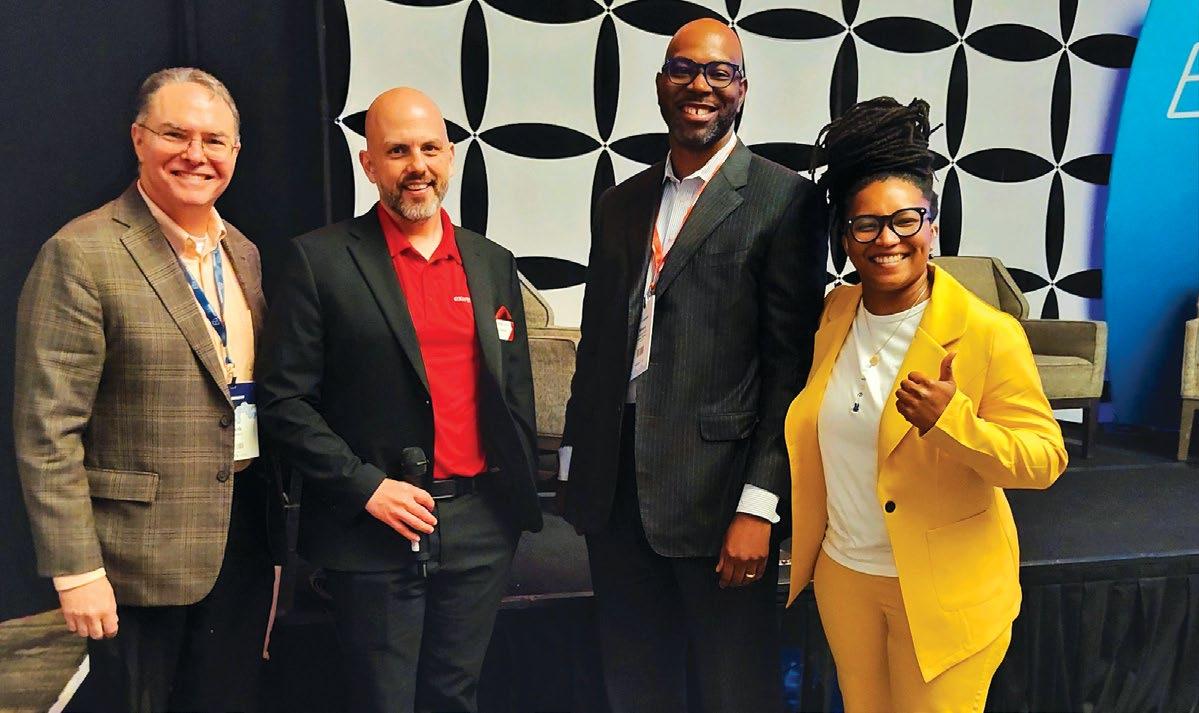
On the afternoon before the show, I helped the Exertis Almo team, along with exhibitors and AVIXA representatives, prepare 5,000 meals for Generosity Feeds, which helps to provide food to about 400 children in the Reason area each week. That certainly started the experience on a good note.

Melody Craigmyle, vice president of marketing, reported 520 registered attend ees and more than 40 exhibitors for the one-day event, which is focused on the tenets of educate, explore, engage, and expo (E4). The event attracted registrants from eight universities and seven Fortune 500 companies, in addition to integrators, resellers, and consultants.
“It’s really a great combination for success, and we’ve seen it over the years,” said Craigmyle. “People are very excited to get back.”
The show floor was certainly packed at times, and there were plenty of people at the training sessions. It wasn’t just tabletop exhibits, either; there were several video walls and oversized displays. The show floor also featured projectors, mounts, digital signage solutions, audio products, cameras, and more. Craigmyle said savvy integrators regularly bring end users to E4, using it as a “showroom for the day.”
Attendees were also provided with access to CTS-certified courses, covering everything from workspaces to conducting a needs analysis to successful project management for design and installation. Not a bad deal, considering admission was free and included a buffet lunch.
I even got recruited to be part of the show. I’m usually the one asking the questions, but this time I was part of a panel, “The Future of AV in 2023,” which was moderated by Alesia Hendley, a multimedia journal ist and business development representative at Audinate.
Sam Taylor, executive vice president and COO, Exertis Almo, enjoyed the “energy” of the day. Energy is not one of the four Es, but you could certainly make the case for it. He thought attendees were happy to research products in person, instead of virtually, and they were also enjoying the networking opportunities.
Beyond E4, Taylor said the company is performing ahead of its business plan, and the sales forces from both companies have success fully merged into one team. Following the celebration of its 75th anniversary, Almo Corporation was acquired by Exertis in late 2021. Exertis Almo now has close to 240 employees, including almost two dozen business development managers (BDMs). “They’re kind of the technical arm of the sales force,” he explained.
The last stop for E4 this year was Boston on Oct. 20, and Craigmyle reported the expo had attracted a record-high number of exhibitors. Plans are also in progress for a return to Dallas and the New York Metro area in 2023, with two potentially new loca tions as well. If you’re in the neighbor hood, E4 provides a great opportunity for networking, product research, education, and learning more about Exertis Almo’s products and services.
Content Director Mark J. Pescatore, Ph.D. mark.pescatore@futurenet.com

Content Manager Wayne Cavadi
Contributors Mel Baglio, Bill Bennett, James Careless, Chuck Gloman, Jennifer Guhl, Carolyn Heinze, Douglas Kleeger, Evan Marty
Group Art Director Nicole Cobban
Art Editor Rob Crossland
Vice President, AV/Consumer Electronics & Pro Audio


Adam Goldstein, adam.goldstein@futurenet.com, 212-378-0465
John Casey, john.casey@futurenet.com, 845-678-3839
Janis Crowley, janis.crowley@futurenet.com, 845-414-6791
Debbie Rosenthal, debbie.rosenthal@futurenet.com, 212-378-0468
Zahra Majma, zahra.majma@futurenet.com, 845-678-3752
Andi Tureson andi.tureson@futurenet.com
To subscribe, change your address, or check on your current account status, go to avnetwork.com and click on About Us, email futureplc@computerfulfillment. com, call 888-266-5828, or write P.O. Box 1051, Lowell, MA 01853.
SCN is available for licensing. Contact the Licensing team to discuss partnership opportunities.

of Print Licensing Rachel Shaw licensing@futurenet.com
Senior
FUTURE
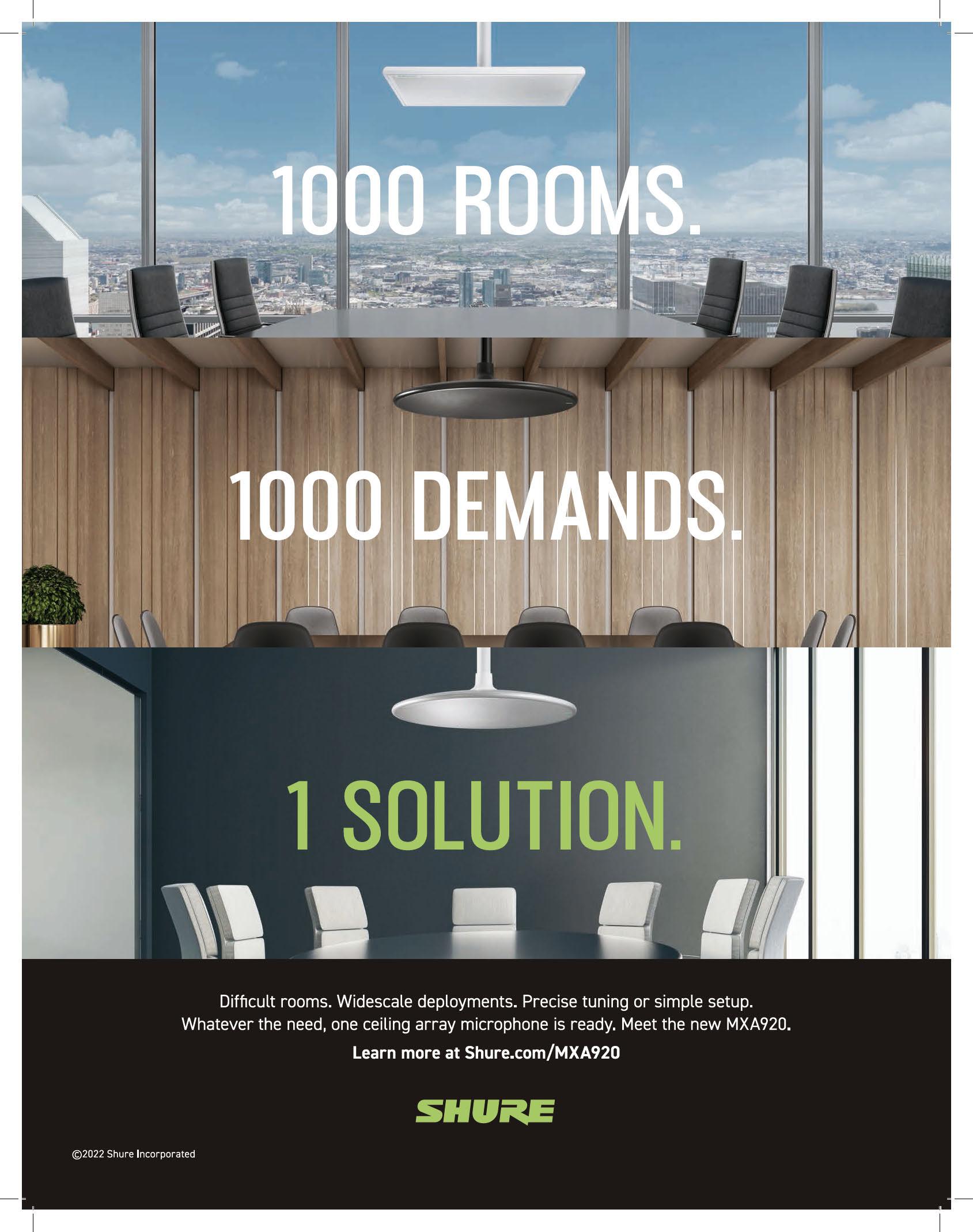
AVIXA has released its Image System Contrast Radio (ISCR) standard, which defines accept able minimum contrast ratios for AV pre sentation systems relative to their stated purpose or application. The standard replaces the Projected Image System Contrast Ration (PISCR) standard published in 2011, which applied only to projection.

As direct-view displays became more prevalent, AVIXA assembled a task group to assess the techno logical characteristics of direct-view displays to determine whether the differences in technologies would affect how image system contrast was assessed. The task group concluded the measure ment used in the original PISCR standard was equally
appropriate for direct-view displays.
“Presentation technology has fundamentally changed since the original PISCR standard was released,” said Jonathan Brawn, CTS, principal, Brawn Consulting, and co-chair of the standard’s task group. “Today, direct-view technologies like very large format LCD, LCD video walls, and increasingly dvLED have not only maintained being mainstream, but are now the dominant technology in most instances. This drove a true need to update the original PISCR standard to reflect current technology.”
The new ISCR standard is designed to facilitate informed decision making for projector, screen, and direct-view display selection relative to location and stated purpose. ISCR’s four contrast ratios are based on
The Sustainability in AV (SAVe) nonprofit organization launched its first SAVe Cer tification Program in June in partnership with Washington-based AV integrator, Tempest Technologies.
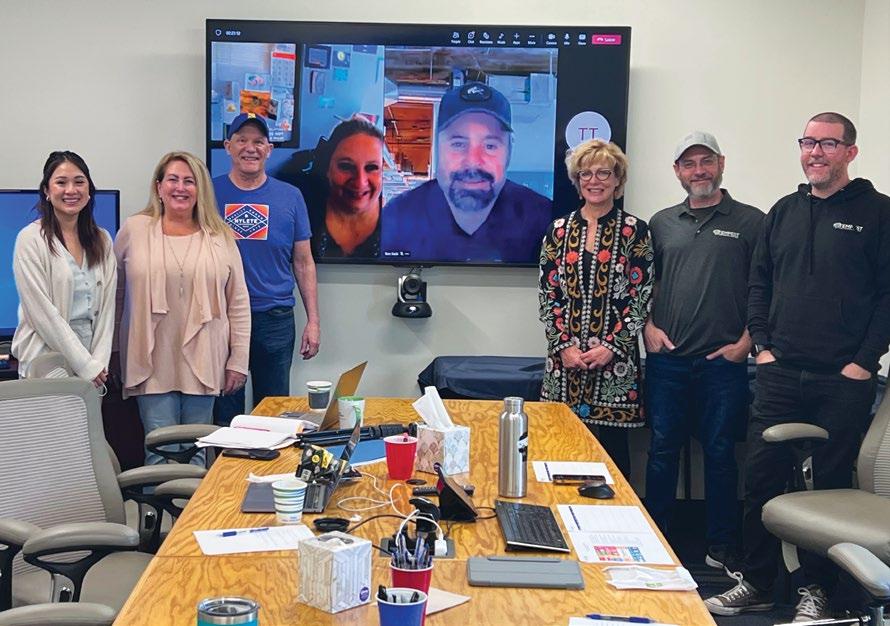
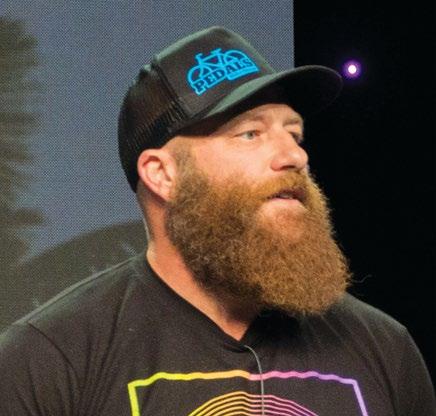
“As an integration company, we are aware of the waste our industry generates,” said Debbie Wil liamson, owner of Tempest Technologies. “This is about more than recycling. It’s about what we can do daily and the influence we can have on our clients, customers, and partners. It’s about the legacy we leave for future generations. Becoming SAVe Certified is part of our effort to take that commitment a step further.”
The three-part, one-day SAVe certification program includes an educational session, work shop, and assessment. The outcome of the process is an actionable strategy to make progress toward achieving the 2030 Sustainable Development Goals (SDGs), a shared blueprint for sustainability endorsed by all 193 members of the UN General Assembly, including the United States.
During its SAVe Certification session, Tempest Technologies chose specific SDGs that align with its business model and strategy, community role, and employee passions. The company also identified particular tactics to execute to advance the enumer
ated SDGs, and laid the groundwork to formalize an actionable strategy for implementation, including metrics and reporting.
Once SAVe Certified organizations have begun efforts to advance the SDGs, they keep in regular contact with SAVe, sharing their progress and challenges with the larger SAVe community, taking advantage of SAVe’s library of educational resources, and spreading the word to their colleagues, partners, customers, and other stakeholders.
“SAVe provides organizations a vehicle to channel their commitment and passion into action,” explained Christina De Bono, founder of SAVe. “And by that we mean specific, targeted efforts that yield measurable results—all on a company-by-company basis.”
passive viewing, basic decision making, analytical decision making, and full-motion video content viewing requirements Plus, the metrics (contrast ratios) and classifications (viewing categories) in the ISCR standard may be used to establish design criteria for new systems.
“This standard helps our industry to address our customers’ needs,” explained Justin Watts, CTS, senior AV design engineer, and co-chair of this standard’s task group. “In new systems, we can deliver a superior experience by providing display solutions that meet or exceed the performance requirements for the core applications we represent. It’s also a powerful tool for existing systems, where we can evaluate their perfor mance and provide sometimes needed justification for updates, upgrades, or changes to environment to maximize investments.”
Based in Las Vegas, Origin Acoustics is helping its community by supporting Save Red Rock’s “Make It Rain” Cloud Seeding Project to pre serve, protect, and improve the Red Rock Canyon National Conservation Area. Save Red Rock is partnering with nonprofit organization DRI to fund a cloud seeding program that will augment precipitation in the Spring Mountains, helping to replenish the aquifers within the area.
The partnership is working to alleviate some of the devastating effects of drought by stimulating additional snowfall in the winter and rainfall in the summer from naturally occurring storm clouds in the area. Cloud seeding is a safe and effective method used worldwide to enhance precipitation. The nonprofit is hoping to raise $150,000 through its “Make It Rain” community crowdfunding campaign toward the multi-seasonal cloud seeding project.
“Business has been good to me and it’s important to give back,” said Jeremy Burkhardt, cofounder, Origin Acoustics. “I’m supporting Save Red Rock in this cloud seeding project because I believe in helping the environ ment and the beauti ful canyon I love.”
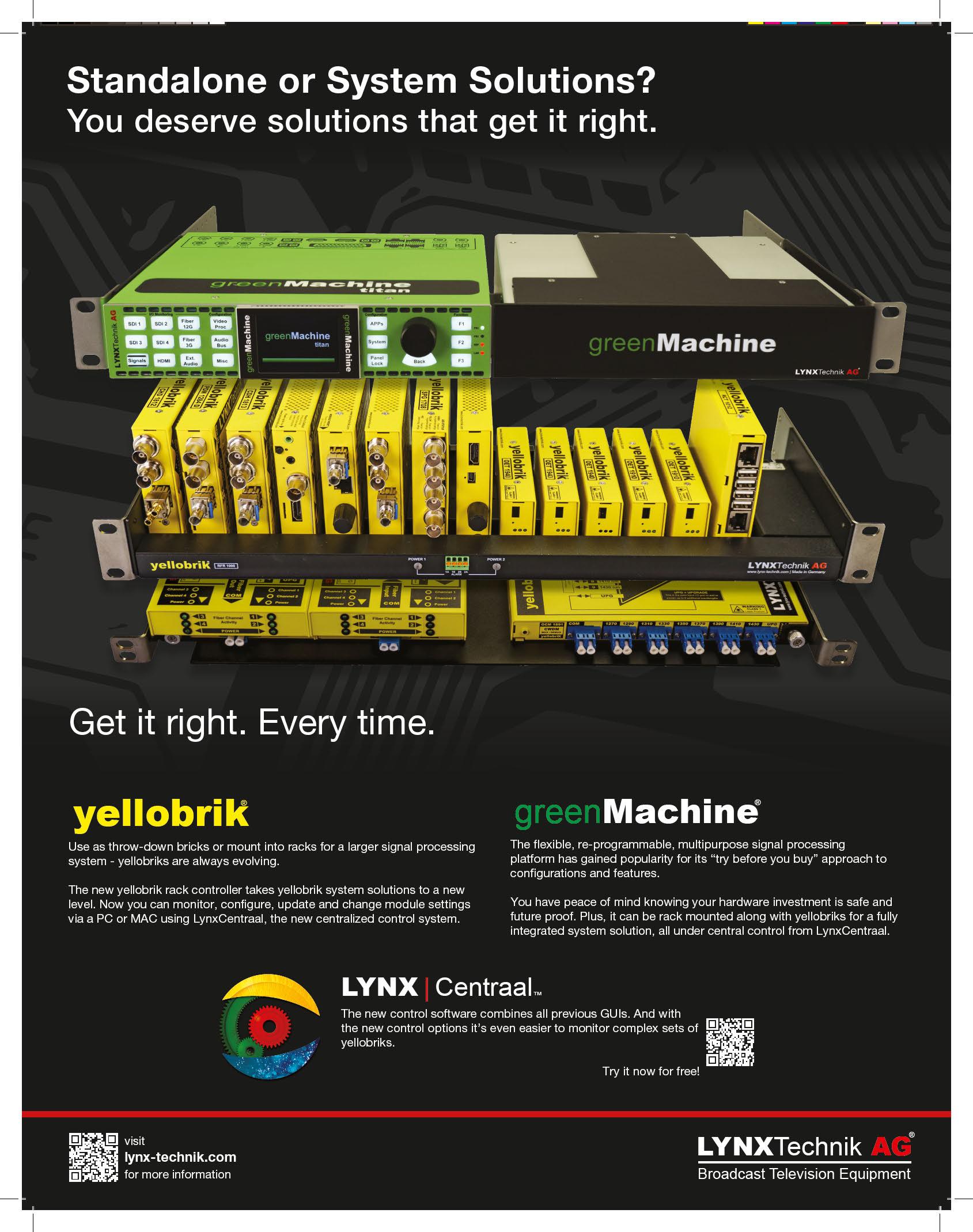
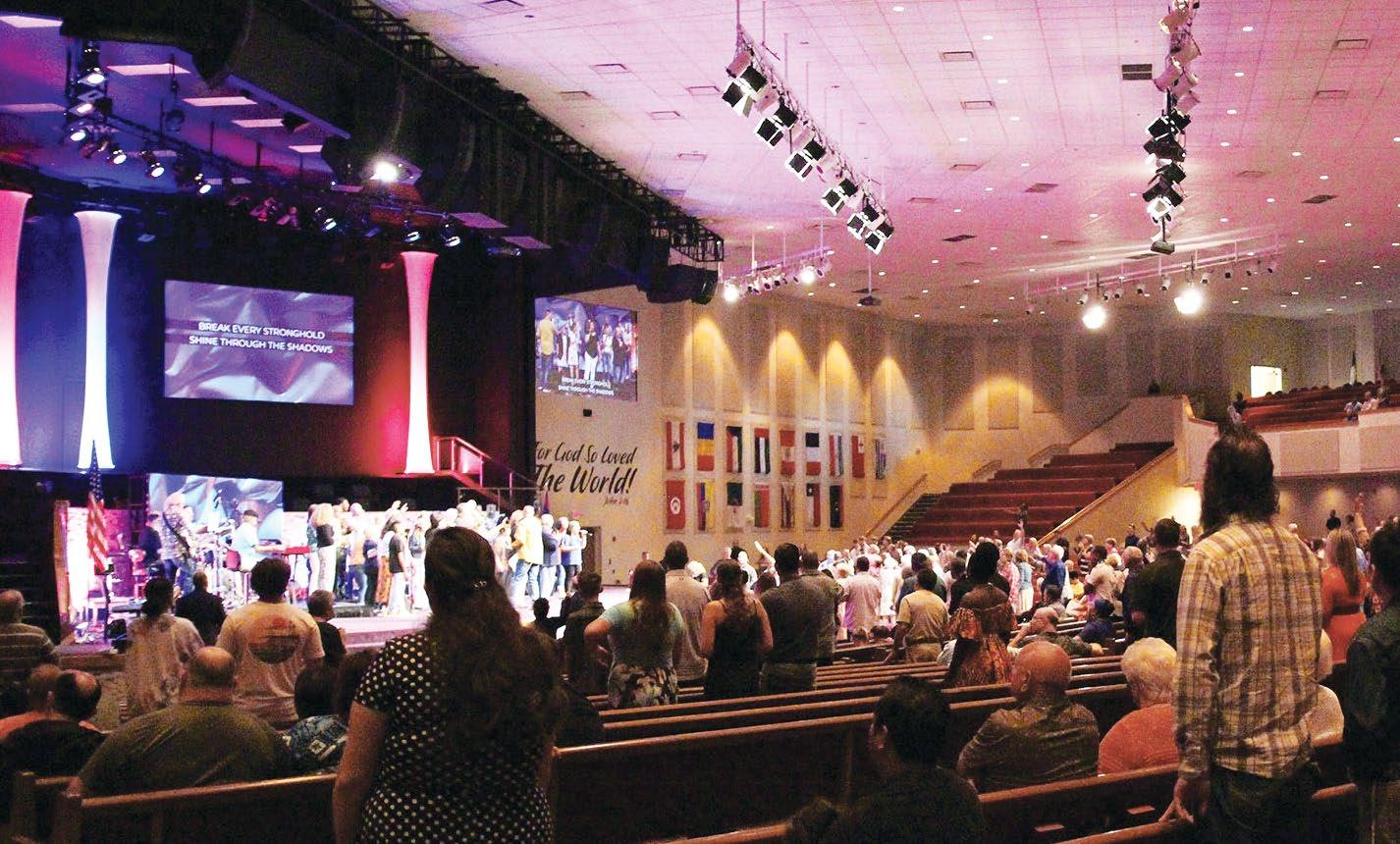
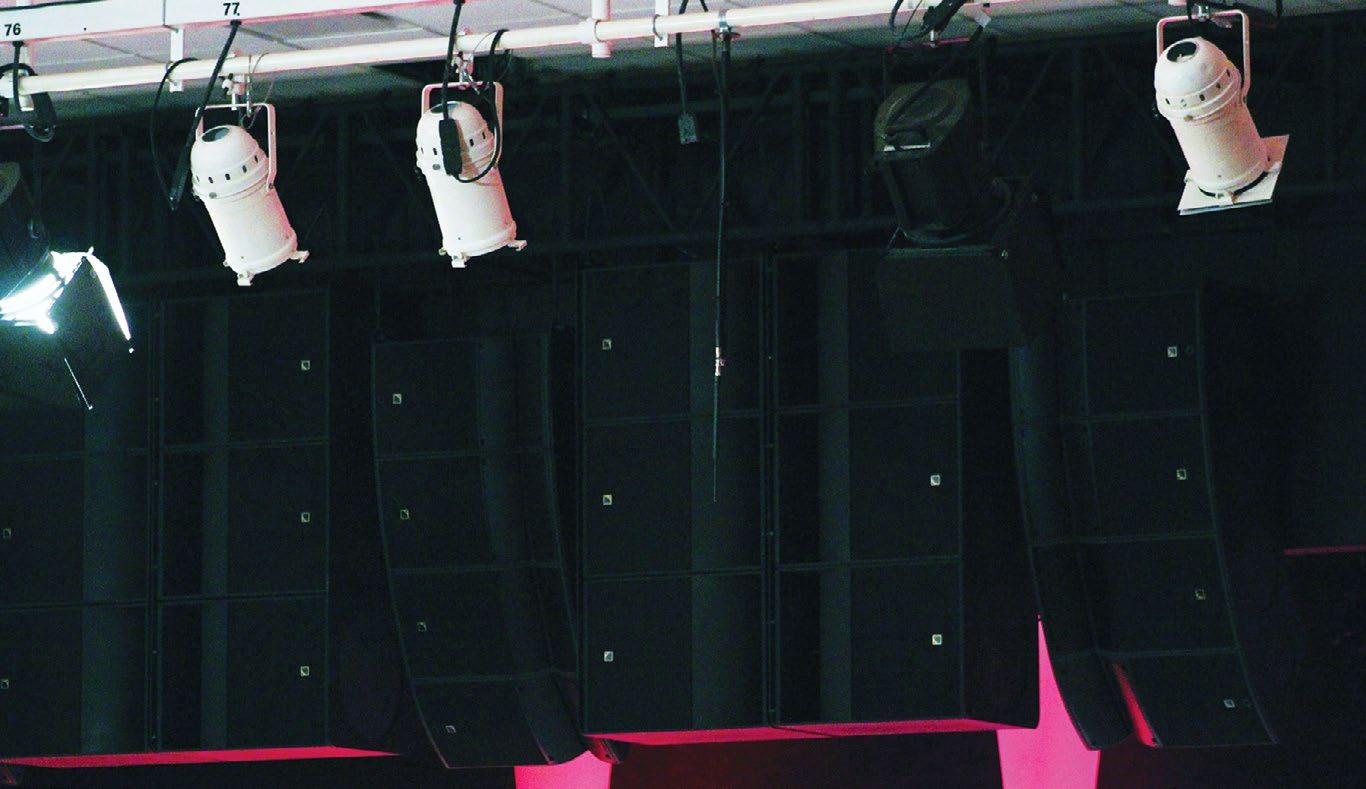
Sometimes, you just have to make a leap of faith. Princeton Pike Church of God, in the northern Cincinnati suburb of Hamilton, OH, has been around since 1928, and its worship spaces have grown over the years. As part of a sweeping upgrade of all its campus audio facilities, church leaders recently chose to adopt L-Acoustics L-ISA immersive sound technology for its main auditorium, which has almost 3,000 seats and has been using the same audio system since it opened in 2001.
“The system we replaced was the original install from 21 years ago, and we wanted something forwardthinking enough for the next two decades—not ‘bleeding-edge’ technology, but proven state-ofthe-art, which is what L-ISA offered us,” said Eric Chancey. production director. “We also didn’t want to look back and think we’d missed the boat. The difference in cost between the L-ISA-based design and a standard left-right stereo system for us was barely five figures. Our church board looked at the numbers and realized that this is where church sound is going. We didn’t want to be a few years down the
road asking ourselves why we didn’t do this.”
Chip Self, owner and CEO of Cignal Systems, the AV systems installation division of St. Louis-based Logic Systems that integrated the L-Acoustics system, presented the church board with several options. One possibility was installing the L-ISA loudspeaker in a configuration that could be used in a conventional manner, with immersive implemented at a later date. “But I had a feeling that Eric and the church would feel good about going with immersive,” he recalled.
Installed earlier this year, the church’s new house sound setup includes seven Scene arrays, the center most five each being comprised of three A15i Focus flown over a single A15i Wide. These are flanked by two more Scene arrays of three smaller A10i Focus over one A10i Wide, with Extension arrays of one A10i Focus over two A10i Wide hung even farther out. All A15i and A10i systems are suspended using customengineered and fabricated Logic Systems exoskeleton plate systems.
Additional loudspeaker systems include left and right out-fill arrays of two A15i Focus over two A15i Wide, 13 ultra-compact 5XT coaxials spread out across the stage lip for spatial front-fill, five X12 stage wedges, 12 flown 12KS21i subs, and 12 LA4X and seven LA2Xi amplified controllers. The setup is controlled via a new L-ISA Processor II that was purchased with a standard 16-output licensing level to best match the church’s relatively modest produc tion needs, as well as significantly minimize the cost of entry into an
immersive system.
Other new sound systems were installed in the church’s gym (six A15i Wide, two SB28 subs, one LA12X), youth center (six A15i Wide, two LA2Xi), chapel (two X12, one LA2Xi), and choir room (two Syva, two Syva Low, one LA4X).
Onstage, a pair of KLANG:vokal 3D in-ear monitor mix processors provide up to two dozen individual mixes at 48 kHz and 96 kHz via KLANG:kontrollers for wireless IEM monitors. “This was a huge leap of faith into immersive sound,” said Self, “not only the L-ISA-controlled PA system but also the KLANG 3D monitoring. Moving into immersive with one system is a huge undertaking, particularly for a house of worship, but to do so with a second system is really taking on a lot—they literally went from mono to the cutting edge of sound.”
Self is pacing the training for the church on both systems. “We are easing into what is a big tech change for the church, but we’re also finding that the tech staff loves it,” he noted. “On one level, it’s more complicated, but on another level, they’re finding that they don’t have to make allowances for the elements in the sound, such as carving out EQ for certain things. With L-ISA, everything has a place. As a result, volunteers are finding it easier to mix. There’s way less use of EQ and dynamics, and the sound breathes more.”
Chancey said L-ISA put Princeton Pike Church of God on a path to the future, but also fit all the church’s physical needs. “We have a large, wide stage and a large, wide seating area—and L-ISA helps us localize sounds within those spaces,” he explained. “The same goes for using KLANG monitoring. Once you’ve been able to mix in that kind of environment, it’s hard to go back to conventional stereo sound. We were a little apprehensive about going into immersive sound, but now that we’ve experienced it, L-ISA has made a believer out of me.”
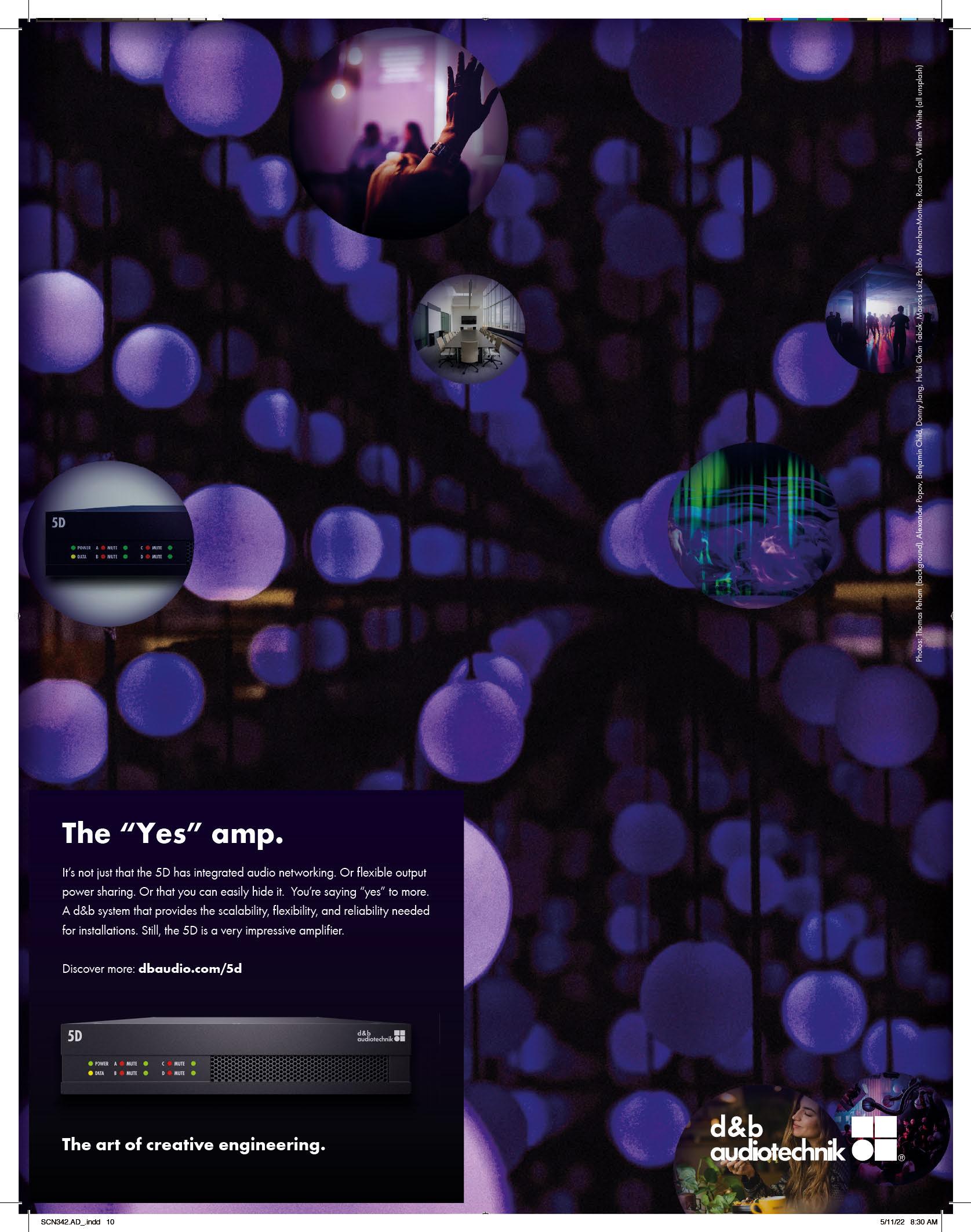
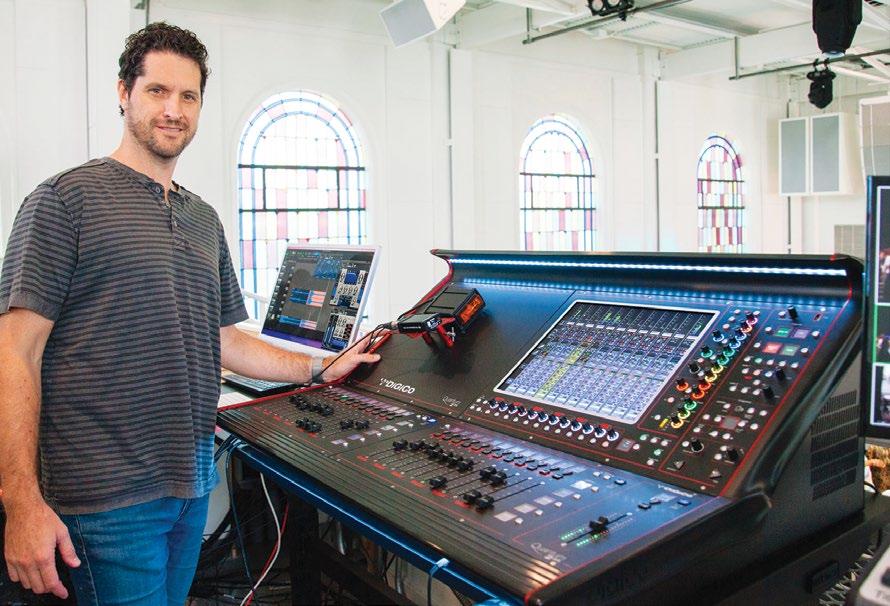
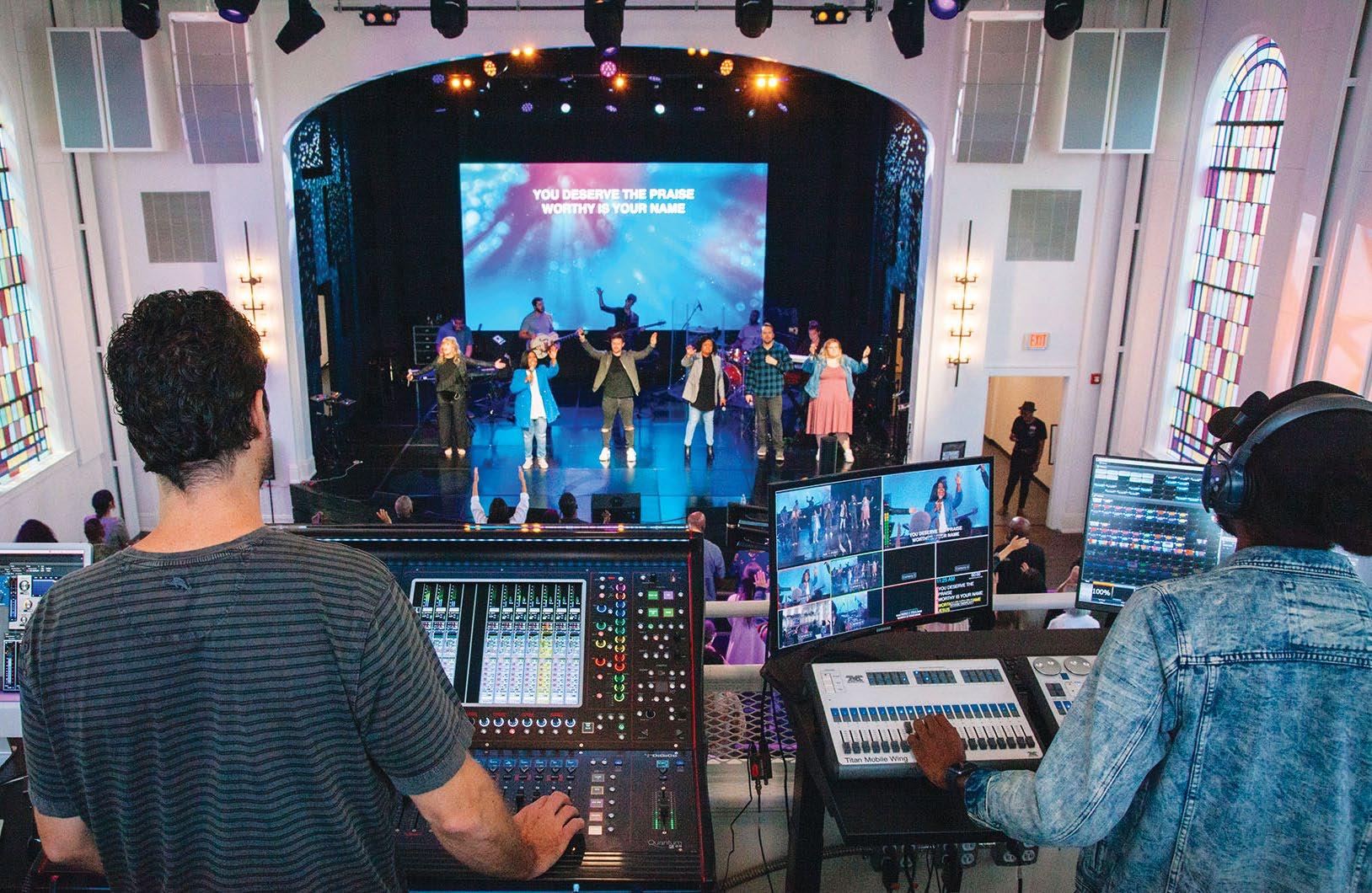
In recent years, the push toward inclusiveness and diversity within worship communities has brought broader demographics under one roof. A good example of that is Nashville Life, the 10-year-old ministry founded by gospel artist and 15-time Grammy Award-winner CeCe Winans and her husband, Alvin Love II, and where their son, Alvin Love III, is now lead pastor.
While the church has been in existence for a decade, it has only this year found its own home, a newly renovated former church building in Nash ville’s Nolensville Road neighborhood, itself one of the region’s most diverse. Not surprisingly, Nashville Life also has a flexible set of audio solutions installed by locally based Blackhawk Audio.
The 350-seat facility includes a DiGiCo Quan tum225 console, buttressed with four Dante-enabled A168D stage boxes, along with a DQ-Rack in the amp room for switching and patching—all on a Dante network, as is the church’s new EAW KF810 sound system. In addition, a dozen KLANG:kontrollers, six
connected to Shure PSM 1000 IEMs and six hardwired IEMs for the band members, provide the church’s musicians and vocalists on stage with a customizable but easy-to-use monitoring solution at their fingertips.
Nashville Life is volunteer-driven, including Trey Smith, the church’s most experienced live sound mix engineer and one of three whose technical capabili ties range from expert to ambitious. “That’s why the Quantum225 was such a good choice for the church,” he said. “For those of us with experience in touring, we’re already familiar with DiGiCo, and if not, it’s such an intuitive, logically laid out console to learn. I was able to set the console up so virtually any user could walk up and start mixing—it’s that easy.”
The Quantum225 is also handling the church’s entire audio workload, from front-of-house to monitors—the 12 KLANG:kontrollers are connected via direct output from the console through a DMIKLANG expansion card that supports up to 64 input channels—to a separate bus mix for the church’s streaming audio. “It sounds complicated, and the console is maxed out, but the Quantum225 handles it all and is still simple for anyone to operate,” added Smith, who also tours as the FOH engineer for country star Thomas Rhett. “We have various instrument and vocal preset channels for whatever is needed each week. Everything is clearly laid out and ready to go.”
Rick Shimer, president of Blackhawk Audio, said
he’s in awe of the Quantum225 after installing it at Nashville Life. “This was the first time we’ve had DiGiCo on a Dante network through a DMI card, and the amount of flexibility is insane,” he said. “The Quantum console is handling four 16-channel A168Ds, a 48-channel DQ-Rack, 16 channels of stereo KLANG mixes, plus subgroups. It’s an amazing amount of I/O and it’s not even breaking a sweat.”
Smith said that he has also been integrating the Quantum Series desk’s Mustard processing into the mix. “I’m using it for group processing, as well as applying it to instruments like the drums, bass, and vocal mics, using Mustard’s unique compression and EQ to give them their own sound and color,” he explained. “DiGiCos are very transparent, so when you apply the Mustard processing, you can really hear what’s happening.”
Musicians and vocalists are able to integrate the use of the KLANG:kontrollers at their own individual paces. “Some of them have already been using the immersive and 3D capabilities, while others are still getting used to doing their own personal mixes, and we have the KLANG software on the laptop at FOH, so we’re ready to step in and help if necessary,” Smith said. “But the flexibility is there, too—everyone can lay out the soundscape they like best, not limited by what other platforms allow, and they can save that as snapshots, ready to recall as needed. It’s a very flexible system for a very diverse church.”
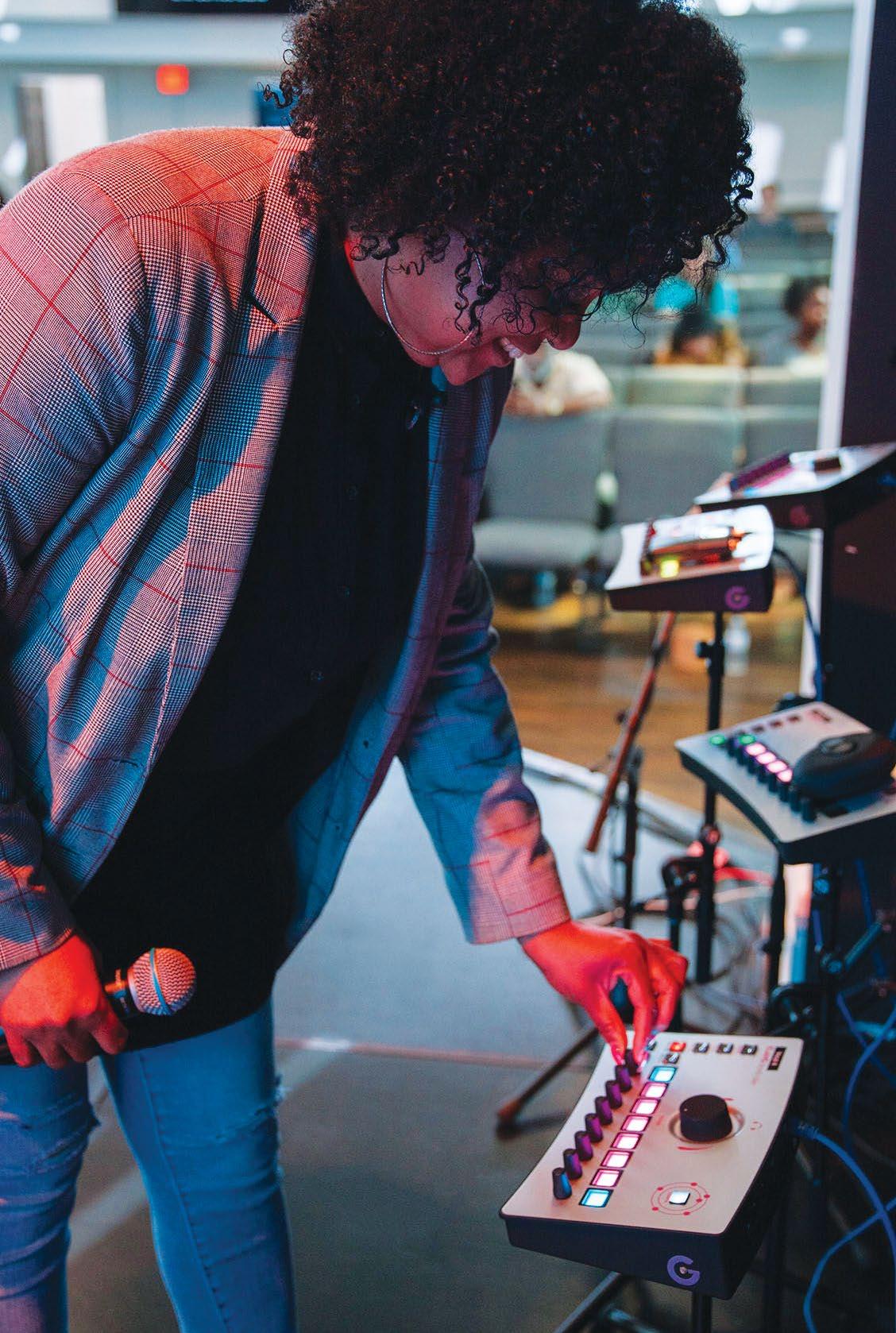
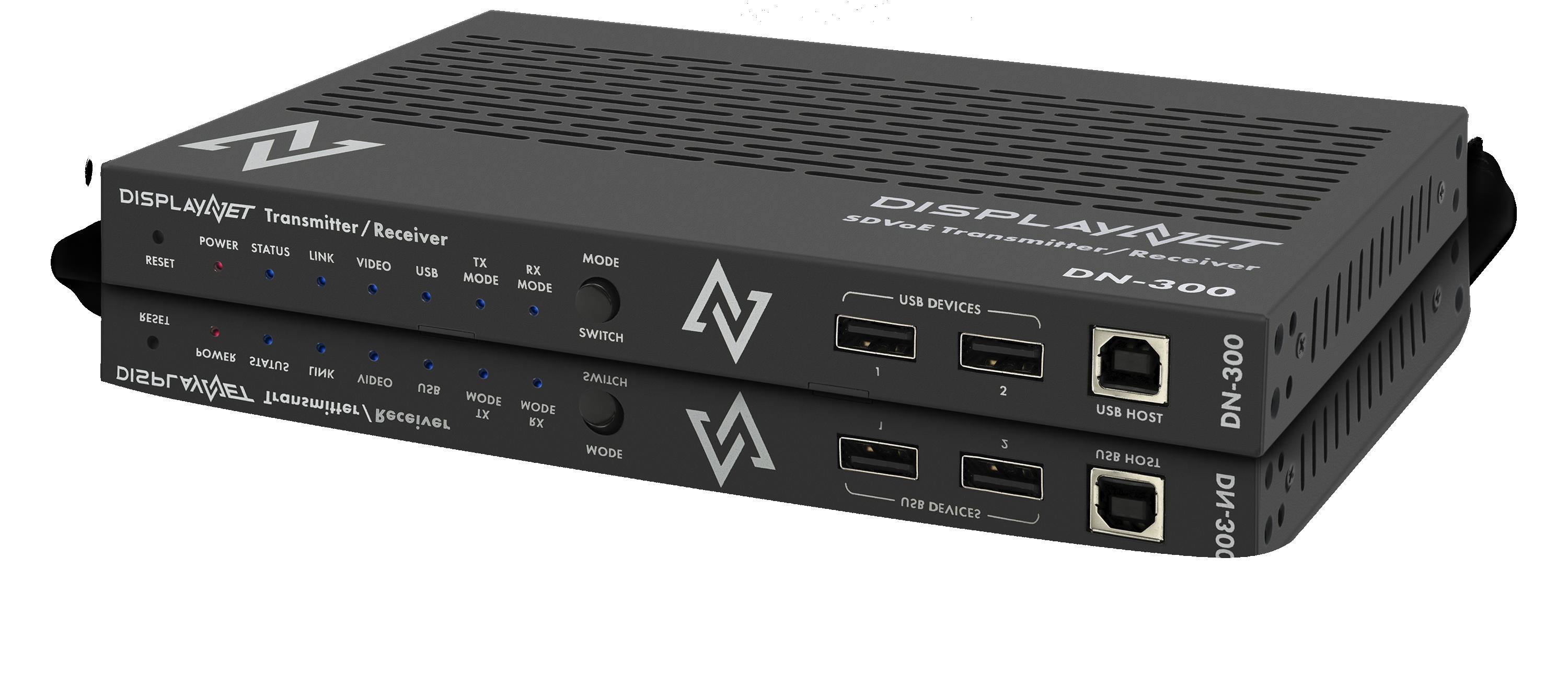

Renamed in 2019 for the boxing legend who hails from Louisville, the Louisville Muhammad Ali International Airport (SDF) is undergoing a multi-year, $400 million renovation effort including several projects across the build ing. As part of the effort, the airport built an $18.5 million Operations Center in August 2021, which featured multiple upgrades to the airport’s security and communications systems, including technology and products from AtlasIED.
According to the World Airport Traffic Report, the airport is ranked the world’s fifth busiest for cargo operations; in 2019, before the pandemic, more than 4.2 million passengers traveled through the airport. Operating the airport requires a massive logistical presence, and communications within the building is essential in helping personnel to direct resources and to connect people during routine operations and emergency situations.
The Operations Center serves as the nerve center for all airport operations, and includes an around-theclock communications hub and team. The center allows operations, communications, and security staff to continuously monitor and respond to any operational aspect that may arise, including communicating with internal personnel or directly with visitors over the public-facing paging system. If anything happens on the airfield, terminal, baggage claim, drop-off, or parking lots, all communications activity arrives through the center. From standard travel reminders to flight updates to forgotten belongings left at security checkpoints, the Operations Center team helps connect the right people to act quickly under any circumstance.
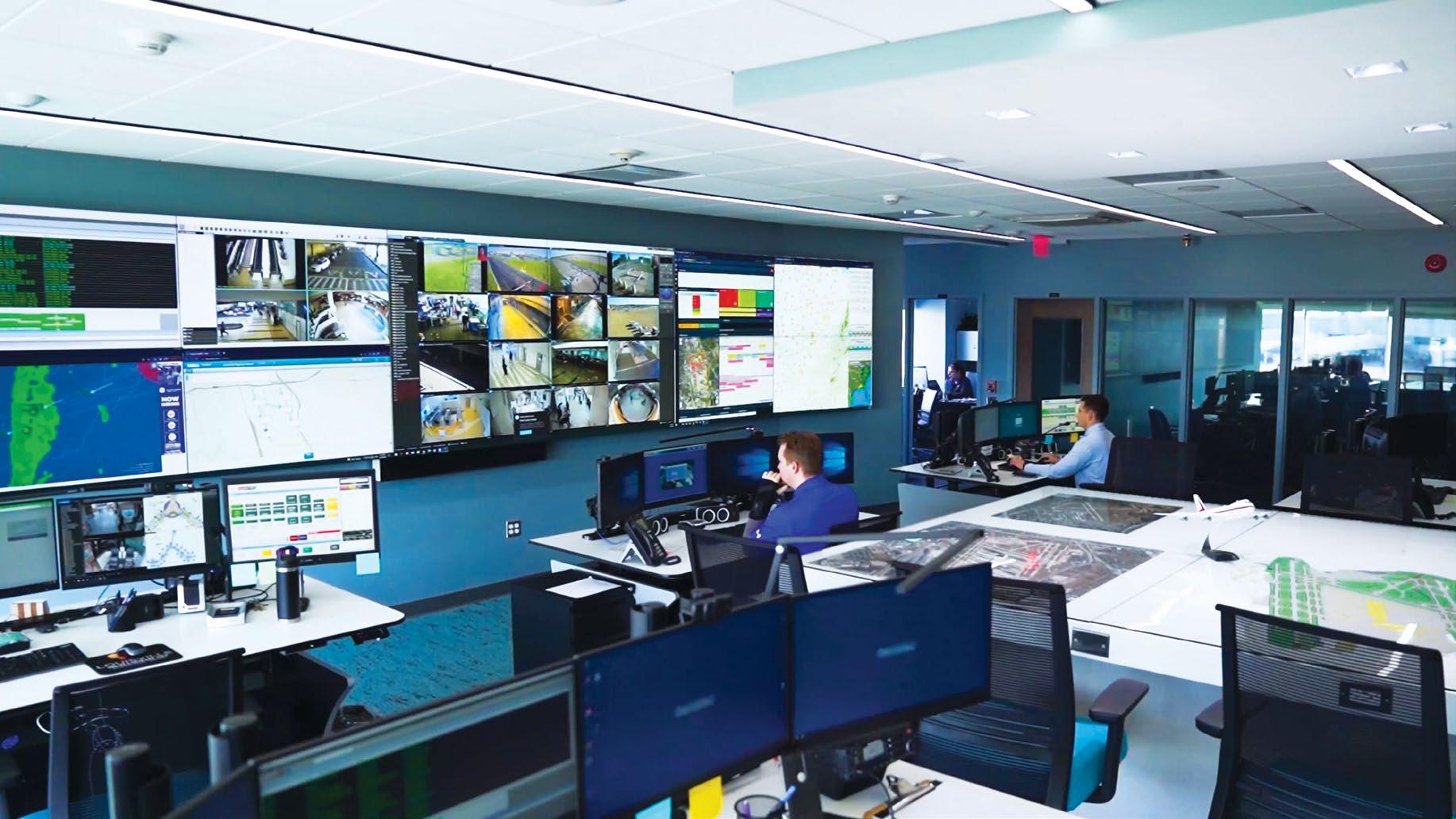
“The Operations Department is crucial to the airport, and we’ve worked to assemble the best team
and given them the best tools, resources, and technology to do their job,” said Dan Mann, executive director of the Louisville Regional Airport Authority.
“With the opportunity to integrate the latest and greatest technology and capabilities from companies like AtlasIED, I’m confident our new Operations Center, our staff, and technology deployed in the airport is best-in-class in the industry.”
SDF installed an array of AtlasIED products at key areas throughout the building to give staff convenient access. At the heart of the airport’s new communica tions system is the AtlasIED GLOBALCOM Enterprise Communications system, which allows the Operations Center team to connect a variety of devices or end points to the central network. The robust GLOBALCOM platform manages all of the audio and connects into visual communication feeds from around the airport, sending and receiving media from across the airport while bridging between multiple network protocols.
The system includes an ACS controller, a softwarebased network appliance that controls the flow of communication traffic. It also serves as a gateway for external I/O devices, VoIP telephone systems, and analog audio to be incorporated into the ecosystem. It
provides intelligible two-way talkback between devices, offers record and playback, features advanced scheduling to plan announcements, automated zone-specific bells or tones, and can automatically adjust audio volume levels based on real-time environ mental noise during busy or slower times at the airport.
The SDF team also integrated AtlasIED’s lifeline announcement controller that meets compliance requirements for life and safety emergency notifica tion systems. The unit performs overall supervision of the entire system of emergency communication stations, digital zone manager amplifier units, and other network peripherals—and provides reporting of equipment alarm conditions. Failover capabilities ensure that messages, instructions, and notifications are reliably deployed should a critical situation arise.
AtlasIED’s premium touchscreen mic station, IED550, is installed in the Operations Center, while the other locations use the IED528 mic station. At ticket counters, gate podiums, and on the walls at gates, airport personnel can easily access and use the IED528 to report issues or incidents, or trigger announcements and messages, such as a live or recorded page to communicate a specific gate or terminal, to certain zones.
To support the GLOBALCOM ecosystem, the Airport installed AtlasIED in-ceiling speakers, digital power amplifiers, message servers, and other network peripherals to help complete the system.
Using GLOBALCOM, the operations team can communicate with visitors when needed at the right location to create a more enjoyable experience for visitors, from the parking lot to the gate.
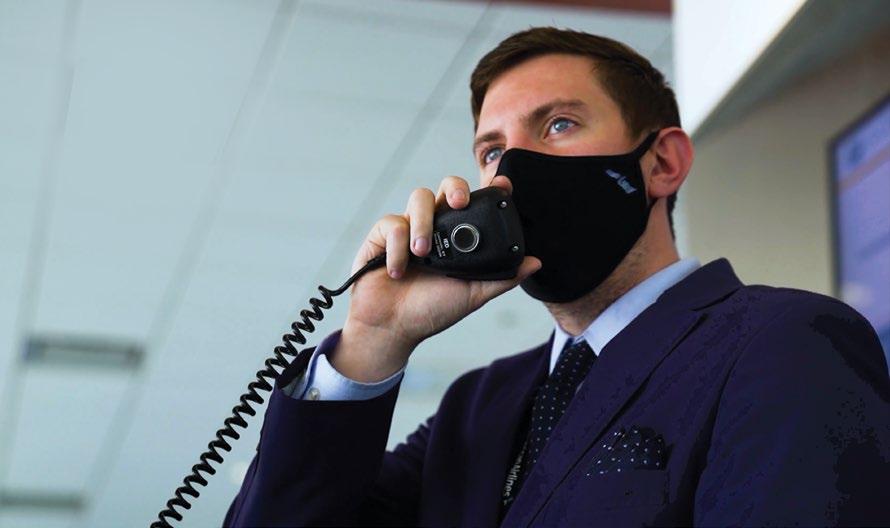
The AtlasIED GLOBALCOM engineering and support team, also located in Louisville, shares a community pride as well as a unique collaboration for the international airport. AtlasIED continues to work with airport personnel to test its technology and products. The proximity to the airport also has benefitted both organizations, as AtlasIED can quickly respond with support and provide personalized training to SDF personnel when needed.
“As the airport’s needs evolve, AtlasIED and the GLOBALCOM system will scale with it,” said Charles Kowalksi, domestic sales operations manager, AtlasIED. “We have formed a special, symbiotic relationship with SDF, and we look forward to collaborating with them using our latest technology to help them meet their goals in the years ahead.”
“We want to be the best airport in the country, and we try to not be too humble about the fact we want to be the best,” Mann added. “When your namesake is Muhammed Ali—the greatest of all time—it’s some thing that we aspire to. I’m confident our new Opera tions Center puts us at the forefront in the industry.”
As one of the largest and most comprehen sive universities in New York, the Univer sity at Buffalo is the flagship university of the SUNY system. The research-intensive univer sity hosts a wide variety of programs for its 32,000 students, including medicine, pharmacy, and law. When the university needed to enhance its highlevel classroom and campus dining display technol ogy, it called on Audio-Video Corporation, based in Albany, NY, to install Digital Projection’s Radiance LED video walls.
Housing some of the largest lecture halls on campus, and much of the core undergraduate STEM classes, the Natural Sciences Complex is an important part of the university. The two largest spaces in the complex, NSC 201 and NSC 225, have seating for about 350 individuals. With such large areas, the university needed a visually impactful solution that allowed the students to have a clear view of the instructional
materials from every location.
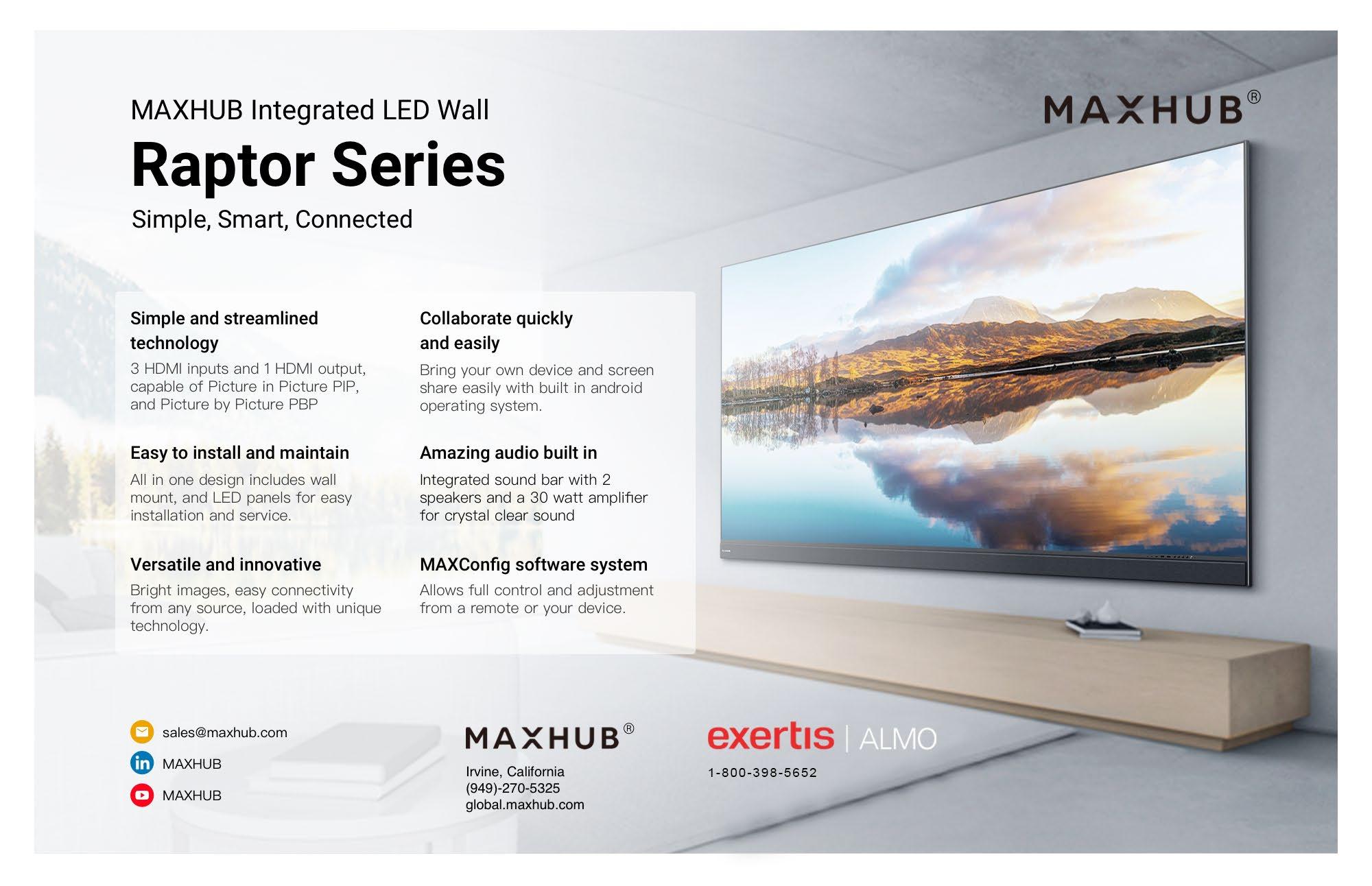
“We wanted to create a more innovative way of instruction,” explained Chris Clune, director of IT customer service, University at Buffalo. “Chalk boards and dry-erase boards were a big factor to how our faculty liked to teach, so we needed a way to incorporate them into some of the more modern aspects of instruction.”
The massive 32x9-foot central display in NSC 225 showcases course content in amazing detail for every seat in the lecture hall. Complementing this space, the 28x8-foot display in NSC 201 displays live, in-class notes from the professor, as well as supplementary sources with incredible clarity and vibrant colors.
“The new displays really allow us to make the most effective use of our instructional technology resources,” said Brice Bible, vice president and chief information officer, University at Buffalo. “We also wanted to create a learning experience in which site
lines were not an issue and that could easily be synchronous with our distance learning initiatives.”
The rooms’ large displays allow remote students to feel more integrated into the in-person class. Remote students are also more easily seen by students in the room. Plus, microphones placed at the tabletop allow for in-person students to be clearly heard by the remote audience.
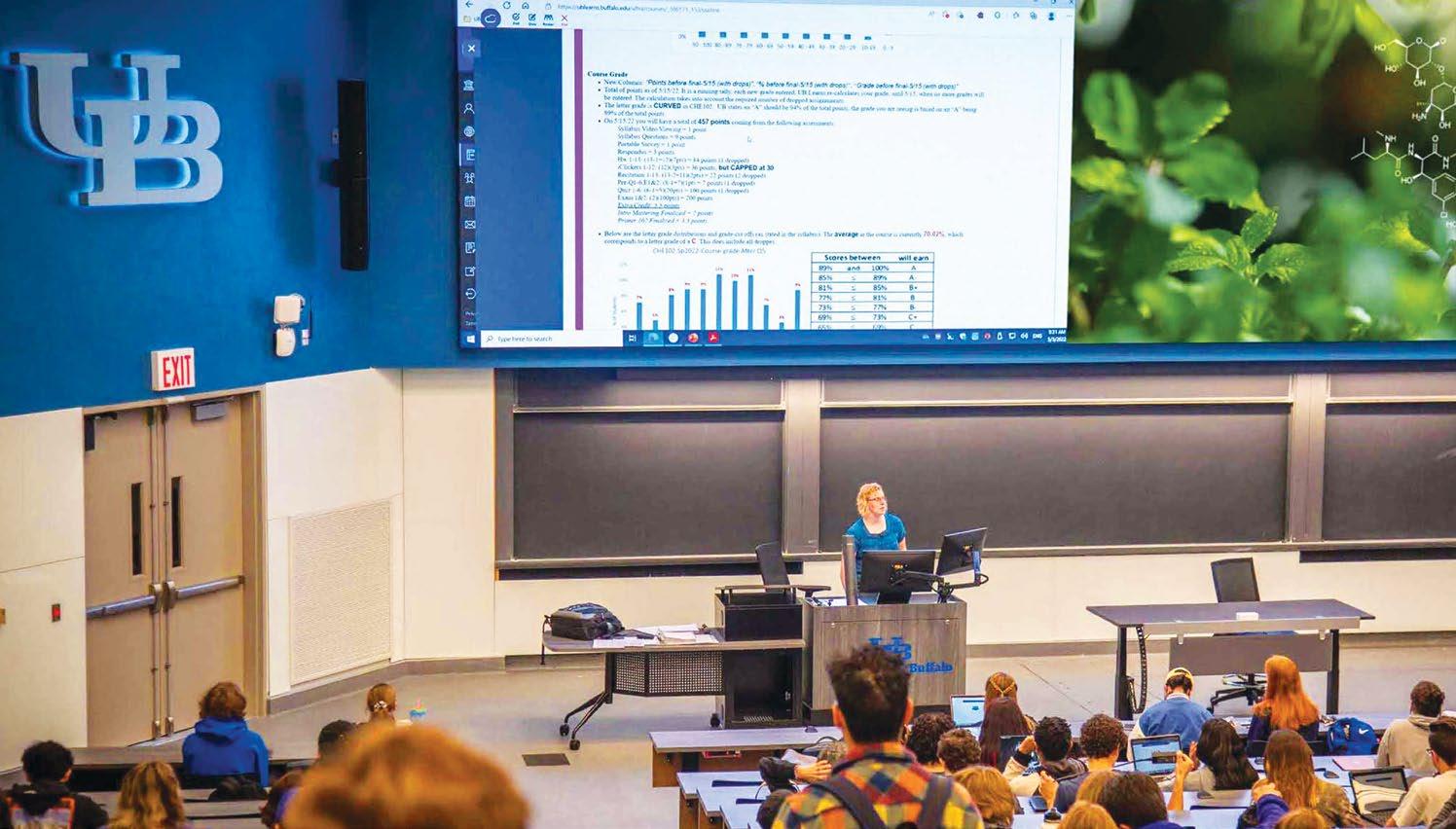
As part of the project, the nearby One World Café was also in need of an engaging display solution. The active student hub is a central point for meeting and studying along with a rich tapestry of international food options.
The new 16x9-foot display at One World Café has become very popular for all visitors. Set in an open space, the LED video wall displays important announcements to the students with top quality visuals for university programs, sports games, special events, and messages from the president.
Supply chain issues persist in late 2022. The semiconductor industry is a key example, where shortfalls in the production and delivery of electronic building blocks critical to numerous manufacturers create a chain reaction across a broad spectrum of industries, including professional audio hardware companies. Professional Audio Manufacturers Alliance (PAMA) mem ber company Audinate, developer of the Dante digital audio networking proto col licensed by hundreds of brands, has faced these issues head-on and offers an informed perspective.
“Unfortunately, the global supply chain is more fragile than many realize,” said Josh Rush, Audinate vice president of marketing. “In 2020, the fire at the
AKM semiconductor factory devastated the site and forced manufacturers to seek alternate solutions. On top of this, the harsh winter weather and electrical power crisis in Texas in 2021 caused many semiconduc tor fabrication plants to shut down—not to mention that much of the freight passing through Texas was delayed, again causing a variety of supply chain issues.”
Semiconductor availability problems are among the “most critical, complex, and dynamic commercial issues that the global Pro AV industry has had to grapple with,” Rush added. “Semiconductor analysts report that the global supply chain chal lenge is largely a demand issue more than a supply issue. It’s exacerbated in lowervolume industries like Pro AV because chip allocations are being diverted to large-vol ume clients/industries like consumer electronics, automotive, and military.”
Rush said the supply chain challenges facing Pro AV manufacturers got even worse in Q3 2021. That’s when
Number of
through
other
paid and/or
Non-requested distribution
non-requested
mail and outside
the supply of particular chips used widely in the AV industry “suddenly and nearly completely became unavailable.” Despite these challenges, Rush reported that Audinate shipped more units of its chips, cards, and modules (CCM) through May 2022 than through the same time period in 2021.
Audinate has leveraged its strategic partnerships with leading chip suppliers including Xilinx, NXP, and SkyWorks (formerly Silicon Labs) to the benefit of not only themselves but a swath of fellow manufacturers that incorporate the Dante protocol in their products. “Audinate continuously lobbies for increased allocation of chips on behalf of the over 500 Dante manufacturer licensees,” Rush explained. “This strategy has been successful in procuring inventory for several key parts for Audinate and its licensees.”

A push to replace hardware in use for specific tasks with software solutions that can run on general-pur pose computers and devices was one initiative under taken by Audinate to relieve its demand for specialized semiconductors. “The last couple of years has taught us all a lot of lessons, and we’re working to be as proactive as possible,” Rush said. “Global supply chains will continue to be a mission-critical priority for the AV industry in the years ahead. Issues like connectivity, interoperability, and standardized protocols are now more useful than ever—and are helping the entire channel create alternative solutions and address immediate customer needs.”
Average No. Copies
Issue During Preceding 12 Months No. Copies of Single Issue Published
to Filing Date
The August AV Sales Index (AVI-S) of 65.1 seemed surprisingly high given intensifying economic headwinds and recent months of lower scores. We predicted a reduction. Well, techni cally the September AVI-S is lower at 64.4. But the subtle, 0.7 point downshift should be seen more as a sign that the strength suggested in August is real.
“Pro AV continues to grow quickly, even as the overall economy wavers,” said Peter Hansen, econo mist, AVIXA. “The comments from survey respondents make it clear that returning to in-person remains a driver of spending, whether it is for live events,
corporate office space, hospital ity, or others. The slower growth observed in June and July seemed to suggest this tailwind was blowing itself out, but the additional data shows that is untrue. On the negative side, workforce difficulties and especially supply chains stood out as the biggest ongoing business challenges.”
A new factor was mentioned by a few commenters this month: exchange rates. For years, exchange rates among major currencies have been stable enough that their evolutions—even if significant over time—never stood out. That has changed.
This year, major currencies have shifted dramati cally, with a strengthening U.S. dollar the biggest trend. Higher interest rates instituted by the U.S. Federal Reserve Board make dollar-dominated bonds a newly attractive saving vehicle, creating demand for USD to purchase these assets. So far this year, the dollar has strengthened roughly 15% against the Euro, 12% against the Chinese Yuan, 26% against the Japanese Yen, and 19% against the British Pound.
These shifts substantially affect equipment costs. For the United States, it makes foreign-produced products cheaper. In Japan, where the Yen has weak ened so substantially, foreign-produced products are
more expensive. In the EU and China, U.S. products are more expensive while Japanese ones are cheaper.
Pro AV hiring improved again in September, as the AV Employment Index (AVI-E) accelerated from 61.0 to 62.2. This comes amidst a backdrop of serious difficulty, difficulty that centers on hiring as revealed in our just-released Q3 Macroeconomic Trends Analysis (META) report. These high numbers in the AVI-E indicate continued and perhaps marginally worsening condi tions for retention.
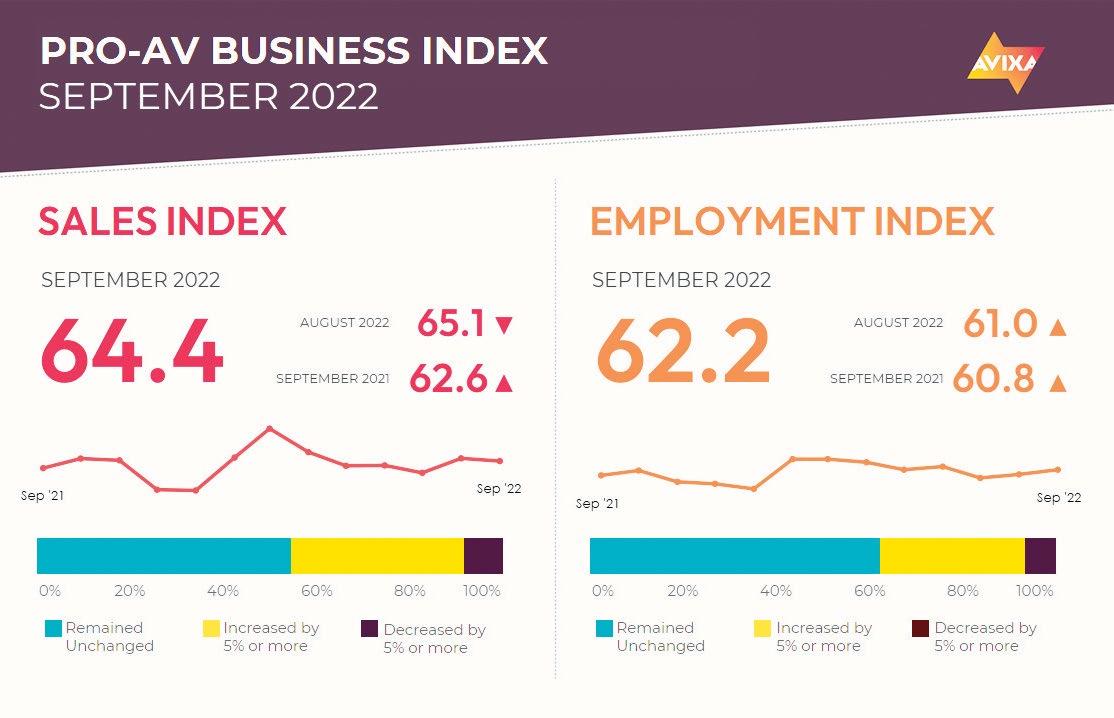
In the wider economy, there are now signs of deceleration amidst a still-hot market. U.S. job openings in dropped by just over 1 million in August (the most recent release), though the level remains histori cally high—especially when compared to the number of available workers. The U.S. economy added 263,000 jobs in September, a figure that is the lowest in a year but would have been high at any point in the decade leading up to the pandemic. To reiterate, the labor market is shifting, but demand for workers continues to substan tially outstrip supply.
The Pro AV Business Index report is derived from a monthly survey of the AVIXA Insights Community, a research community of industry members that tracks business trends in commercial AV. For more informa tion about joining the AVIXA Insights Community, visit www.avixa.org/AVIP
SCN: When did you establish Vanguard, and what are your responsibilities?
Michael Wiener: I founded Vanguard in 2012. I was on Fremont Street in Las Vegas where they had outdated printed signboards on the street. I thought that LED signage would be a huge improvement over unlit cardboard signage. I bought an LED sign to present the concept to the Fremont Street Association. Couldn’t get in the door, but we were then in the LED display business.
Vanguard is American owned and based. Our core values are stellar service, timely communication, and responsiveness. I am the CEO. Our three key employees—Max Perry, president, Steve McAfee, vice president, technical support, and Kelly Albano, operations manager—report to me. I have instilled into Vanguard the critical importance of responsive customer service and always being on the leading edge of new technology.
SCN: You recently introduced the Axion Acuity Series with virtual pixels. What makes this technology unique?
MW: Vanguard LED Displays won Best in Show at InfoComm 2022 [from SCN sister publication Sound & Video Contractor] for its Axion Acuity Virtual LED Series, which uses an algorithm to create virtual pixels that, in turn, allows for exceptionally small pixel pitches. The display we featured at InfoComm 2022 was P0.48! The technology allows the PCB board to “borrow” adjacent chips, creating four times the number of pixels compared to a standard SMD display, enabling the display to achieve exceptionally low pixel pitches at realistic prices.
Vanguard also showed its XR LED Studio Series directed at the movie, television, and streaming industries. Using the latest software from Brompton or Novastar, Vanguard can achieve exceptionally accurate colors demanded by the broadcast industry. The system features shutter sync, 3D color manage ment, and frame re-mapping. DCI-P3 attempts to standardize the colors used in the film industry.
Based on very precise scientific testing by a customer, Vanguard achieved “exceptional” DCI-P3 native diode color space accuracy. The grayscale achieved was also highly accurate.
SCN: Why are dvLED displays becoming increasingly popular for indoor installations?
MW: LED video displays have many advantages over projection and LCD, particularly in indoor applications. Their colors are rich, deep, and vibrant. True black is attainable. LED images are not affected by ambient light, indoor lighting, and entertainment lighting. LED displays require very little maintenance. Bulbs used in projectors are expensive and need to be replaced often. LED displays do not require much electricity. Pixel pitches on LED displays can now be as low as P0.5, and the latest LED technology has a failure rate of only one part per million.
Position: CEO and Founder
Company: Vanguard LED Displays
last many years. With LED displays, if a single bulb needs to be replaced, a back-up module with LEDs that match the original dye-lot is used to replace the module with the damaged bulb in seconds. The color integrity of the entire display remains unchanged.
SCN: For integrators and their customers, how important is choosing the right controller for video walls?
MW: The factors to consider in selecting a controller include connections needed (HDMI, SDI, DVI, etc.), video sources, latency, scaling, color gamut, frame rates, on-camera performance, and, of course, budget. At a very basic level, a controller is simply a passthrough from a video source to the LED display. But a controller can be responsible for scaling content, setting unique resolutions and aspect ratios, or providing multiple windows and/or layers of content on one wall or multiple walls simultaneously. The components on the controller we provide to the military are made in the USA.
SCN: What are some of the major differences required for military displays?
MW: Vanguard is the only company in the world that is TAA approved by Customs and Border Protection (CBP) to sell LED video displays the U.S. government—and any of its agencies including, obviously, the military—under the Trade Administration Act. This approval has been published in the Federal Register. The country of origin of the displays we sell the military is Taiwan.
SCN: How have supply chain issues impact Vanguard?
SCN: Does that mean LCD displays are on the way out?
MW: With respect to LCDs, I do not believe they are completely on their way out. If, for example, a single 55-inch diagonal screen would suffice, then LCD is the much less expensive option. From 108-inch diagonal and larger, LED, even though it is more expensive, is the better option for a number of reasons. For example, individual LCD displays have bezels or frames around them, which are very distracting. An LED display is one contiguous image.
Also, if an LCD display consists of multiple units, it must be replaced if an individual LCD screen fails. The colors on the replacement LCD will not match the other units. The color uniformity of the entire display is effectively destroyed. This is a huge risk to take, especially if the expectation is for the LCD screen to
MW: The scarcity of integrated circuit (IC) drivers caused many delivery delays in 2021 and early 2022. This situation seems to have resolved itself. The main supply chain issues now revolve around the availability of air and sea freight.
SCN: What new initiatives are we likely to see from your company?
MW: Vanguard’s track record clearly shows that we are always leading the way with new technology. I cannot predict what our new initiatives will be, but I assure you that Vanguard will be the first company in the industry to present them. I feel that it will take years for the market to fully absorb the technology we are presently offering, including Chip on Board (COB), Glue on Board (GOB Epoxy Resin), XR Studio Series, and Axion Acuity Virtual Series.

LED video displays have many advantages over projection and LCD, particularly in indoor applications.
Michael Wiener
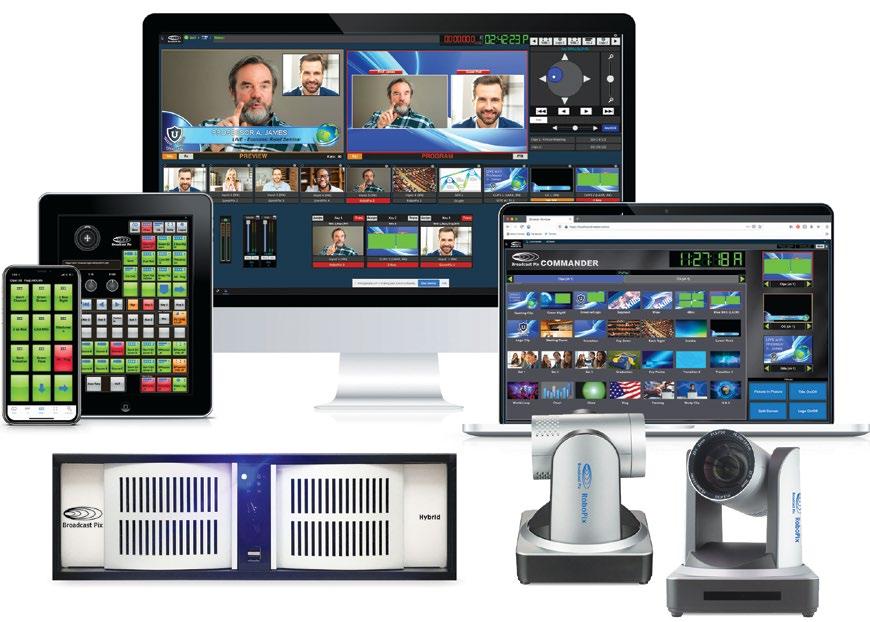 By Mark J. Pescatore
By Mark J. Pescatore
: How is Broadcast Pix celebrating its 20th anniversary?
Graham Sharp: We are still pretty much working remote as a company, so internal celebrations were somewhat subdued. However, it was a huge year for us as we transformed our complete product line to be software only, running on consumer-off-theshelf (COTS) technology. This also enabled us to create focused versions for market verticals, such as RadioPix, ChurchPix, MeetingPix, and StreamingPix.
: What are the advantages of an integrated production system?
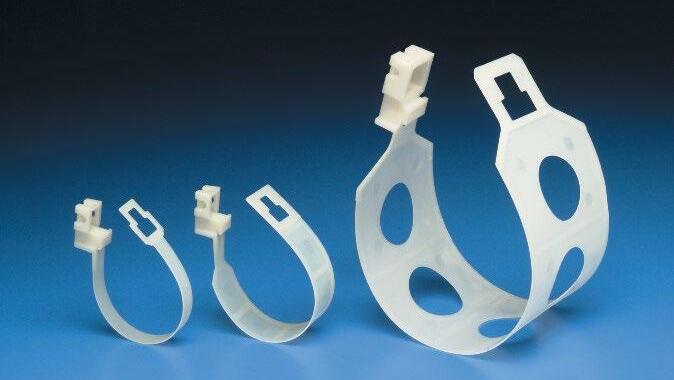
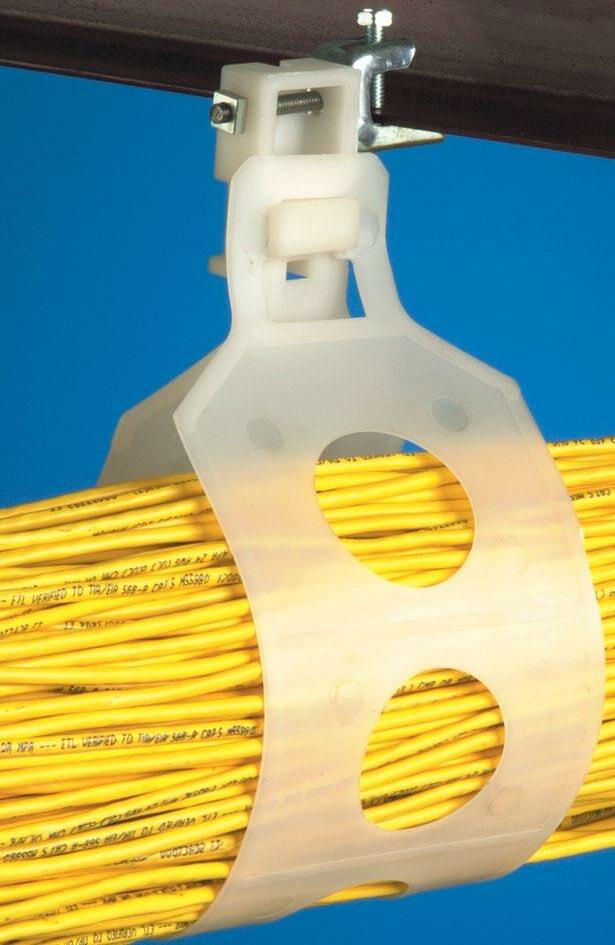
GS: Obviously, a big advantage is that everything you need is “in the box”—but having an integrated toolset brings huge operational advantages, primarily around ease of use and control. The tools are fully integrated into a single, easy-to-operate user interface, which can then be fully automated. These levels of control and automation cannot be achieved with individual production components.
: With so much touchscreen functionality in today’s production workflows, is there still a demand for traditional control panels?
GS: I would say yes—a touchscreen is fine for setup, but operators still love a tactile surface or control panel when they are producing a live show or event. Part of our success historically was our “hybrid” control surface, where we combined visual menus with buttons, so watch this space as we work on our next-generation control surfaces.
: There are a lot of built-in features in your systems, but what’s the one that customers tell you they love the most?
GS: I would say ease of use and configurability. We have 20 years’ worth of feature development, so everything you can think of, but making those features easy to find and intuitive to use is our real advantage and customers love it!
: How has cloud technology impacted your systems?
GS: We probably facilitated one of the earliest
remote productions about 12 years ago, when we worked with Swedish Television to remotely produce their soccer league. In that case, the production systems were in a data center and the cameras were remote. Today, our systems are software-based, have an abstracted network architecture, and can easily run in the cloud.
So, it’s not a technical issue, it’s more of a financial one. The cloud can work out to be very expensive for constant and intensive CPU usage— and high-bandwidth streaming of the result. It is much more cost effective to run the software on a dedicated server or in a private data center.
: Is visual radio (finally) gaining more traction in the United States, and how can Broadcast Pix help integrators deliver a solution?

GS: Yes, I think visual radio is finally getting traction. Our goal with RadioPix is to make it easy to buy, install, configure, and operate. It comes with everything in the box, preconfigured and ready to go. We have tried to make it as plug-andplay as possible. In terms of operation, we include a behavioral intelligence module where cameras can be controlled by a set of rules based on microphone activity.
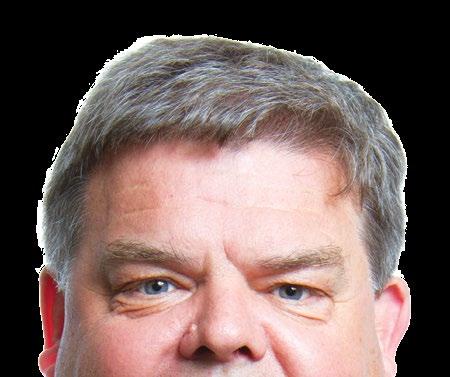
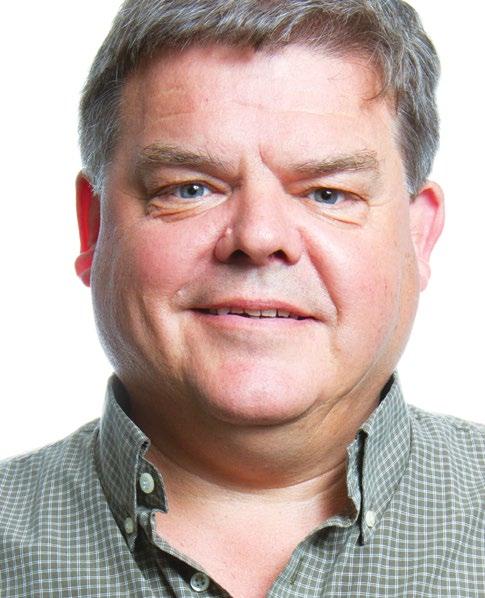
Position: CEO
Company:


Broadcast Pix
Ovetime: I love sailing—racing, teaching, and doing long-distance deliveries down to the Caribbean.
: What are some of the other products Broadcast Pix offers?
GS: We focus on IPS, that’s in our blood. Of course, we provide cameras and now we have a range of appliances for specific markets, but our DNA is integrated production systems—total focus.
: What new initiatives are we likely to see from your company?
GS: We have a very deep toolset which we have been developing for 20 years, so now our focus is improving ease of use with next-generation control and more automation.
: Where do you see the Pro AV industry heading?
GS: We see AV rapidly merging with broadcast. COTS and networks have become powerful and fast enough to process high-definition, high-quality video, so we can have the best of both worlds at a competitive price—the quality and standards of broadcast and the networking expertise of AV.
Industry veteran JOHN SMALL has joined ADVANCED SYSTEMS GROUP as solutions engineer. He is responsible for providing technical expertise on infra structure and workflows to clients in the Los Angeles area. He will work closely with client management and technical engineering teams to identify issues and find efficient solutions for media production environ ments. Prior to joining ASG, he served as a pre-sales engineer at Quantum, following a 16-year run in technical roles at CBS, most recently as director of technical operations.
As part of its strategic plan for growth in the Mid-Atlantic region, integrated solutions firm DANCKER has hired MARE REH to serve as managing director for architecture and design strategy and CORY BEAHM as director of strategic accounts. Beahm will focus primarily on demonstrating the firm’s value as an interiors integrator to prospective clients. Reh led new business opportuni ties through her expansive network of design firms and existing relationships within Steelcase, a leading manufacturer of furniture and space solutions. Beahm comes to dancker from Steelcase, while Reh most recently served as an A&D representative at American Office.
BRIAN TULLEY has joined DATAPATH as strategic procure ment manager. He is tasked with working with internal and external partners to secure the long-term availability of key, strategic electronic components required to support the company’s business objec tives. His responsibilities include strategic procure ment for a variety of key electronic commodities, such as FPGAs, memory chips, and circuit boards. Tulley has extensive experience in technology procurement, having held senior roles at companies including General Electric and Rolls Royce.
THE FARM AV has added two new “farmers” to the team: Denverbased DANA NICKEL and Los Angeles-based MATTHEW JENSEN. In their respective roles, Nickel and Jensen will be responsible for fueling the company’s growth in end-to-end AV expertise and services. Nickel has worked in a variety of capacities in the commercial AV industry for a systems integra
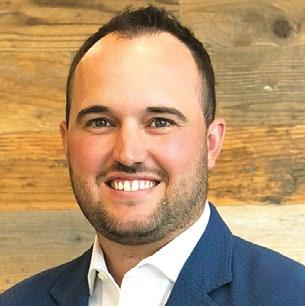
tor, rep firm, and several manufacturers. Jensen comes to The Farm with more than 20 years of experience in and around the music/AV industry in Los Angeles. He also ran Alliance Audio Visual Group (AAVG), a manufacturer-representative firm.


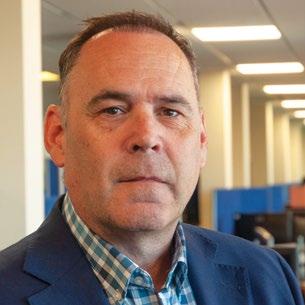
LIGHTWARE VISUAL ENGINEERING has added ROGER TAKACS as vice presi dent of education. He is playing an instrumental role in develop ing and growing business in the education channel. The hire is part of Lightware’s focus on building classrooms of the future. Takacs has more than 20 years of success in sales and executing strategic initiatives across several key verticals.
SCOTT LARGENT has joined MAXHUB in the newly created business development manager position for the U.S. Southern Territory. Largent will be respon sible for driving sales of MAXHUB LED displays and UC Series conferencing products throughout the four-state TOLA region of Texas, Oklahoma, Louisiana, and Arkansas. An industry veteran, Largent has in-depth knowledge of the AV/IT market, most recently serving as a regional sales manager for Optoma. The company has also welcomed AMIE FIPPS as director of marketing. In the newly created position, she oversees the company’s market ing plan and manages the marketing team. Most recently, she served as senior marketing manager, unified communications, for AVer Information.
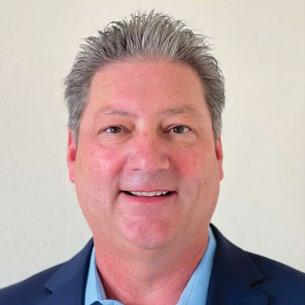
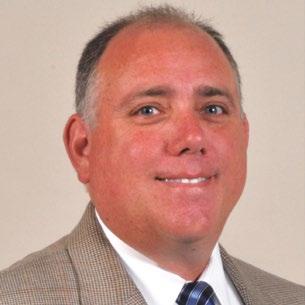
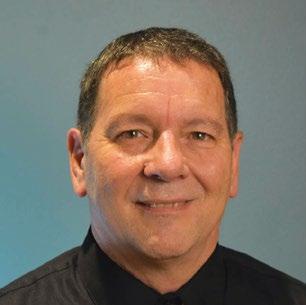
PEERLESS-AV has added TIFFANY KAUTSKY as director of business development for North America territories, including Canada and Mexico. Based in Southern California, she will cultivate new business opportunities and partnerships with OEMs, end users, architects, specifiers, integrators, and consultants, utilizing more than 13 years of experience in specialized solutions for emergent applications such as virtual production. AMY MOSS has also joined the team as regional sales manager, west. Based in Phoenix, she returns to Peerless-AV after 11 years, resuming a sales management role for nine states and Western Canada.


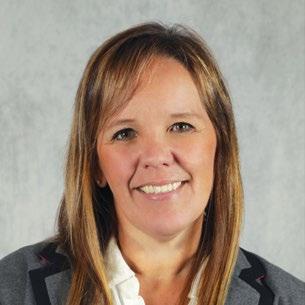
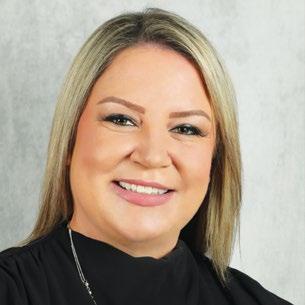
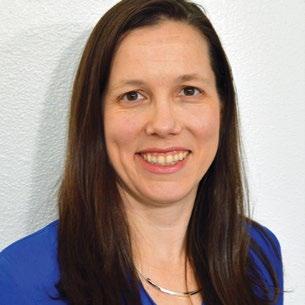

RTI has added industry pros THU LE and NICK ARRIAZA as regional sales engineers. They will focus on onboarding new dealers to RTI, assisting with training in hardware and software products, as well as guiding system design work. Arriaza will support dealers in the western and southeast regions, while Le will support central and northeast region dealers. Based in Southern California, Arriaza joins RTI with more than 12 years in the custom install channel, most recently as a sales engineer with URC. Le, based in Minnesota, has two decades of custom integration channel experience, including 10 years as a product manager with Xantech and eight in a similar role with Beale Street Audio.
A trio of leadership appointments at STREAMGUYS: EDUARDO
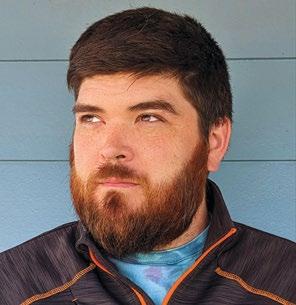

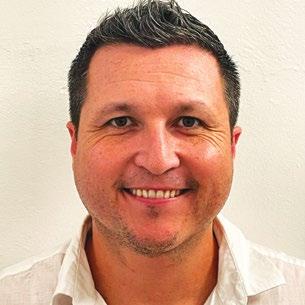

MARTINEZ and JESSE ORR have been promoted to vice president of technology and vice president of engineering, respectively, while TARA STRICKWERDA has taken on the role of director of customer success. Martinez has been a key contributor and leader at StreamGuys for more than 15 years, and will continue to oversee the planning, architec ture, and design of the company’s solutions. Orr oversees the company’s extensive infrastruc ture. Strickwerda, who joined StreamGuys last year, is tasked with identifying and meeting the needs of clients. She has more than 25 years of experience delivering solutions across multiple industries.
MATTHEW QUADE has been named CEO of TSL. CHRIS EXELBY, who was named managing director in 2007, will remain on the company’s board of directors as executive chair man, and will continue to work with TSL in a senior advisory role. Quade steps into his new position after working with TSL on a project basis for more than six years, including leading imple mentation of the company’s M&A strategy. He has held COO and CRO positions in a variety of service-based and manufacturing businesses.
 John Small
Mare Reh
Cory Beahm
Roger Takacs
Scott Largent
Amie Fipps
Tiffany Kautsky
Amy Moss
Brian Tulley
Dana Nickel
Matthew Jensen
Thu Le
Nick Arriaza
Eduardo Martinez
Jesse Orr
Tara Stickwerda
Chris Exelby
Matthew Quade
John Small
Mare Reh
Cory Beahm
Roger Takacs
Scott Largent
Amie Fipps
Tiffany Kautsky
Amy Moss
Brian Tulley
Dana Nickel
Matthew Jensen
Thu Le
Nick Arriaza
Eduardo Martinez
Jesse Orr
Tara Stickwerda
Chris Exelby
Matthew Quade
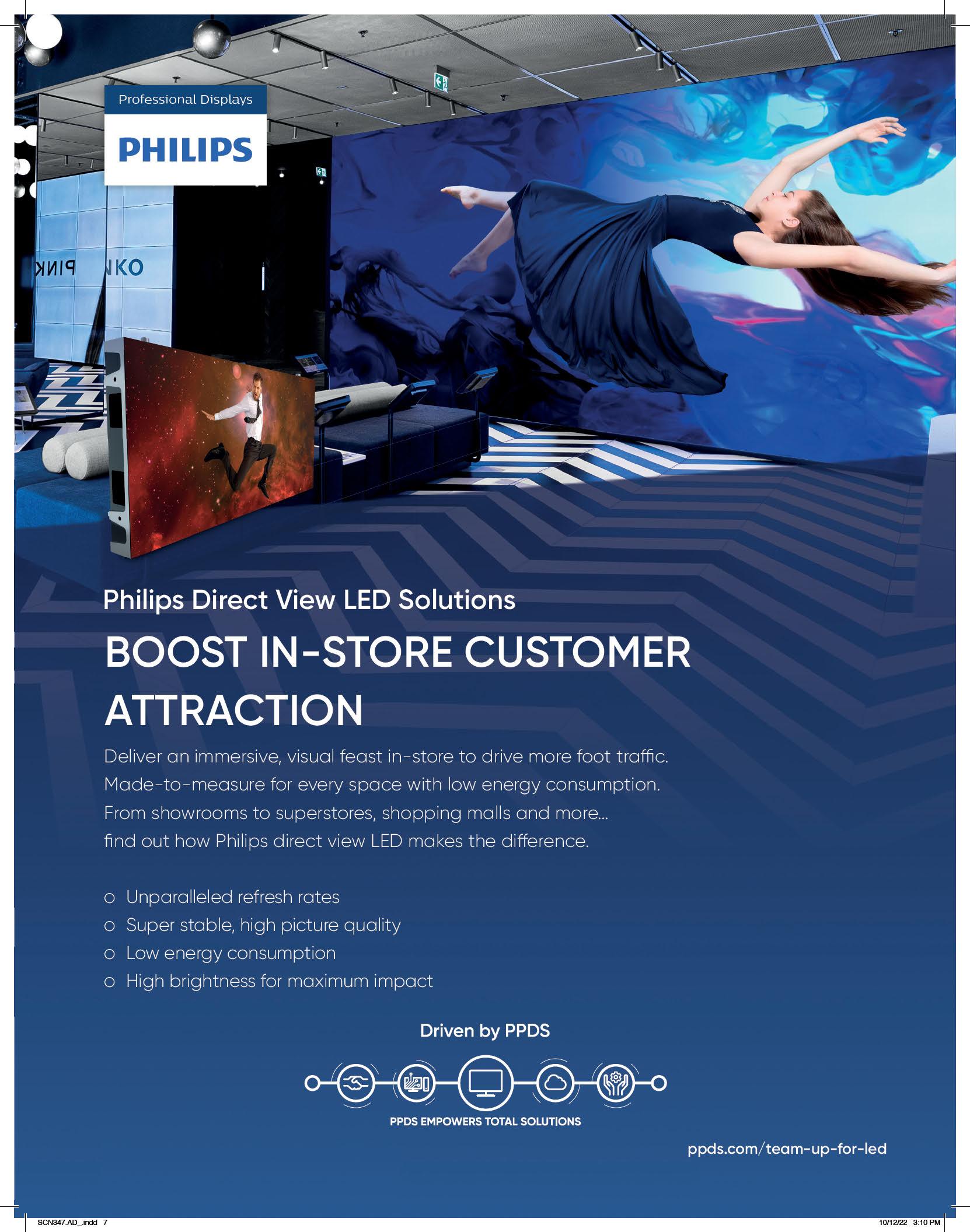
Sales, Engineering, and Operations: SEO. Not to shortchange administration, man agement, shipping, etc., but these are the three critical components of a successful Pro AV project. Frankly, although we are in the communica tions business, the lack of communication between these groups of dedicated individuals can often be described as the AV triangle of doom.
I am not talking about superficial talk between the group, I am talking about real communication. I define communication as a conversation between two or more wherein serious questions are asked—and there is serious thought taken between the time of the question and the answer. The sub-levels and context of the conversation are thought about; sometimes you may even juxtapose yourself with the other party to consider the ramifications of your response/decision and how it will affect the issue at hand, as well as your future relationship/communication.
I have observed some, shall I say, possibly selfish behavior from one’s group to the others. For example, in sales, well, they may press a little harder than they should for engineering to come up with a design, price, and proposal sooner than they are able. The result is often errors and omissions.
Engineering, well, we may take longer than we should for the design and proposal because it needs to be perfect in every way. That means taking into
consideration every actual and possible detail that may cause the system to not be perfect. In addition, you may not be in the same neighborhood as sales when it comes to the price. After all, we know what is best for the client, right? Engineer’s disease, a conversation for another day.
Operations, well, it needs to be installed and signed off during a specific time period in order for other projects to be installed. This may mean that some equipment may need to be replaced due to situations in the field, or connectivity may not actually follow the wiring schematics, etc. At the end of the day, from the proposal to the carefully engi neered design to the actual system installation, it may bear little resemblance to that original proposal.
Each participant is sure their ideas were better and/ or the absolute right way things should have gone. This is more common than most of us would like to admit— and as this builds up over time, trust can become an issue as well. The end result is reduced margins, animosity, and reduced profitability on the project.
What can you do to improve these relationships and turn the AV triangle of doom to the AV triangle of success?
Sales: First and foremost, no scheduling engineer ing or operations for site visits without checking with them. This is not the proverbial “better to ask forgive ness than permission” scenario. Just do not do this.
In fact, the next time you do ask and they are busy, say you understand, ask for some tips, and step up (literally on that ladder) and get the information
yourself. You just have no idea how much that will go to show the team you are willing to compromise. Getting your hands dirty here will pay off in the long run.
Engineering: The next time you are being pressed by sales for a proposal in an unreasonable amount of time, maybe put in a little extra effort, get it done, and put it in your “goodwill toward sales” box. You just can’t say no all the time.
The next time you are pressed by operations to change a design to accommodate some intricacies of the project—and usually say no—try to say yes (remember, think before you answer). Small decisions like these will go a long way toward the team under standing the importance of compromise.
Operations: Yes, you need it done by this date and engineering does not want to make the changes you want. You may even need to take a man off another project for a day to do it to engineering’s specs. Just do it—not all the time, but don’t be so quick to say no. When sales wants that site visit by Friday, and you do not have anybody, go and do it yourself. Show your team that you are willing to compromise as well.
The order of the day here is for each member of the team to think before they speak, consider the subtleties of the issues, and take into account the perspectives of the other departments. Compromise, avoid conflict, and get it done in such a fashion that your team members will continue to respect you and not avoid asking you questions about issues for fear of refusal and conflict.
Doug Kleeger, CTS-D, DMC-E/S, XTP-E, KCD, is the founder of AudioVisual Consulting Services. Contact him with questions or comments at doug@avcs.us
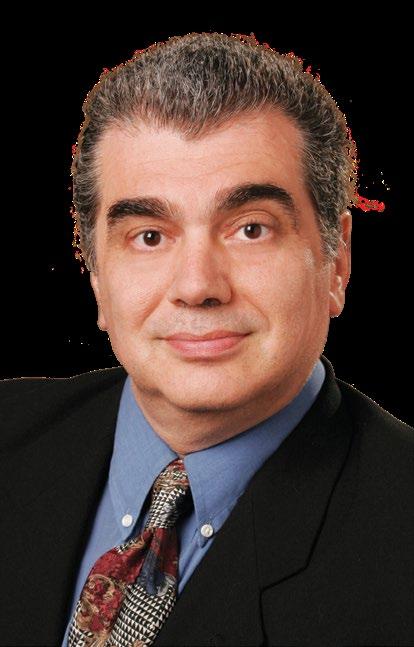
I recently needed to cash a small check and get some $5 bills to give to my kids for snacks at school. Not near my local branch, I did a Google search and found a close branch.
Greeted by three gentlemen, I smiled and joked that I needed some cash. They said we have no cash—and weren’t joking!
A full-size, free standing, bank with a safe but no cash? It looked normal when I entered, but looking closer, there were no
tellers. I was instructed (with an attitude bordering on demeaning) to go to the ATM or another branch. Had I entered the Twilight Zone?
Turns out the branch had been converted to a new “digital branch” a few months earlier, which was quite an inconvenience because I do not use debit cards. When you Google the bank, unless you go to every search result and look at its website, you won’t know that it’s a digital branch because it’s not listed that way in the initial search.
Then there was the idea of a future
without any cash swirling in my head. Tell me, if your child does something worthy, does it feel special to say you’ll transfer $5 onto their debit card? For me, it’s just not the same as handing them a $5 bill.
Two lessons here. First, for the bank, improve your customer service. Don’t look at us old guys like we have two heads because we walked into the wrong type of branch. Be more helpful. Second, for readers, if you want cash, know where you are going before you go to get it. Apparently, cash is no longer king— it’s been dethroned by ones and zeros!

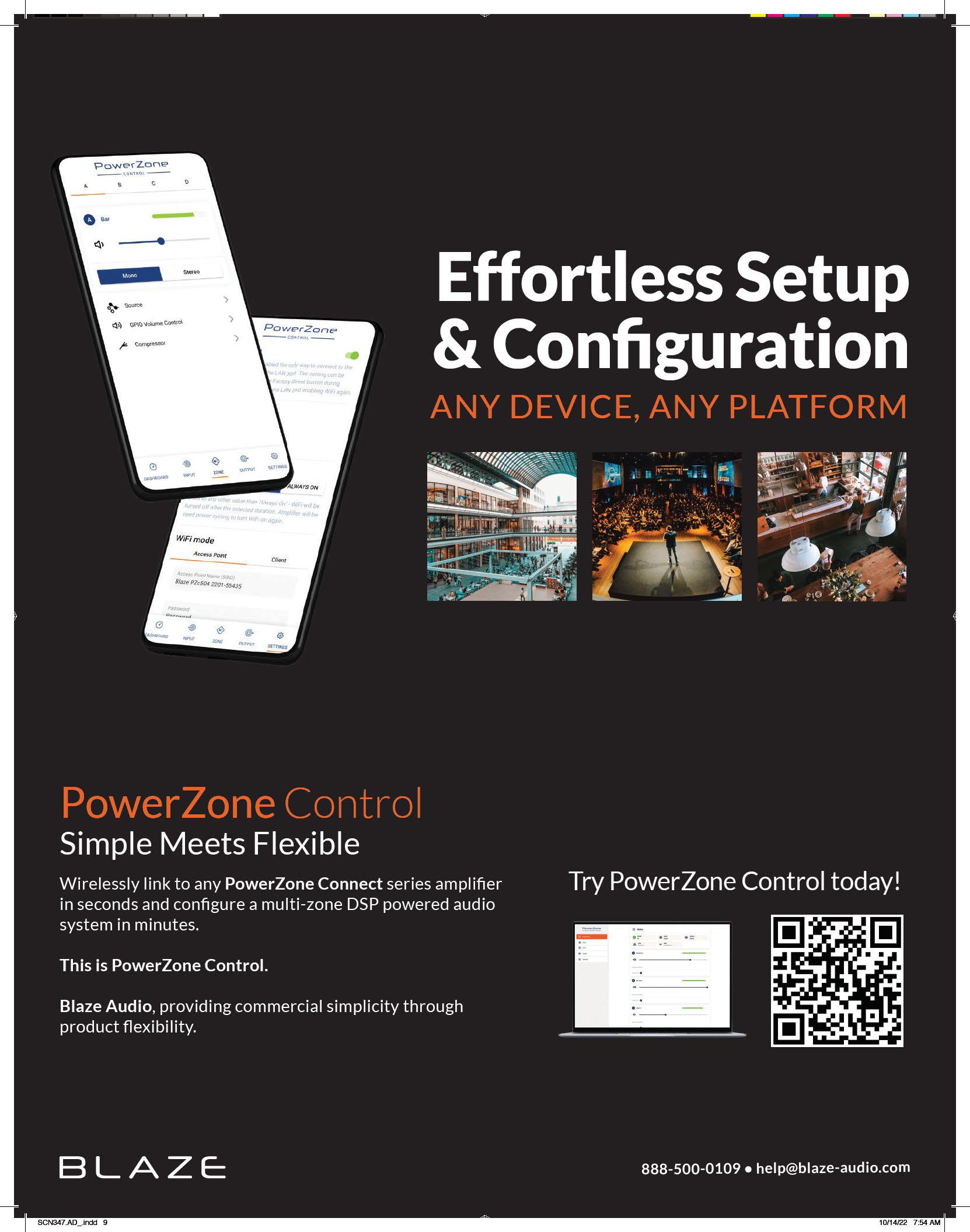
1Snapdragon Stadium (San Diego State University) San Diego, CA
With social spaces at the forefront of this new venue, AV design firm WJHW called on Clair and EAW to install a wide range of future-proofed products. Opened on Sept. 6, the venue hosts SDSU college football games, high-profile concerts, and the NWSL Wave professional rugby team. In addition to custom
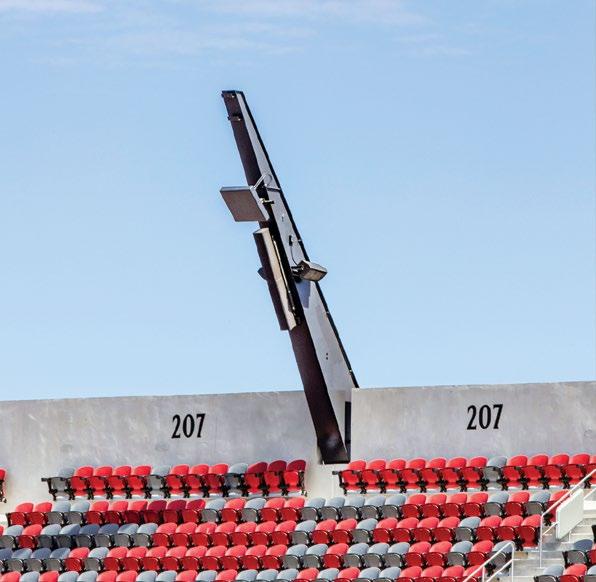

colors and weather-rated enclosures, EAW loud speakers—including the MK8196 passive two-way full-range loudspeaker, CIS400 ceiling-mounted, two-way loudspeaker, and MK2366i passive two-way full-range loudspeaker—feature ADAPTive technol ogy, which allowed for mounting locations that integrated best into the stadium’s architecture without sacrificing output levels or coverage.
Orlando, FL
Ford AV was tasked with bringing Pro AV technologies to the new 1.8-million-square-foot Terminal C, part of the airport’s massive expansion. Ford AV carried about $13 million in installation contracts using products and solutions from AtlasIED, Extron, Peerless-AV, and NEC. The AV scope of work includes areas such as airside, landside, and the ground transportation facility, installing digital paging using more than 15,000 speakers, which also carries the emergency communication announcements. Other elements of the project include digital signage in more than 500 displays, a Virtual Ramp Control Command Center, weather alert system for lightning, and the Airport Operations Center. The $3 billion-plus construction project wrapped in September 2022.
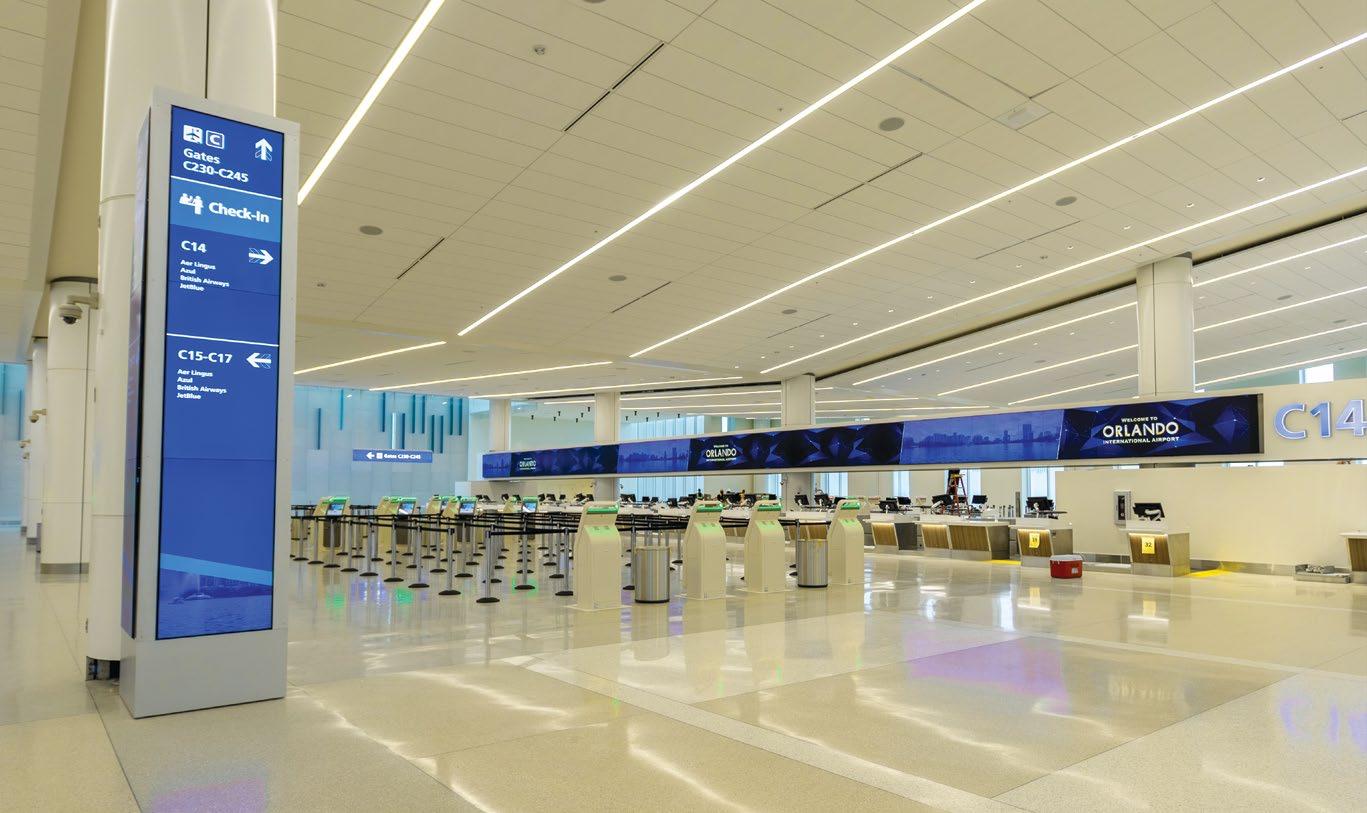
New York, NY
IVCi’s transformation of the AEA Investors Board room is just one of a multiroom series that spans the entirety of the upper-level floor of the building. The entire system easily blends to form a unified system that translates from one room to another. Both adaptable and flexible, users can bring in any tech nology or conferencing software. The system is designed with innovative technology and flexible conferencing software from companies including Crestron, Biamp, Vaddio, and Samsung. Mics are used to create proper coverage for all seated participants as well as presenters and overflow seating. The camera system creates seamless shots based on the speaker’s location, following the speaker to ensure they remain the focus of the video.
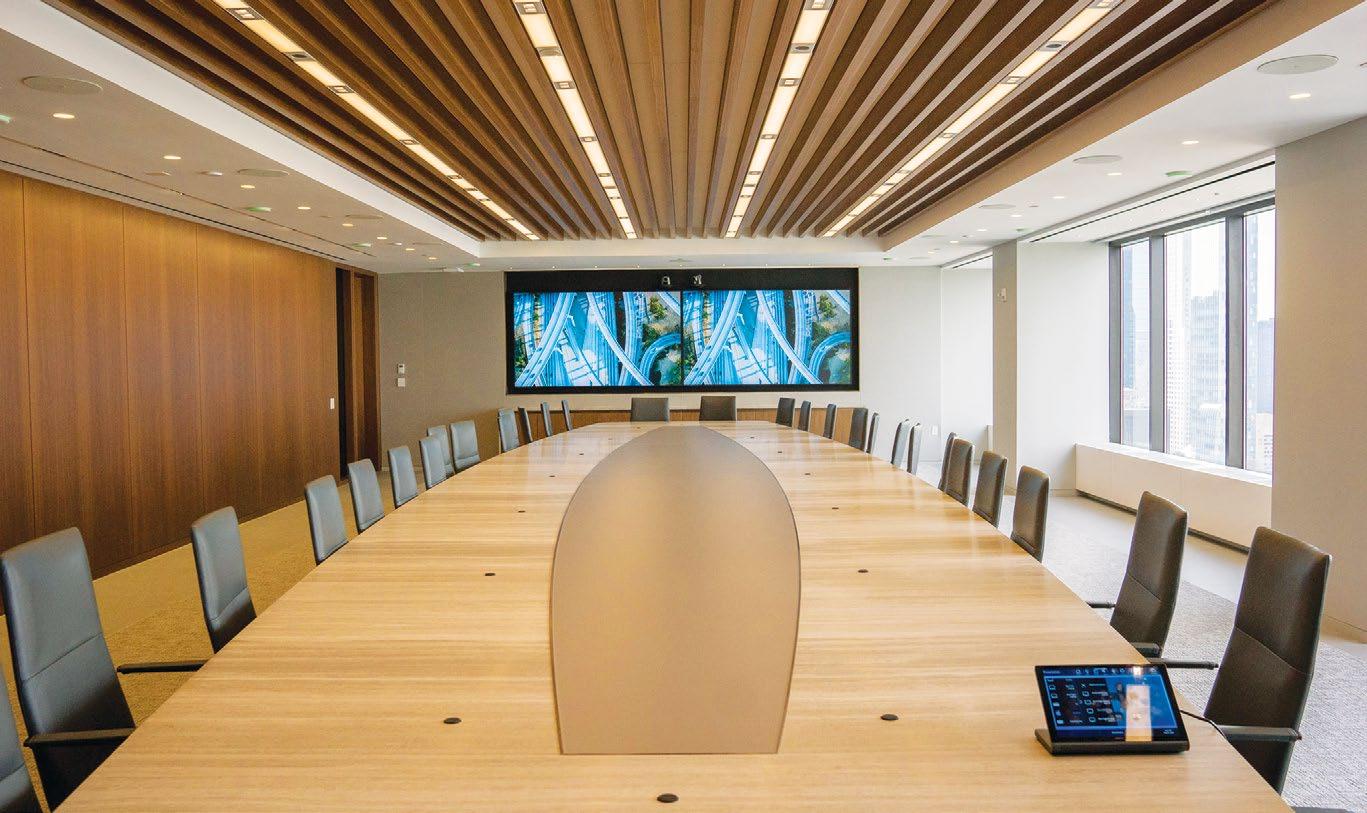
JVC Professional Video, working with Broad casters General Store, delivered live production and streaming video equipment to Seacrest Studios. An initiative led by the Ryan Seacrest Foundation, these unique studios are being established at children’s hospitals around the country, providing program ming to patients in-studio or watching from their
rooms. This fulfills the mission of contributing positively to the healing process of children and families. Patients can host shows, perform, and conduct interviews, as well as bring in live feeds remotely from within the facility using an assort ment of JVC cameras like the JVC KY-PZ100U PTZ cameras and GY-HC500 CONNECTED CAM cam corder integrated with the RM-LP100U IP PTZ controller and KM-IP switcher.
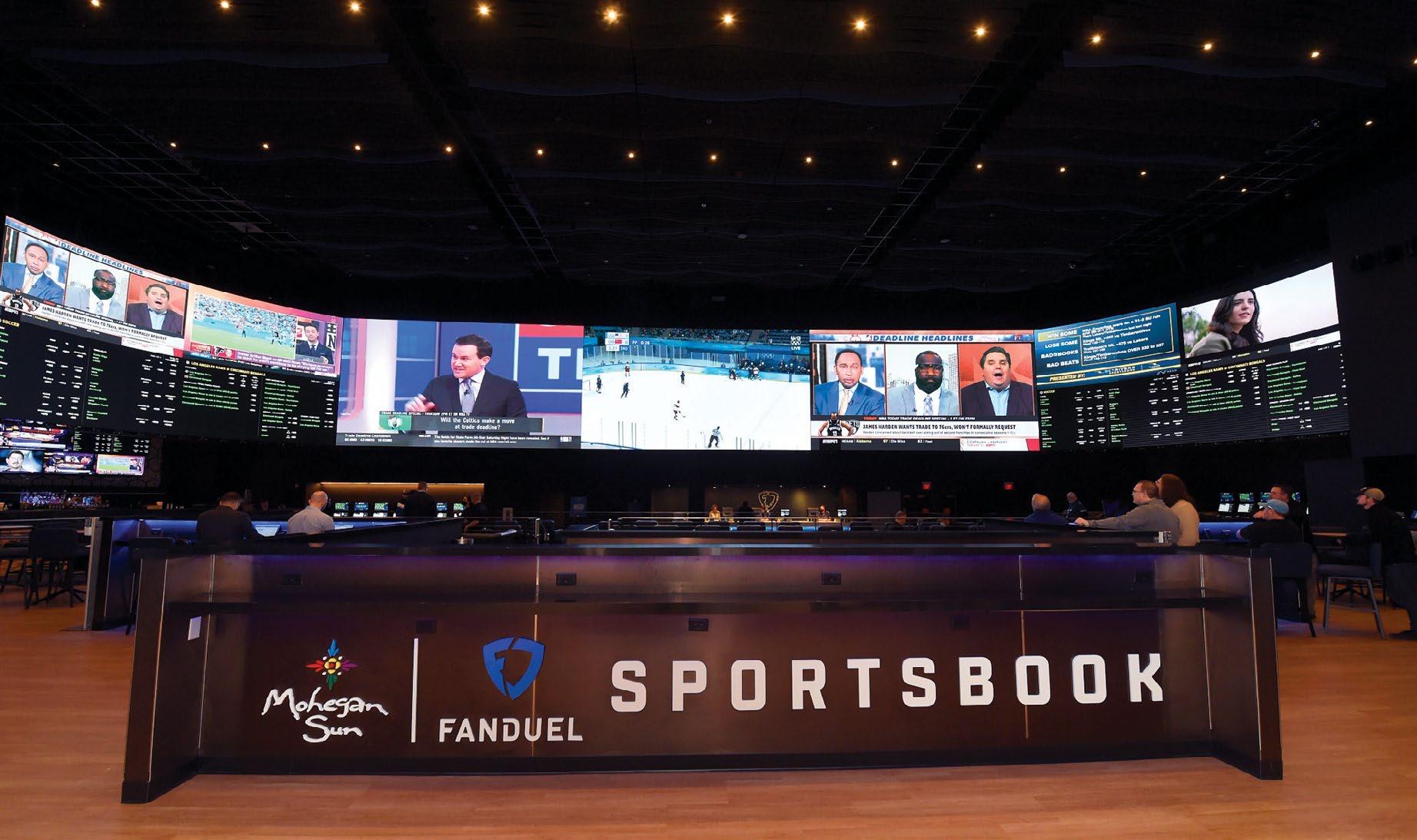
Uncasville, CT
Peerless-AV was tasked with installing an enor mous, custom video wall to deliver a more impres sive experience for sports bettors at the Mohegan Sun FanDuel Sportsbook. Peerless-AV designed and engineered a unique SEAMLESS bespoke mounting system to support the curved video wall. The team carefully arranged Unilumin Uslim dvLED displays
to create three individual video walls made up of one main wall and two wings to form a concave appearance. While the size and weight alone were a challenge, the team also pivoted from mounting the enormous video wall to the floor to creating a solution that suspended the 20,000-pound system from the ceiling.
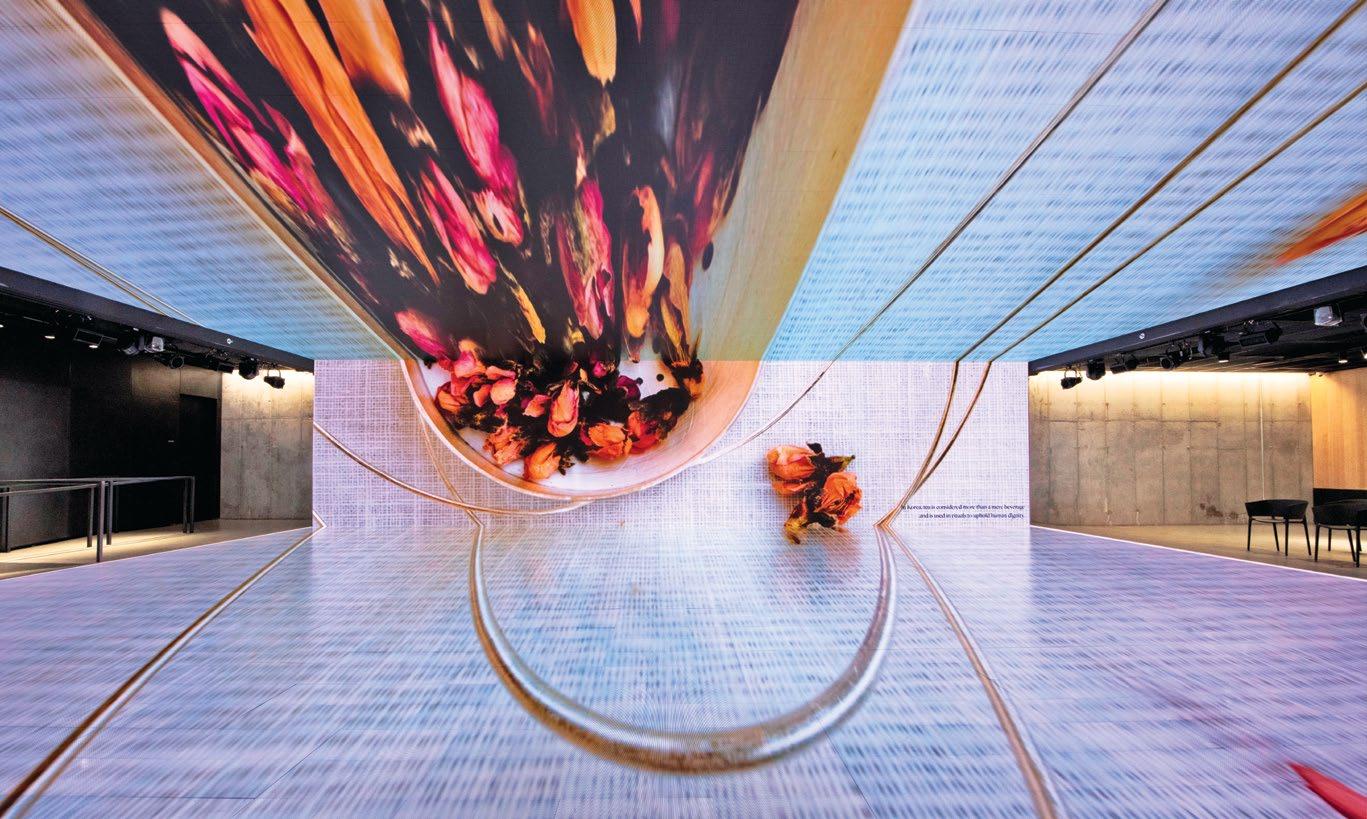
Irvine, CA
Sound Image delivered a new, innovative presenta tion venue to Edwards Lifesciences backed by Planar displays. The Edwards Auditorium features a 91.28x17.88-foot Planar TVF Series 1.5 video wall boasting 50,595,840 pixels on a complex ellipsoidal curve mount by Advance Mounting Design. The video wall was designed to optimize the Microsoft Teams experience, seamlessly connecting those in the room with off-site participants. The system features 252 DPA microphones and Crestron/Q-SYS processing, enabling multiwindow, self-configuring auto-track ing. The video system includes nine 4K PTZ cameras from Panasonic and Grass Valley. Video switching is made possible by a Ross Video Ultrix Acuity switcher and a Crestron NVX system. In-room audio is equipped with an L-Acoustics speaker system and Yamaha RIVAGE PM5 mixer.
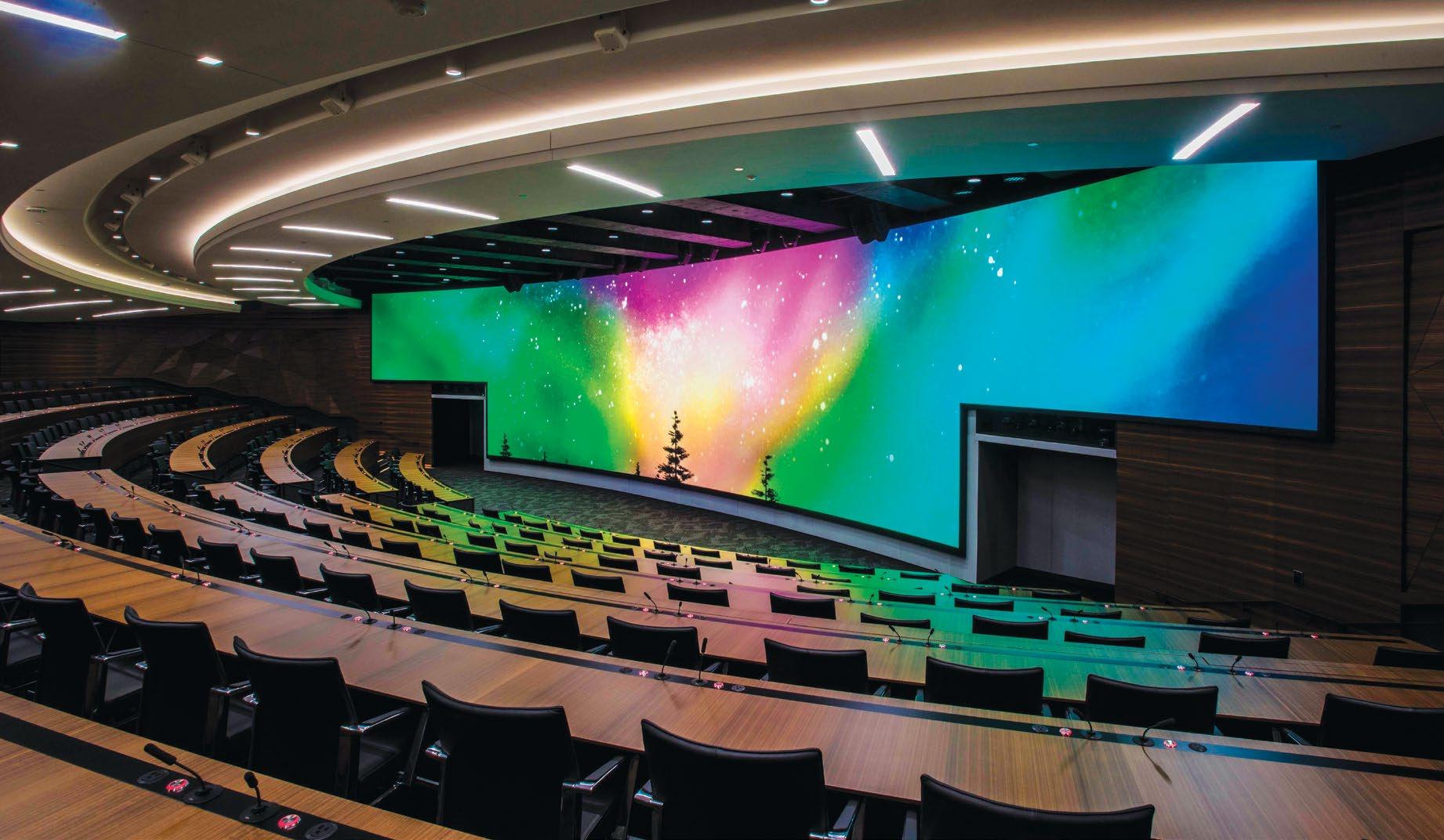
7 Genesis House New York, NY
Tritech Communications helped the automaker create a New York City destination that is part car showroom, part community center/ performance space, part Korean cultural center, and part world-class restaurant. The AV project consists of multiple video displays of varying sizes and configurations using CreateLED video tiles, Breakfast Flip-Disc art displays, Renkus-Heinz speakers, and Panasonic cameras. The theater in the lower level of the building has a 280-degree video display that is nearly 40 feet wide. Designed to showcase cars as well as performers, the floor, ceiling, and back wall of the theater are made up of hundreds of video panels bolted together to create surfaces strong enough to hold thousands of pounds—yet bright and bold enough to display delicate images.
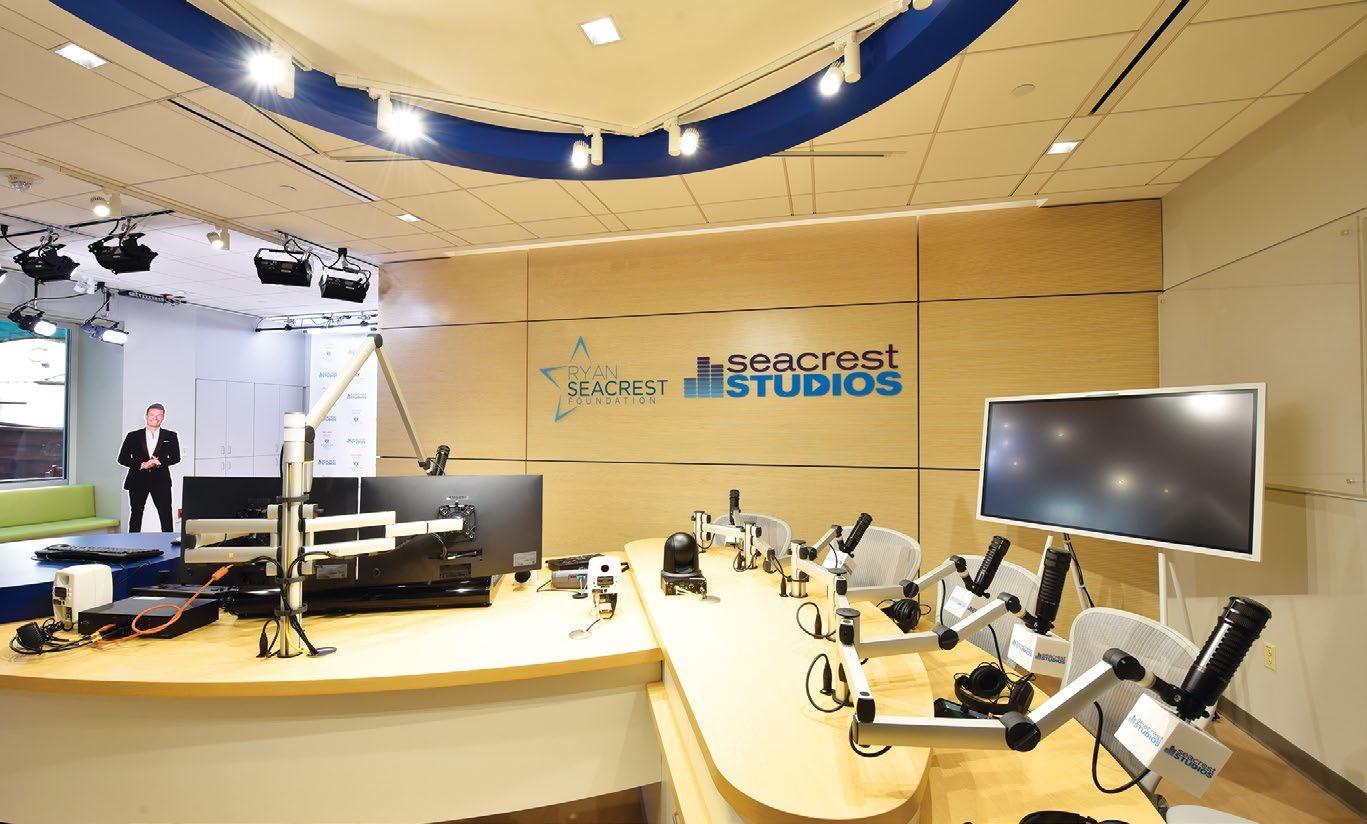
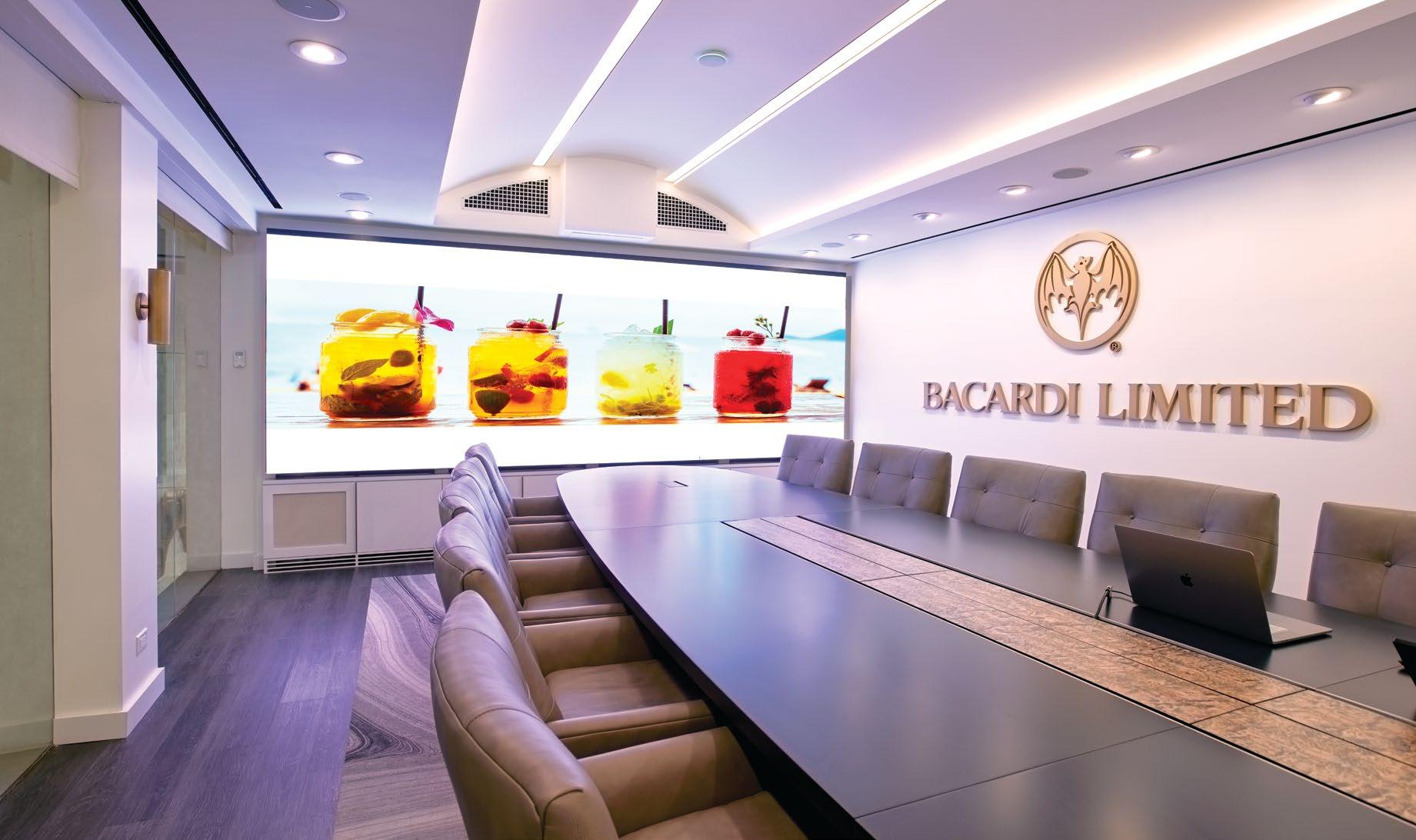
Hamilton, Bermuda
Vistacom’s mission in this executive boardroom at Bacardi Headquarters was not only to facilitate Microsoft Teams meetings between the Bermuda office and other sites, but also provide a dynamic display for local brand creative collaboration and presentations. Using a Planar TVF1.2 LED video wall provided the greatest overall image brightness, quality, and uniformity, maximizing visual impact for the size of the space. The system is designed to intuitively use and recall various layouts on the LED display for different workflows and collaboration needs. An array of solutions and technology geared toward the hybrid world—including Biamp Parle TCM-X ceiling microphones, Lumens VC-A52S PTZ videoconferencing camera, and the Crestron Flex UC-C160-T videoconferencing kit—were integrated into the system.
Spartan Stadium at Michigan State University East Lansing, MI
A new audio system installed by Washington Professional Systems (WPS) provides coverage for the bowl seating and concourse areas of the sta dium. It uses a series of Fulcrum Acoustic AHS steerable arrays, US221 subwoofers, and AH65 coaxial horn loudspeakers powered by amplifiers from Powersoft and QSC. Signal processing is handled by QSC Q-SYS Core 110f and Core 8 Flex DSPs with touchpanel integration for system control and monitoring. The headend system is connected via a Dante network and allows for interoperability between equipment with near zero latency. Frontof-house mixing is accomplished via a DiGiCo S31 console. WPS replaced the entire audio cabling with a fiber optic cabling infrastructure and installed an ancillary analog audio system, which interfaces with the fire alarm system for egress announcements during emergencies.
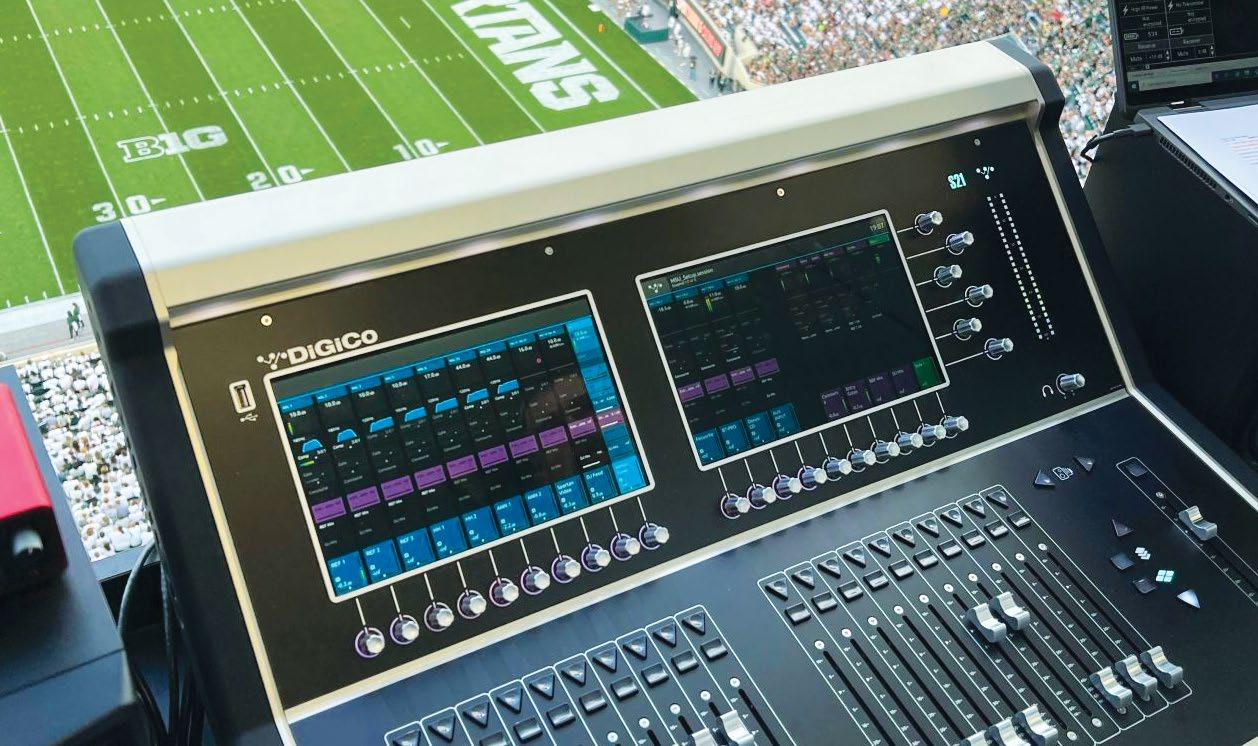
10MGM Music Hall Boston, MA Walters-Storyk Design Group (WSDG) systems engineer, Judy Elliott-Brown, specified a Dante and video-over-IP infrastructure for the 5,000-seat MGM Music Hall, a joint venture of Live Nation and the Fenway Sports Group. While primarily envisioned as a concert venue, the Music Hall systems are flexible, enabling the venue to host events ranging from conventions and banquets to remote Red Sox games. Brown’s original systems integration program from 2019 was significantly expanded to leverage new technology. Changes ranged from switching to NDI cameras for the production video to facilitate usage with an NDI flypack, as well as creating a VPN to feed bar displays. Ballpark RF distribution systems were interfaced via a tuner and encoder. A WyreStorm system was also added for concert video distribution.
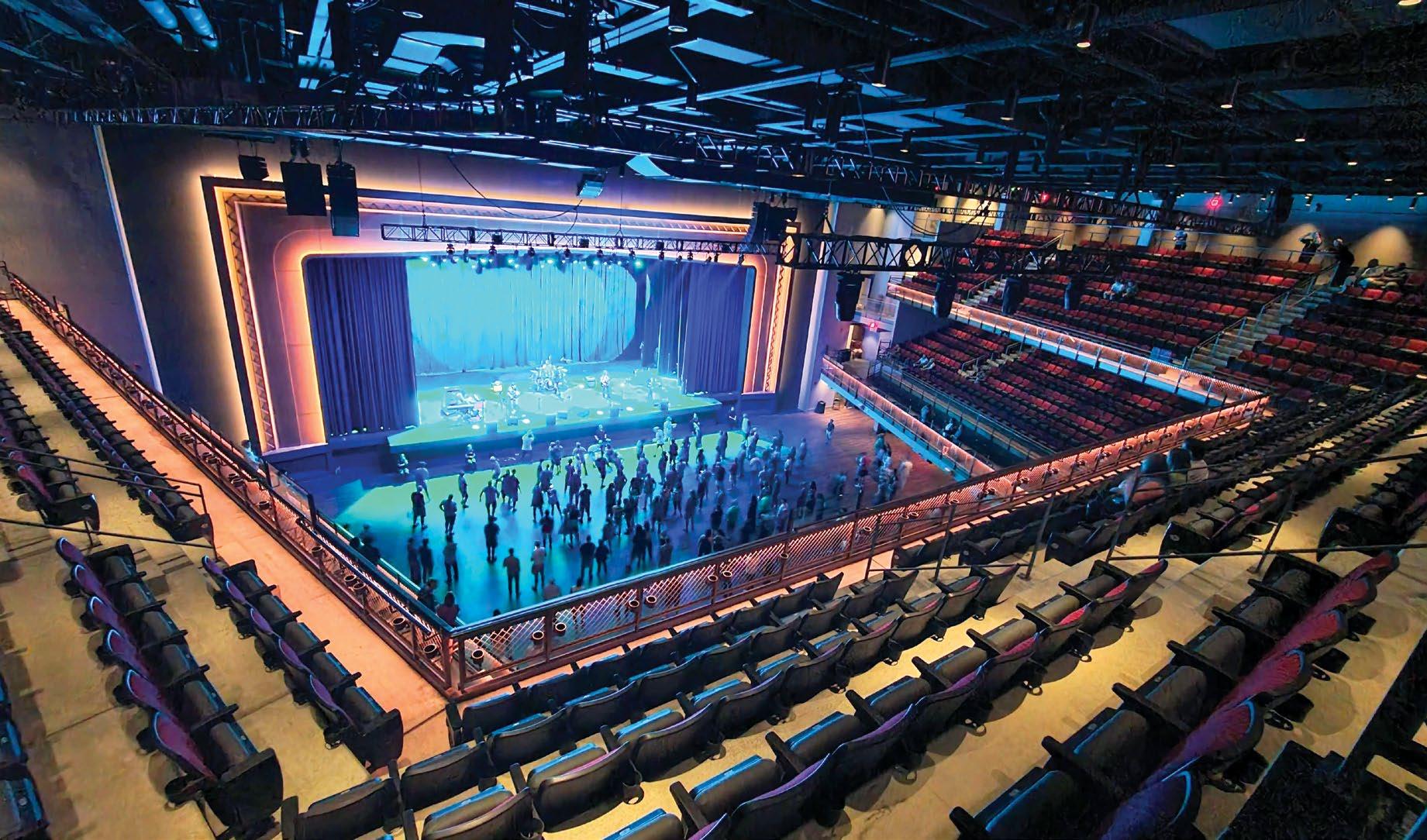

DeSales University’s new VP Studio provides students from multiple departments the opportunity to learn about virtual production.
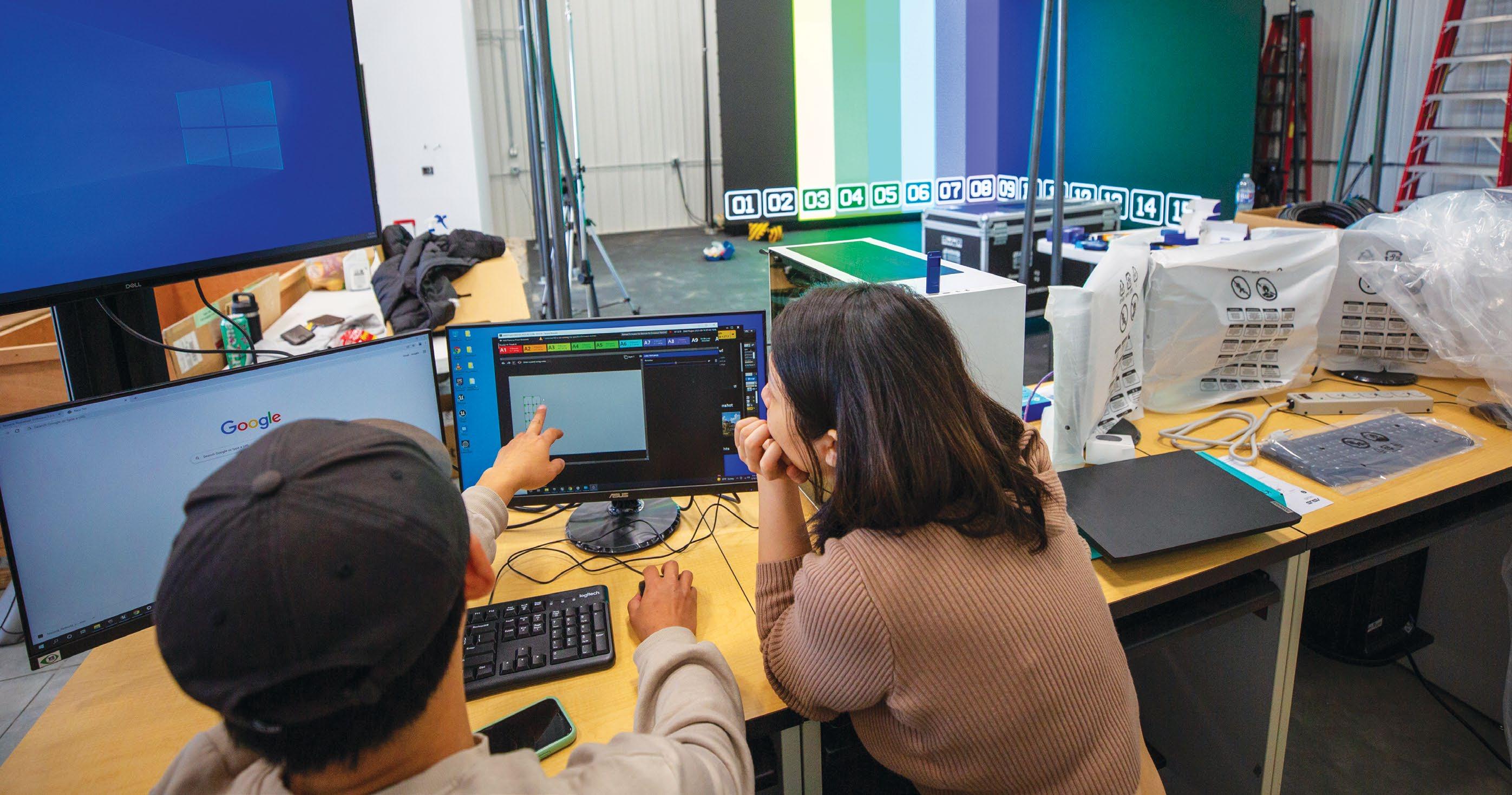
Virtual production is the cutting edge of modern film and video creation, and a strong source of job growth within the entertainment industry. Mindful of these facts, DeSales University of Center Valley, PA, is building its own virtual production studio (VP Studio) in its Labuda Center for the Performing Arts.
The new studio, which is currently operating at an off-campus location, is built around an AOTO Electronics high-performance LED screen, which covers two sides of a corner wall. The video wall serves as a high-resolution greenscreen replacement for in-studio video productions, supporting interaction between human actors and computer-generated characters, props, and environments.
“Virtual production in this format relates to live action performers acting in front of an LED screen,” explained Karen Ruggles, associate professor of computer science at DeSales University and the visionary who led the systems design and integration team for this project. “On the LED screen is a photo realistic world constructed by computer science/ digital art students. The final product is captured by a physical camera navigated by our TV/Film students.”
DeSales University and its Performing Arts
Department built the VP Studio in an effort to “stay ahead of the curve when it comes to technology in the TV/film industry,” said Stephen Furry, the virtual production supervisor in charge of the new facility.
He is also a 2001 DeSales University graduate and video production pro whose credits include Star Trek: Picard and The Mandalorian. “Virtual production is becoming commonplace in motion picture and television production.”
The on-site Sony FS7 camera is paired with a Mo-Sys StarTracker camera tracking system.
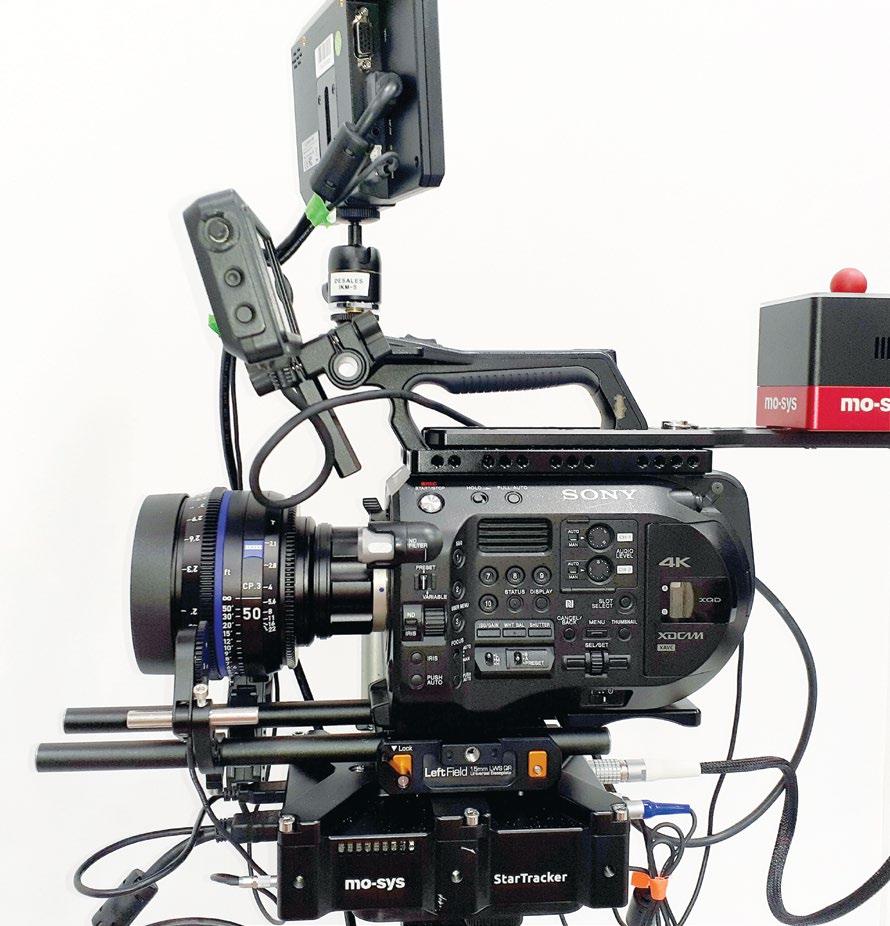
The heart of DeSales’ VP Studio is its LED video wall. It is composed of 96 AOTO Electronics RM series LED display panels (2.31 mm pixel pitch) assembled into two 13x10-foot sections that join at a 90-degree corner within the studio. The wall’s full-motion visuals are assembled on a computer known as the “Primary Operator” within the VP Studio’s control room, which is loaded with Epic Games’ Unreal Engine 5 (UE5) software. “The Primary Operator also sends the high-resolution worlds processed by its GPUs to the LED wall,” Furry said.
A Mo-Sys StarTracker camera tracking system communicates with UE5, telling the software where the on-set physical camera is in relation to the world displayed on the video wall. “To record the perfor mances, we use the Sony FS7 4K camera with prime lenses,” Furry added. “The camera is mounted on a mini-jib arm with a remote head for easier adjustment of the camera positioning and flexible camera moves.”
To light performers and sets built in front of the LED video wall, the VP Studio uses LED lighting fixtures from Aputure. “Their Nova 600c and 300c series fixtures are RGB LED units that provide a wide range of color with built-in gels and lighting effects, and can be controlled through DMX to emulate lighting consistent with the virtual lighting within the worlds,” Furry explained.


The VP Studio’s camera tracking system is connected to the Primary Operator via UE5 plug-ins such as Live Link. The actors in front of the Sony camera can be shot as is, or they can don motion capture suits so their actions can be used to animate digital characters stored within the system. “We can create video games with characters,” explained Anne Lewis, division head of performing arts at DeSales University. “We can also capture dance on film, while being anywhere in the world.”
The Primary Operator renders the full motion backdrops in real time and sends them to the AOTA video wall. “From there, it’s like a normal film shot on location, except that the location is a completely digital world that my students can customize without traveling outside of the studio,” Ruggles said.
Currently, DeSales University is storing all of its virtual worlds on the Primary Operator for easy access

by students. “This saves time in post production by marrying the background to the performances,” said Furry. “The students’ footage can then be transferred directly to their external drives in one of the TV/Film Department’s editing suites using Adobe Premiere or Avid Media Composer.”
DeSales University recently broke ground on the addition to the Labuda Center that will be the perma nent home for the VP Studio. Meanwhile, the univer sity has been renting a bay in a local car painting facility so students can use the system.
So far, the university’s virtual production capabili ties have been kept in-house, although the studio may also support commercial work down the road. “The classes that can utilize the VP Studio are only limited by our own imaginations,” said Lewis. “We are starting out with our computer science classes first, as they build the ‘worlds.’ Then, cinematography classes will begin in the spring. It needs to follow this sequence, as the TV/Film students need the ‘worlds’ to
be completed in order to shoot their films.”
Students are already producing scenes that are “all over the map, from galactic gambling and historic courtyards inspired by Shakespeare filled with choreographed expressive dance, to a man returning to his village to find it destroyed, and a post-apocalyp tic scene with fire demons,” Ruggles said. I am excited to see what their creativity will unleash once they feel oriented to the technology through a few courses.”
When it comes to the university’s eventual return on investment for the new studio, Lewis said, “Our ROI lies in having more students in TV/film and computer science wanting to study this new technology and preparing them to use it in the work world, as well as making some very fun and awesome films.”
Ruggles sees the ROI being spread across multiple departments. “Virtual production, in this format, involves computer science, TV/film, acting, and dancing students,” she explained. “There is a lot of opportunity for students to enter the space as a knowledgeable scholar, but only as one step in the process, so that they have to engage with other knowledgeable students in a different discipline and communicate for a common goal.”

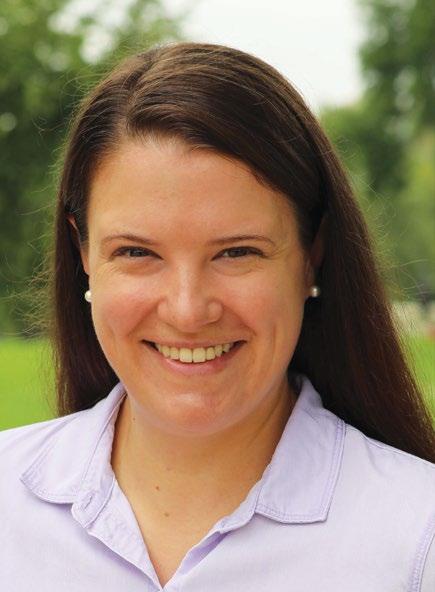
reach solutions.
Plus, since integrators are expected to guide customers from the very first meeting all the way to project completion and long-term maintenance, this wealth of information and access can save significant time and frustration over the course of a client relationship. And if the integration firm moves, goes out of business, or is sold to a new owner, clients still have access to their data history. By making the client the owner of the data, integrators reinforce the relationship and instill long-term confidence.
Remote management solutions are built into power control ecosystems, so one of the most powerful and most used functions is simply cycling power off and on for malfunctioning or poor-per forming equipment. With a remote monitoring solution, systems can be set to automatically send push alerts for any disruption, so integrators can address them immediately.
Visits to commercial job sites to trouble shoot issues cost valuable time and money.
Remote systems management solutions can and should be an installer’s go-to when managing complex projects and addressing issues on-the-fly that may arise.
By offering faster and better service, remote management platforms not only boost customer satisfaction, but also save the integrator significant time and money. But how can installers institute remote monitoring and ensure that it actually gets used effectively?
Today, employees of integration firms want and need full access to all relevant information—along with the ability to input and update information about the project and client quickly. This is possible with a user-friendly interface.
The first step is evaluating whether an interface will be quickly navigable so that employees can respond appropriately to alerts and requests. Each interface is different and offers varying levels of both control and visibility into project details.
Most robust remote monitoring solutions allow for full project management through the remote
interface, with full documentation of client addresses, contact information, project notes, and even links to project documents such as blueprints or invoices. This enables an employee to use a single program when contacting and communicating with a client, which can help them be more knowledge able and attentive to the customers’ needs.
Detail is also critical when it comes to the naming conventions used in the interface. Quite simply, the more room for detail, the better. There is no stand ard or requirement for naming, so each integrator can decide for themselves what is most efficient.
Similar to the client and project details, the most advanced remote monitoring solutions offer the ability to include information about each device, such as manufacturer, model, physical location, and notes that can be updated over time. It’s critical for a system to be accurately mapped out and organized, so integrators can confidently and quickly resolve issues without an on-site visit.
Leaving notes in a project file is another key benefit modern remote management solutions offer. Since all information can be accessed by whomever is currently available, it’s no longer necessary for a specific representative or a certain technician to address a specific customer. This increased flexibility makes it easier for both integrators and customers to
What’s more, disruptions can be logged in a client’s record so integrators can see when and how often they are occurring. Therefore, the push alerts and automated power ping capabilities combine to enable rapid responses—often before the client even notices an issue.
Another factor integrators must consider is how much control the client may want to have over a given project. When it comes to commercial installs specifically, the level of control can vary based on which staff member is responsible for daily maintenance and how involved they are with the system. Some solutions do not enable control over what specific customers can access, so all operations available to technicians are also available to every user (which could cause issues depending on the structure of a customer’s technical team).
With a simple interface and customizable access, a business owner or manager might feel more comfort able addressing smaller issues, like a router reset, as opposed to larger problems. An intuitive system offers peace of mind and helps customers feel more confident that they can fix certain issues after hours, on a weekend, or during holidays.
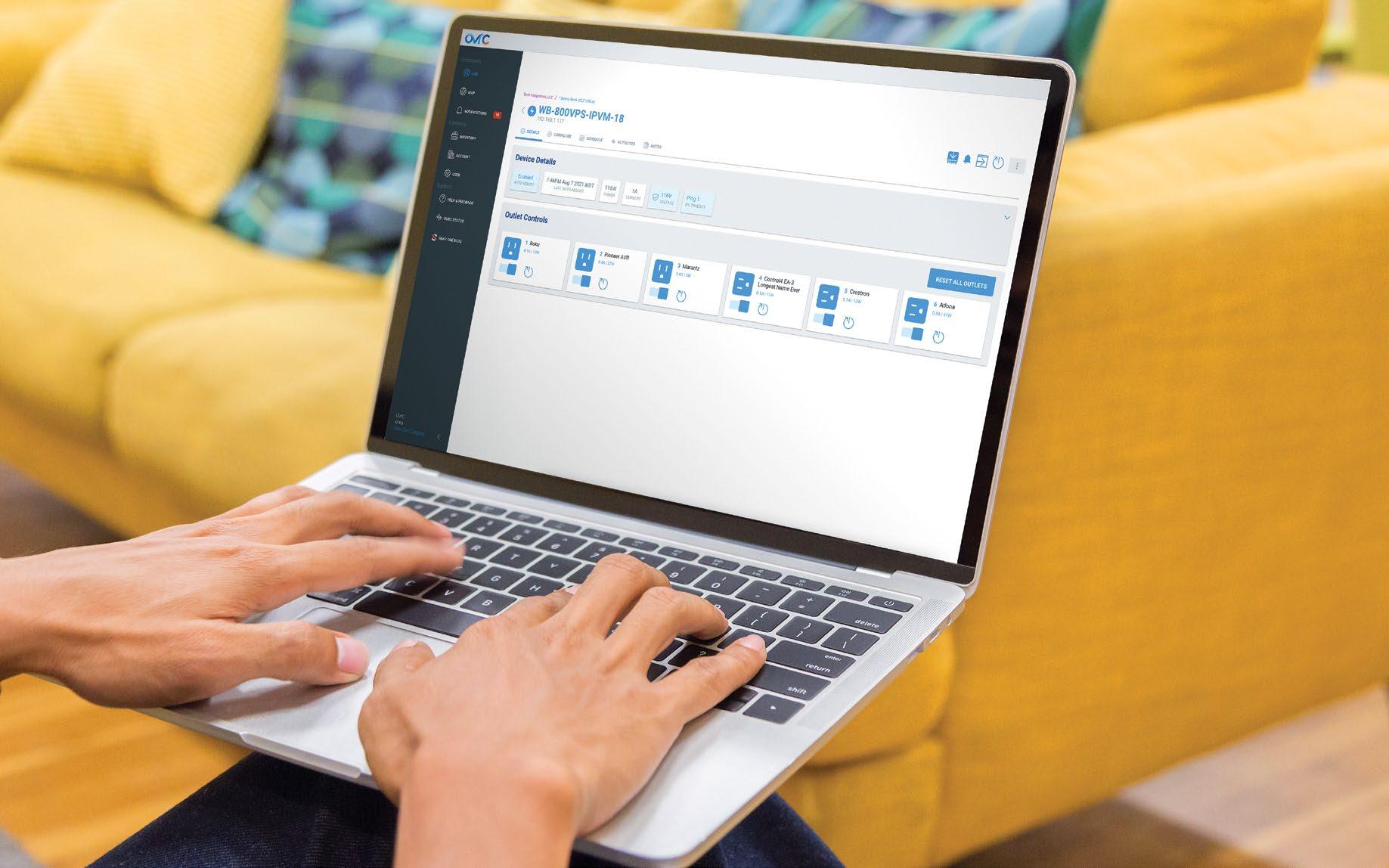
Like most other core system components, it’s also important to consider the reputation of the solution and the brand, with established and trustworthy manufacturers offering the greatest assurance that products will be supported and updated throughout the full life of the installation.
In many cases, issues at commercial sites can be resolved remotely and a time-consuming, expen sive truck roll can be avoided. The latest remote systems management solutions let integrators significantly reduce site visits, while delivering greater service to clients—it’s just a matter of adapting it for your business in a way that works for you and your staff.
Evan Marty is the director of product management at Snap One.
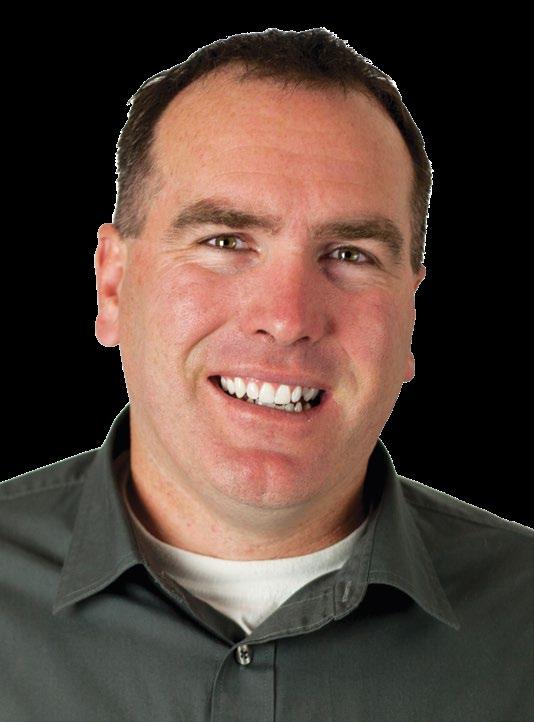
AV consultant Anthony James Partners (AJP) has completed nearly $20 million in technology improvements to Clem son University’s iconic Memorial Stadium, known amongst its fans as Death Valley. AJP worked alongside the team at Clemson, LS3P, and Brasfield & Gorrie to help deliver Phase I of a $65 mil lion renovation that focused on audio and video technology upgrades, along with the creation of the Masters Club, all in time for the Tigers home opener on Sept. 10.
One of the most notable upgrades is the massive new LED scoreboard in Death Valley’s East end zone. With almost 7,112 square feet of 10mm, HDR-capa ble LED, the new videoboard is nearly five times the size of the former board and boasts approximately 6.7 million pixels. Clad with perforated metal, the scoreboard is internally illuminated with LED lighting that gives the structure an amazing visual aesthetic at both daytime and nighttime.

To turn up the fan experience even more, an advanced, point-source audio system is designed to deliver serious acoustical impact in every seat. The new scoreboard houses some of the most powerful speaker technology available in the industry, specifically the Adamson loudspeaker system, a staple for North America’s largest touring acts.
To round out the facility upgrades, two new auxiliary displays in the West end zone and hun dreds of feet of LED ribbon boards have been installed. To highlight Clemson’s proud history and tradition, stadium signage has been updated and replaced, including the Ring of Honor. And with the help of a custom-designed lift system, Clemson’s iconic tiger (with fiery red eyes and a moving tail) can rise from the top of the scoreboard to ensure gameday traditions are never forgotten. The videoboard’s height and re-shaped entry will allow
for 365-day connections with campus and the adjacent Scroll of Honor Memorial.
“It was imperative that any renovations being made to the stadium are state-of-the-art, yet don’t stray too far from our roots,” said Eric Sabin, associate athletic director–capital projects, Clem
son University. “Anthony James Partners worked closely with us to come up with a solution that met our needs, taking that sensitivity about tradition into consideration, while also delivering a firstclass AV technology design that is sure to appease our fans.”
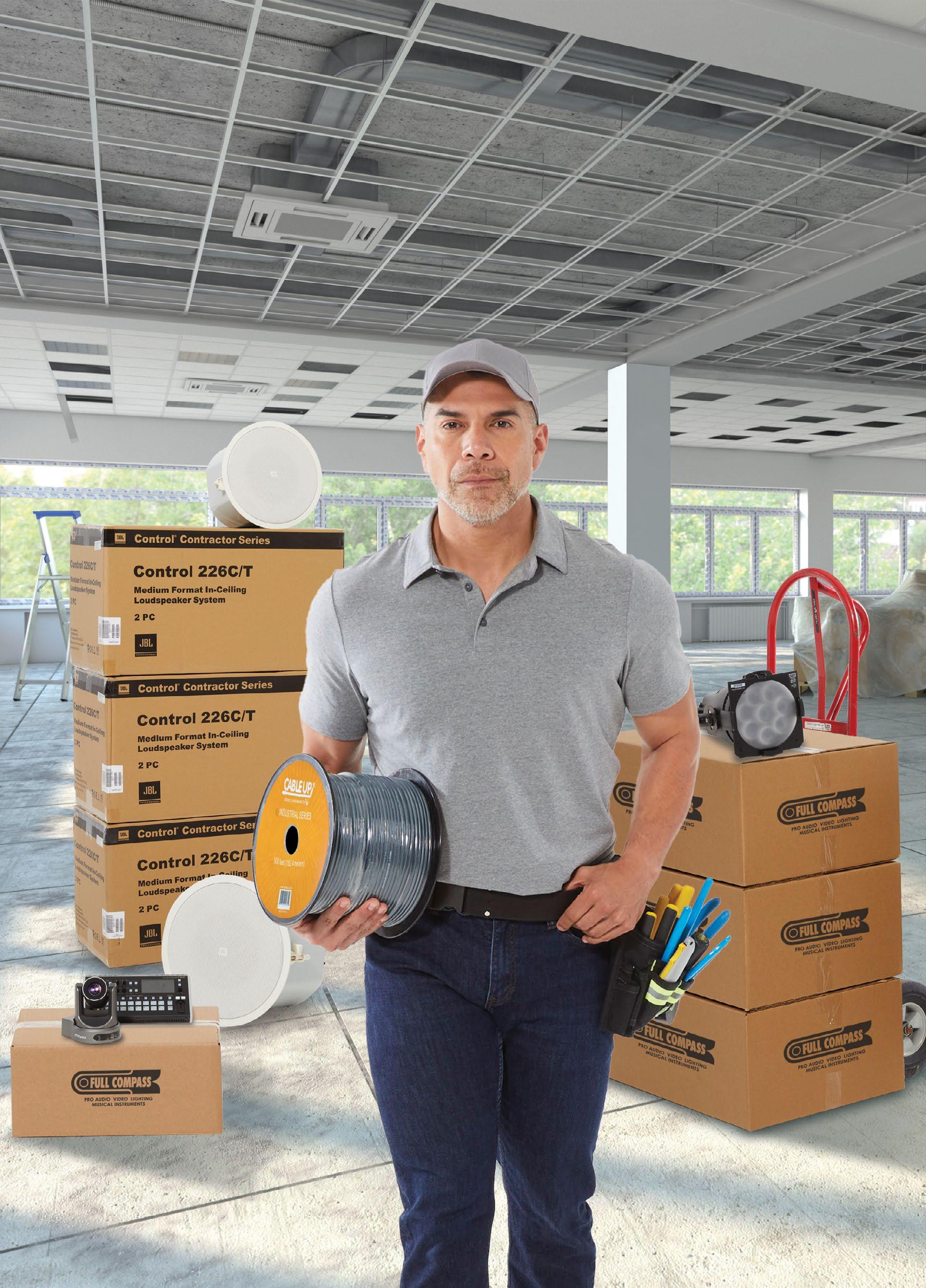
As people returned to arenas and stadiums for live sporting events, there was no deny ing that the product on the field was just as much as a fan factor as the product off it. Dur ing the pandemic, many high schools and colleges addressed their Pro AV needs, as videoboards con tinued to grow larger, brighter, and more detailed. One question that arose was how smaller schools with lesser budgets could keep up in the race for better technology Meet Digital Scoreboards. Chris Kirn, now the COO of Digital Scoreboards, was the vice president of marketing at Pepsi in 2013. The local high school that his children attended was going through a major athletics overhaul, from the turf to the technology.
Meet Digital Scoreboards.
“They came to me and asked for help with some scoreboards, but I said, ‘Let’s do a videoboard,” explained Kirn. “I spoke to other companies, and [financially] I thought there was no way we could pull this off. So, I said, ‘What if I just do it myself?’”
Kirn gathered some donations and went to work with a small team on a one-and-done installation, mostly as a kind gesture for the school. But then, the public school across town called and asked him to install a videoboard. “And then Quincy University
called,” Kirn recalled. “In about a six-month period I had done six videoboards. Six became 12, 12 became 25, and I think it was my 30th project that we decided to go national.”
With Pepsi in the rearview window, Digital Scoreboards began hitting the trade shows and increasing its marketing efforts in 2015. To say it has gone well is an understatement. The company has completed roughly 650 installations everywhere from high schools to mid-major NCAA Division I schools. As with many Pro AV companies, Kirn reported a flat 2020, but has bounced back, up almost four times as much as prior to the pandemic.
The company offers multiple LED lineups—it is a national distributor for Samsung, for example—and multiple software options. “We’re not a manufac turer,” Kirn explained. “Schools like it that way. We are more like a consultant or advisor. We are a full signage company from a production and install standpoint, and our warranties are double some of our competitors.”
You won’t hear Kirn boasting about what bigname brand he brought into each school. “What makes each [installation] unique is that each was installed based upon individual needs of the school and venue based upon resolution, warranty package, and control system,” he said. “For example, Saginaw Valley State is one product, Grand Valley State is another, and Quincy and Point Loma a third. That is
what makes us unique too: allowing schools to buy what works best for them.”
Digital Scoreboards provides two software suites for game operations and content, ProPresenter Scoreboard and ScoreVision. Both software choices offer zones for advertisements as well as gameday stats, scores, and videos. When you throw in Kirn’s background in marketing, suddenly Digital Score boards isn’t just a Pro AV consultation company, but also advises schools on how to further their advertis ing, bringing in extra value to the content produced.
“You can have rotating static ads, commercial zones with sound, and still have the scoring across the bottom or sides. It becomes a complete multimedia center,” he noted.
Kirn estimates the company will finish work for 150 schools this year alone, with a good amount coming in the NCAA Division II ranks. Here’s a look at a few stadiums and fields that Digital Scoreboards had ready for a new look for the 2022-23 season.
Digital Scoreboards worked with GVSU in Allendale, MI, and installed three new upgrades: a 14x29-foot videoboard at the GVSU Soccer Field, a 16x22-foot digital board in Kelly Family Sports Center, and a 10x19-foot videoboard for the lacrosse/track stadium.
“We ended up doing their soccer field with one product, their lacrosse, indoor track, and field hockey stadium with another product, and just finished up the field house with a different prod uct,” Kirn said. “The beauty is, we are their first line of defense. They’re calling us for warranty work, service work, tech support, and everything else. So,

they have one point of contact, while we’re fitting them with the right product.”
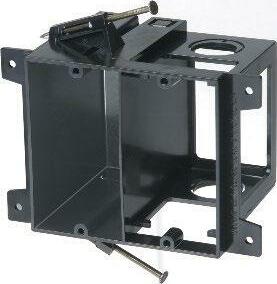
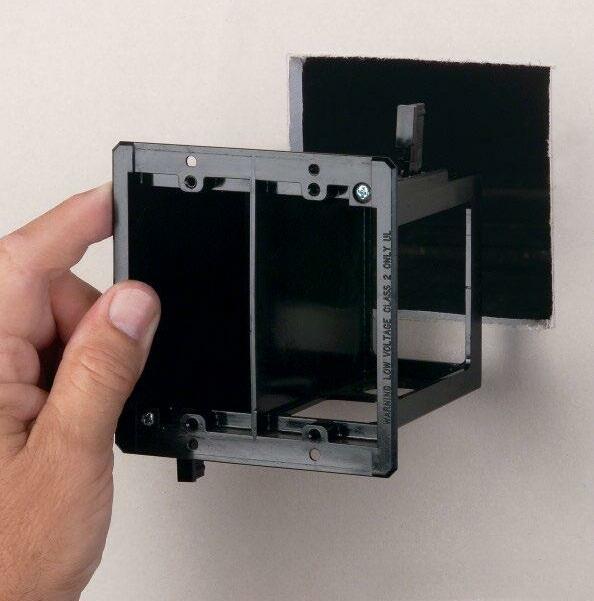
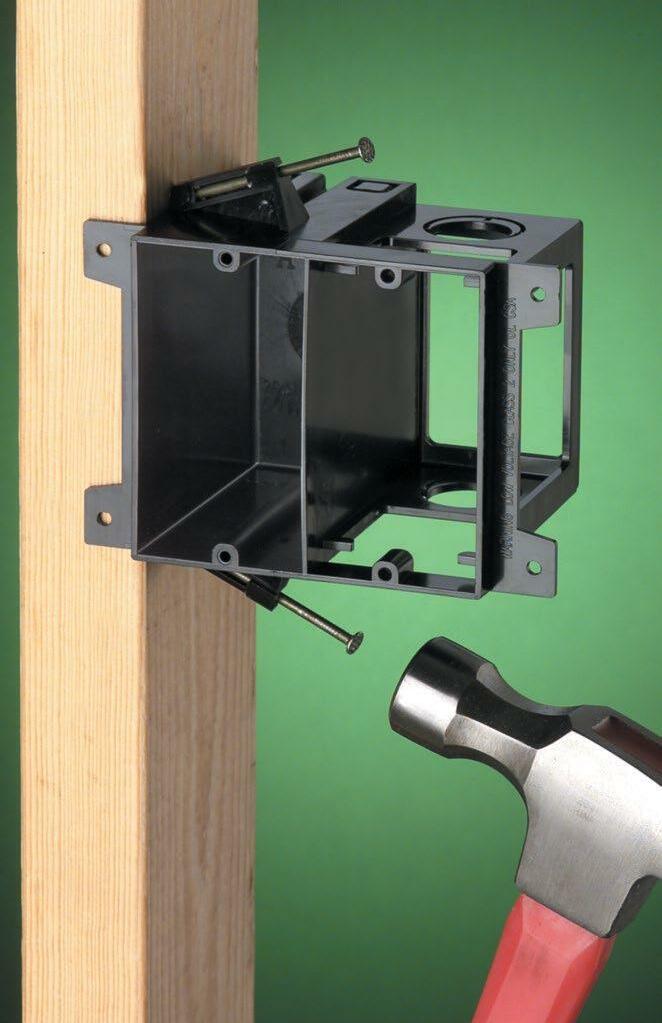
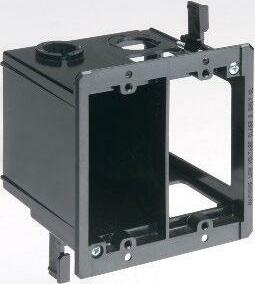

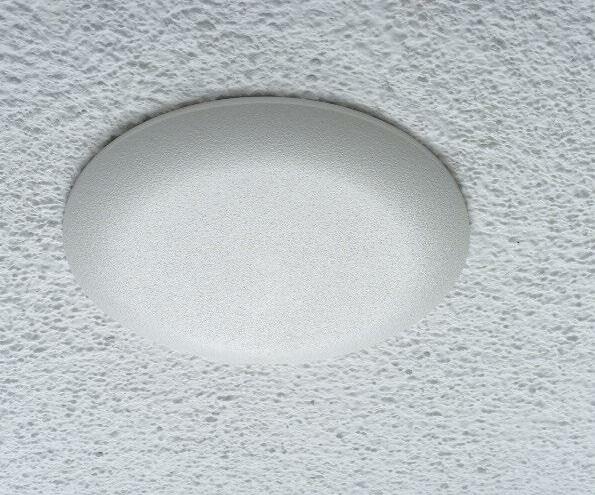
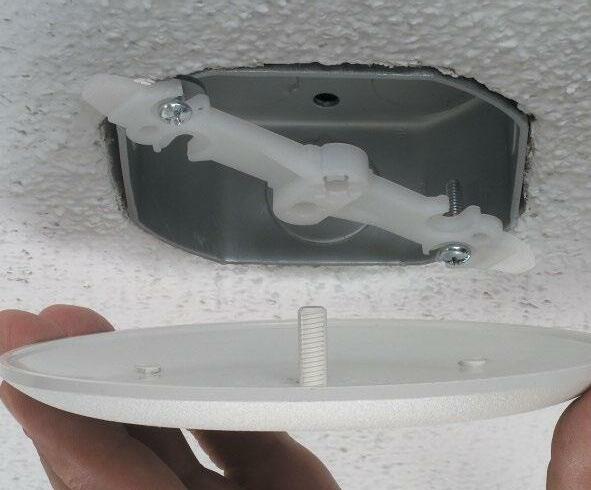
“The display at the soccer stadium is used for everything. We show a scoreboard graphic and then have live video or ads playing at the same time in other zones of the display,“ said Brent Tavis, assistant director of athletics, event and facility operations. “I have been really impressed with the final installation of these products.”
Quincy’s campus in Quincy, IL, is a “hometown” job for Kirn. Legends Field, home to both Hawks’ soccer teams, received a new 13x28-foot videoboard. The university has been using the scoreboard for every thing from gameday content to school event promos and sponsor advertisements—but is “constantly finding new ways to utilize it,” according to Josh Rabe, Quincy athletic director.
“Working with Digital Scoreboards is a pleasure because I did not feel like we were being pressured or sold their product,” he added. “It truly feels like we are working with people who care about our institu tion and the product we are using. Their availabil ity before, during, and after is what all companies should strive for.”
The Cardinals upgraded Harvey Randall Wickes Memorial Stadium in University Center, MI, home to the top-25 SVSU football team, with a 17x25-foot videoboard. But football fans weren’t alone; the soccer team saw a new 9x16-foot videoboard at Robert C. Braddock Field, and the field house received a 13x25-foot upgrade.
“With Saginaw we used 16 millimeters on their soccer field, so it was the same product as their football field,” explained Kirn as part of the installa tion strategy. “Since they are right next to each other, all the spare parts were interchangeable.”


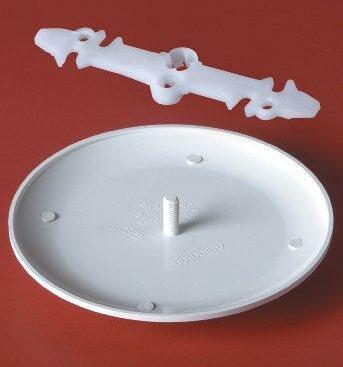
In San Diego, the Sea Lions new videoboard was ready in late June for the 2022 season and measures 10x19 feet. As Jordan Courneya, assistant athletic director for event operations at Point Loma, said, the university is “crawling before we walk,” learning all the ins and outs of the videoboard and content. The future will have plenty of advertisements and

The Grand Valley State soccer videoboard was ready for the 2022 season as the women’s team looks to defend its national championship in new style.
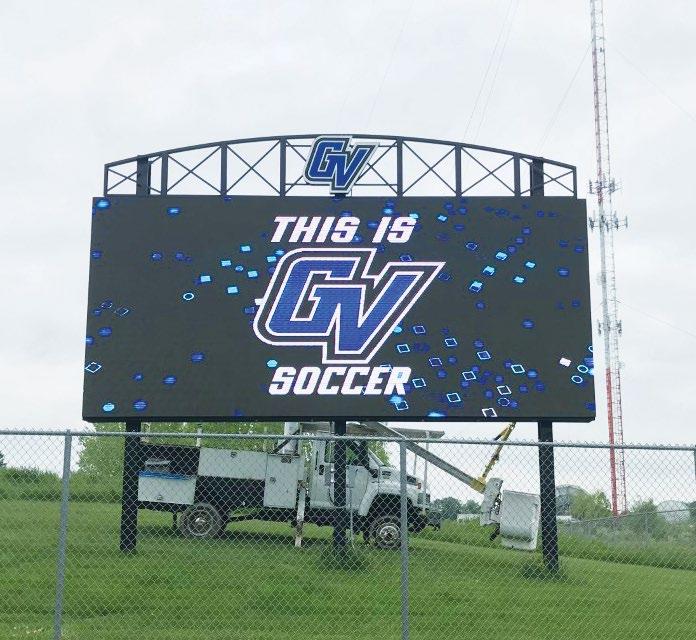
athletic event alerts—but for now, it’s strictly high-quality sports.
“We were very impressed with the final installa tion of our project,” said Courneya. “Digital Score boards was very professional, hit all timelines, and answered any questions or concerns we had.”
On display at Denver Botanic Gardens, a 23-acre public garden Redundant, is a living plant collection, natural history collection, and art exhibitions. With the mission of converging science, art, and education, its new Freyer-Newman Center is home to an auditorium, library, herbarium, research labs, art galleries, and classrooms. Now, as part of a comprehensive master development plan, the building has a modern way to connect visitors with nature.
Located in the second-floor foyer of the atrium space and flanked by galleries is a recessed video wall, which was designed to engage visitors with educa tional videos and original content featuring the diverse ecosystems found in the state of Colorado. The 40x10-foot Absen LED video wall, which features a 1.8 pixel pitch, is driven by an RGB Spectrum Galileo video processor. The systems were designed by BCER, an MEP engineering, technology, and life safety consultancy headquartered in Arvada, CO, and installed by E2 Optics LLC, a local AV integration firm. The Freyer-Newman Center was designed by Den ver’s Davis Partnership Architects and built by GH Phipps Construction, which is headquartered in Greenwood Village, CO.
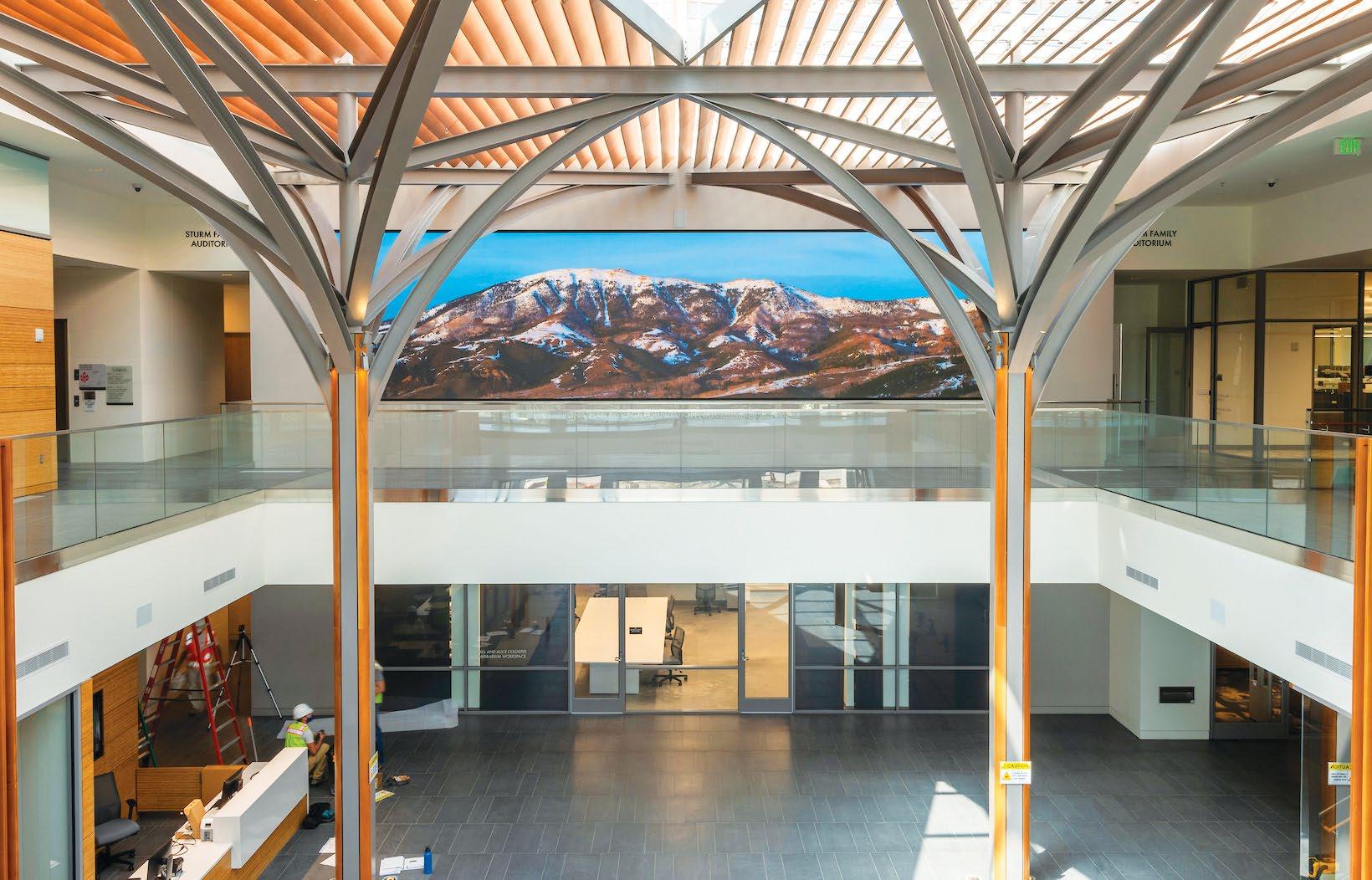
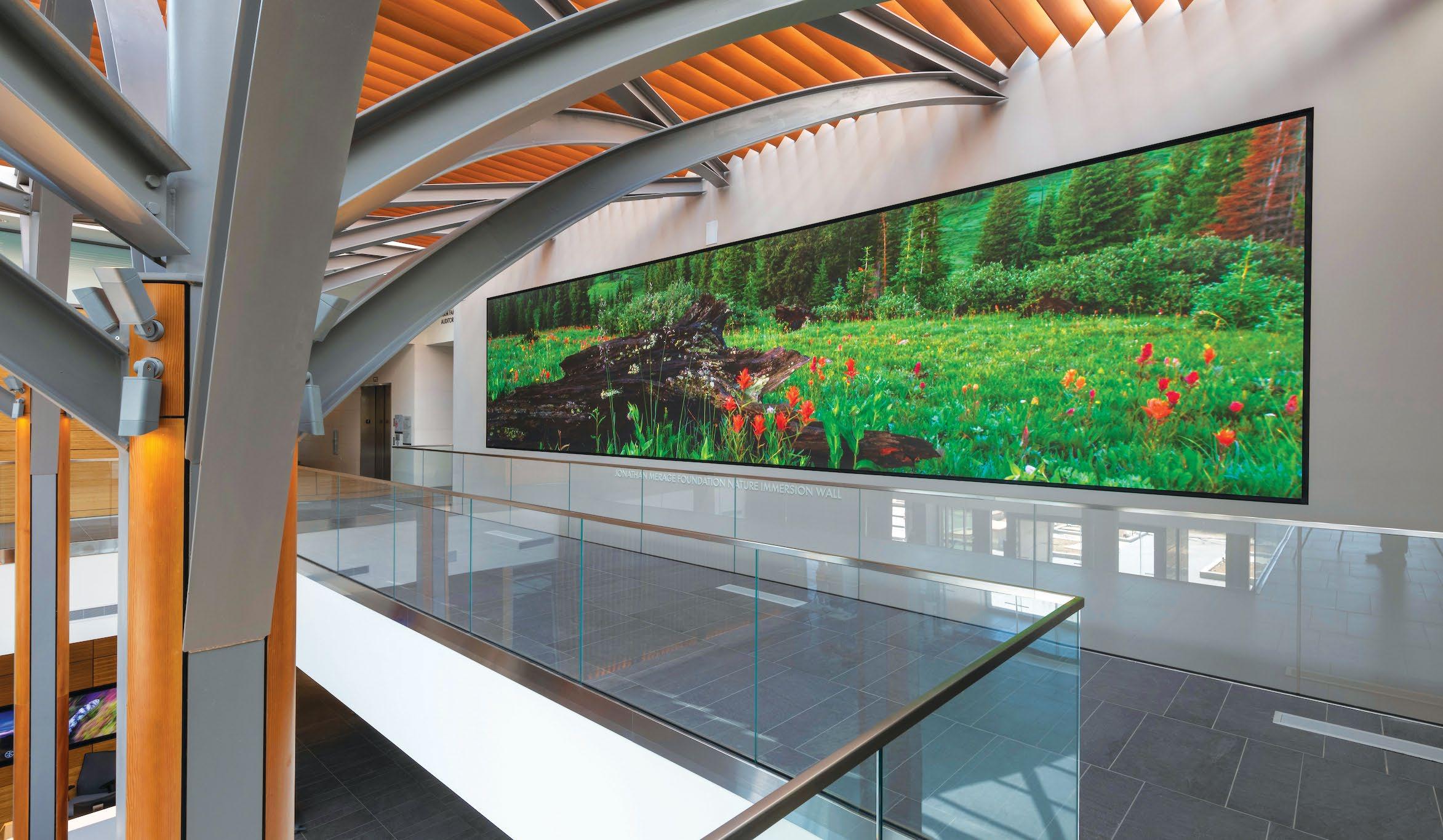
“The video wall is part of the architectural design of
the building—it dominates your view and makes you feel like you’re connected with nature, even though you’re indoors,” explained Dan Domagala, director of innovation and technology at Denver Botanic Gar dens. The exhibits in the adjacent galleries are almost always plant and nature-focused, he added, with the video wall creating a connection between the two.
The content for this display, as well as for other smaller screens throughout the facility, is entirely original, captured and produced by a team of videog raphers and documentarians that work for the Gardens’ in-house production studio, Denver Botanic Films. “It’s designed to be an immersive experience

that highlights the different flora and fauna around the state,” Domagala said.
Content is regularly updated to keep things fresh for return visitors. “Right now we have about 50 different scenes and we’ll rotate them—we’ll plug in new ones and remove others to make it an ongoing experience,” he noted. The Gardens is also planning to use the video wall for digital art installations.
Delivering real-time throughput and 4K image quality, RGB Spectrum’s Galileo receives videos and still images via computer feeds. Randy Nozawa, CTS, audio visual designer at BCER, said his firm collaborated with the Gardens, Absen, and RGB Spectrum when discuss ing the display’s video processing requirements. The main driver behind selecting the Galileo was the content that the Gardens would be displaying.
“There are a lot of moving, high-resolution images that they want to show to create that living space,” he explained. "An important part of the
selection process involved [determining] what the frame rates were, the resolution of moving content that can be pushed, and how it’s distributed.”

According to Nozawa, content is arguably the most important factor in large-scale digital signage design. “What is your client going to show on that video wall, and is it going to fit on something that giant? If it’s a bunch of lists—like class roster information or something like that—it may not be as functional as you’d like,” he offered.

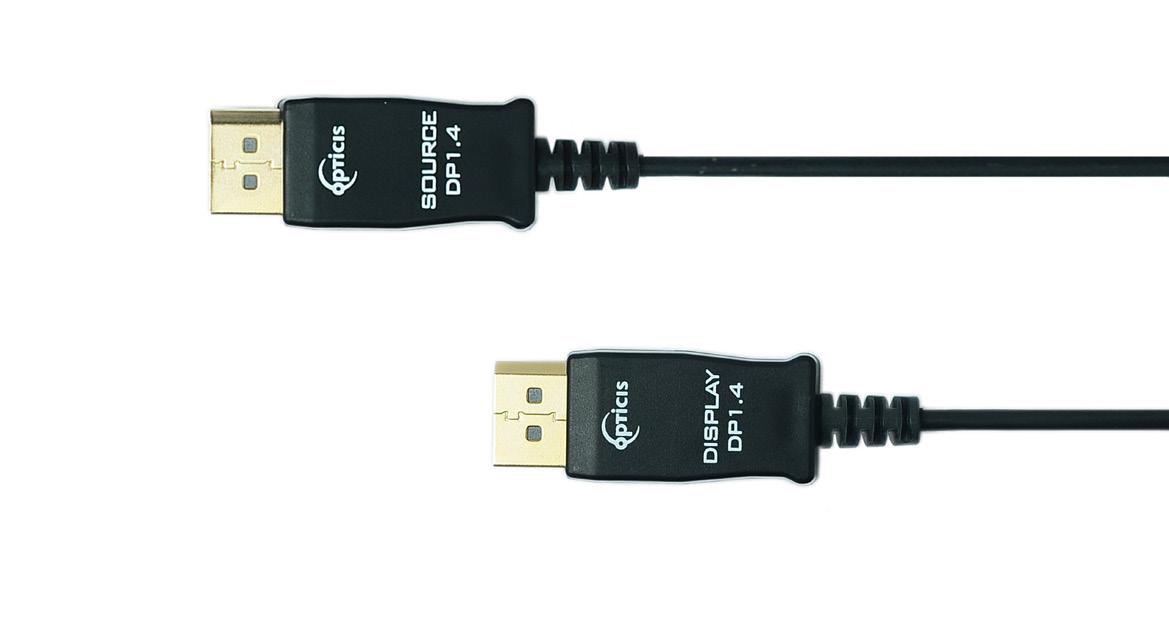

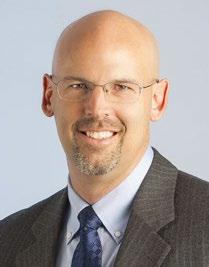
The space itself also influences design choices. “This space is a large atrium that’s full of daylight—all day, every day—which really limits the feasibility of utilizing a projection system,” he added. “We need to have that direct-view LED to provide that brightness so [the images are] visible at all hours of the day.”
Designers and integrators must also take structural and electrical engineering considerations into account when deploying large-scale displays. Nozawa said the video wall at Denver Botanic Gardens weighs approxi mately 1,800 pounds and requires 14 dedicated 20-amp circuits to power it. Calculating heat loads is also crucial to ensure the smooth operation of the systems over time. Nozawa said it was critical to coordinate with their
“mechanical counterparts” during the design process.
“This is a recessed video wall, so there were considerations we needed to take into account to make sure that there was adequate airflow and venting for the wall, so that it can distribute all its heat out and it doesn’t cook those panels,” he explained. “There were a lot of discussions about what the content was going to be, and how long it was going to be on, to help mechanical decide what they needed to support.”
Domagala confirmed that coordination between his facility, the architect, and the AV designer and integrator was essential in order for this project to succeed. “It’s a centerpiece showcase that was
intentionally designed as part of the building, so that includes not only the placement, but all the back-end electronics and power in order to make all this happen,” he said. “It required a lot of coordination between not only the architect but also the builder, because we need that wall as flat as possible; there are hundreds of video panels that are all side-by-side, and if there are any buckles the seams are going to really be noticeable.”
Nozawa, whose firm has recently specified similar large-scale display systems for other projects in the state, said that a growing number of facilities are deploying large-scale video walls as showpieces. He believes that this trend exists, in part, because technol ogy costs are decreasing, but also because venues are experimenting with how to use technology to augment the architectural experience in their spaces.
“One of the cool things about this particular install and some of the others we’re doing—like the Anschutz campus at the University of Colorado—is it’s really using technology as a supplement to the space,” he said. “It’s intended to enhance the beauty of the space and provide a kind of ambient feeling. And I think it’s really cool to have technology included as part of what that space means, and not be the only focus of what that space is.”
 By Jennifer Guhl
By Jennifer Guhl
Las Vegas is known for going big. From sports arenas to the attractions along the Las Vegas Strip, what happens in Vegas is clearly some thing you won’t forget. So, it’s fitting that one of the largest AV-over-IP installations in the world can now be found at the first ground-up resort to be built on the Las Vegas Strip in more than a decade: Resorts World Las Vegas, which resides on the former grounds of the famous Stardust Resort and Casino.
The near 88-acre, $4.3 billion property—which includes the Las Vegas Hilton, Conrad Las Vegas, and Crockfords Las Vegas—includes more than 3,500 guest rooms and suites within the three separate hotel properties, a 5,000-seat theatre, two-story dining and retail promenade, and more than 40 high-end dining options. Designed to be one of the largest AV integrations found on the Strip, signals can be transmitted from anywhere on the property, including to a signature 100,000-square-foot LED screen, considered to be one of the largest LED building displays in the country.
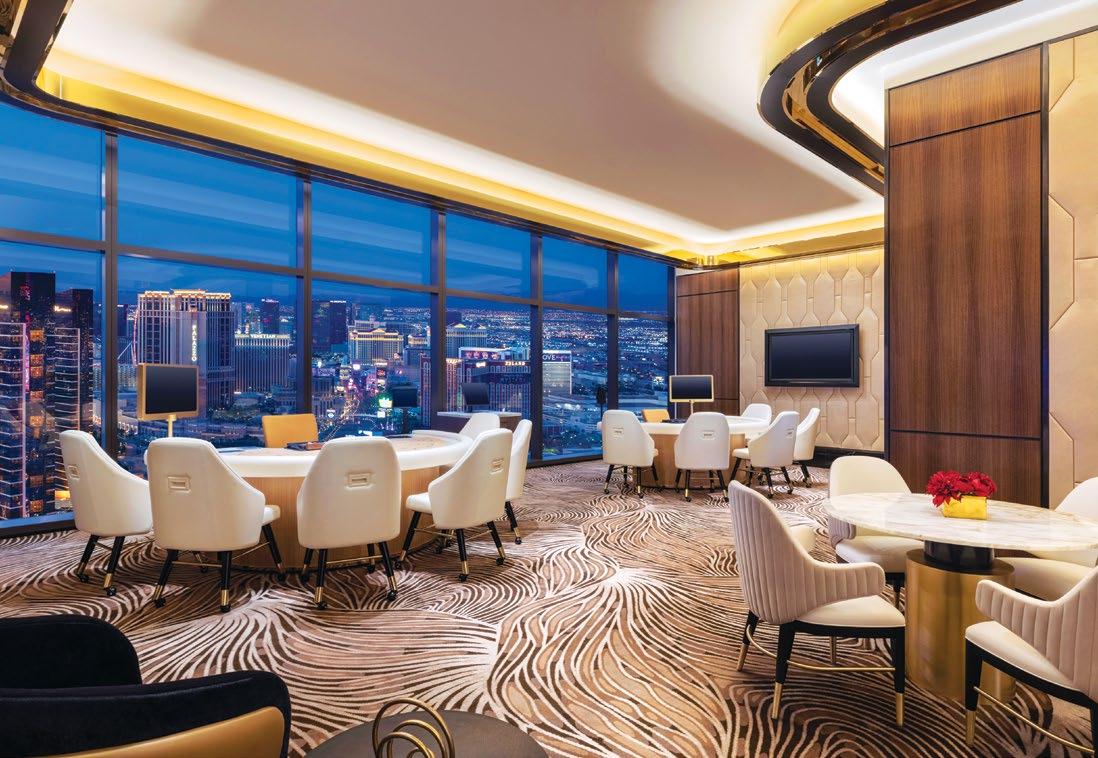
Richard Perks, director of AV infrastructure at Resorts World Las Vegas, was tasked with bringing together the right group of partners to take the AVoIP project from concept to fruition. He selected Technol ogy West Group of Las Vegas, a leader in customized AV systems, to manage the project and lead the design of the AV system and network. With more than 2,000 PacketAV endpoints and 2,000 Q-SYS audio channels, the large-scale network was designed to perform.
Richard Reisig, vice president of Technology West Group, said the scale of the system is what sets it apart
from other installs within the industry. “The number of endpoints continues to grow as we build out the system,” he explained. “It’s a very large, purpose-built network designed to supply one gigabit of non-block ing bandwidth, end to end, to any location on the property with less than a millisecond of latency.”
The software-based Q-SYS platform was selected to support the large-scale centralized processing throughout the property, creating one-of-a-kind experiences for visitors within event spaces, common areas, and premium luxury suites. The network is powered by Q-SYS Core 5200 Enterprise processors, two of which are located within each hotel tower.
“The most radical departure from traditional AV is in the software interface,” said Shane Snell, project manager with Las Vegas-based integrator National Technology Associates, who was responsible for integration within the resort’s first-floor common areas. “They wanted to build a user interface that spread across the whole property. It’s very personal and we haven’t seen it in any other properties.”
Within the luxury suites, 12 different room types are available—and each guest room is outfitted with a fully automated system that includes ceiling loud speakers, touchscreen controls, environmental controls, and AV distribution. Working in partnership with the One Touch Living integration team, a series of custom Q-SYS user control interfaces (UCIs) were developed to offer real-time visibility for each space.
Common areas, such as the gaming floor, hallways, elevators, and hotel lobbies were part of the larger system, but had their own distinct requirements and needs within the network. Including Dante as a licensed feature made it easy to integrate additions to the network, including Bluetooth audio and DJ inputs.
“It’s the only place I know where all these different protocols actually live on the same set of
switches,” said Scott Kalarchik, senior advanced applications engineer, Q-SYS. “The network engineer figured out how to put everyone’s protocols on here, and it works perfectly for this.”
The open technology provided by Q-SYS enabled global programmers to make adjustments while allowing the in-house AV/IT team at Resorts World Las Vegas to easily learn and master the system. It was very important for the in-house team to fully understand the capabilities of the network and what it could support.
“This system is scaled up to encompass the whole property. We probably have the largest deployment done at one time and it all works as one large system,” said Perks. “It truly makes our jobs easier for such a large building.”
Of course, it wouldn’t be Las Vegas without thrilling nightlife amenities. The property includes a night club, social gaming, dining experiences, and more. When conceptualizing the network, these areas had to operate independently while also maintaining the ability to integrate with each other for special events. With these spaces being utilized by so many different people, it was important to make sure everything was not only functional, but also easy to use and control.
Keeping Q-SYS at the heart of the routing capabilities, integration company Solotech was tasked with using the open architecture of Q-SYS to customize a system that could easily integrate third-party devices to enhance the entertainment spaces throughout the property, providing a unique experience for each guest attending a concert or lounging out by the pool. “Every one of the bungalows and cabanas is almost its own individual proprietary AV deployment,” said Ben Baczenas, integration system designer with Solotech.
With the network allowing for multiple plugins to be readily available, Technology West Group needed to find a network-based video solution that could integrate well with Q-SYS and allow them to connect with anything on the property no matter the location. Visionary was brought on board to design custom solutions with PacketAV endpoints that offer internal device VLAN tagging, which is unique to Visionary—and critical due to the size and complexity of the network.
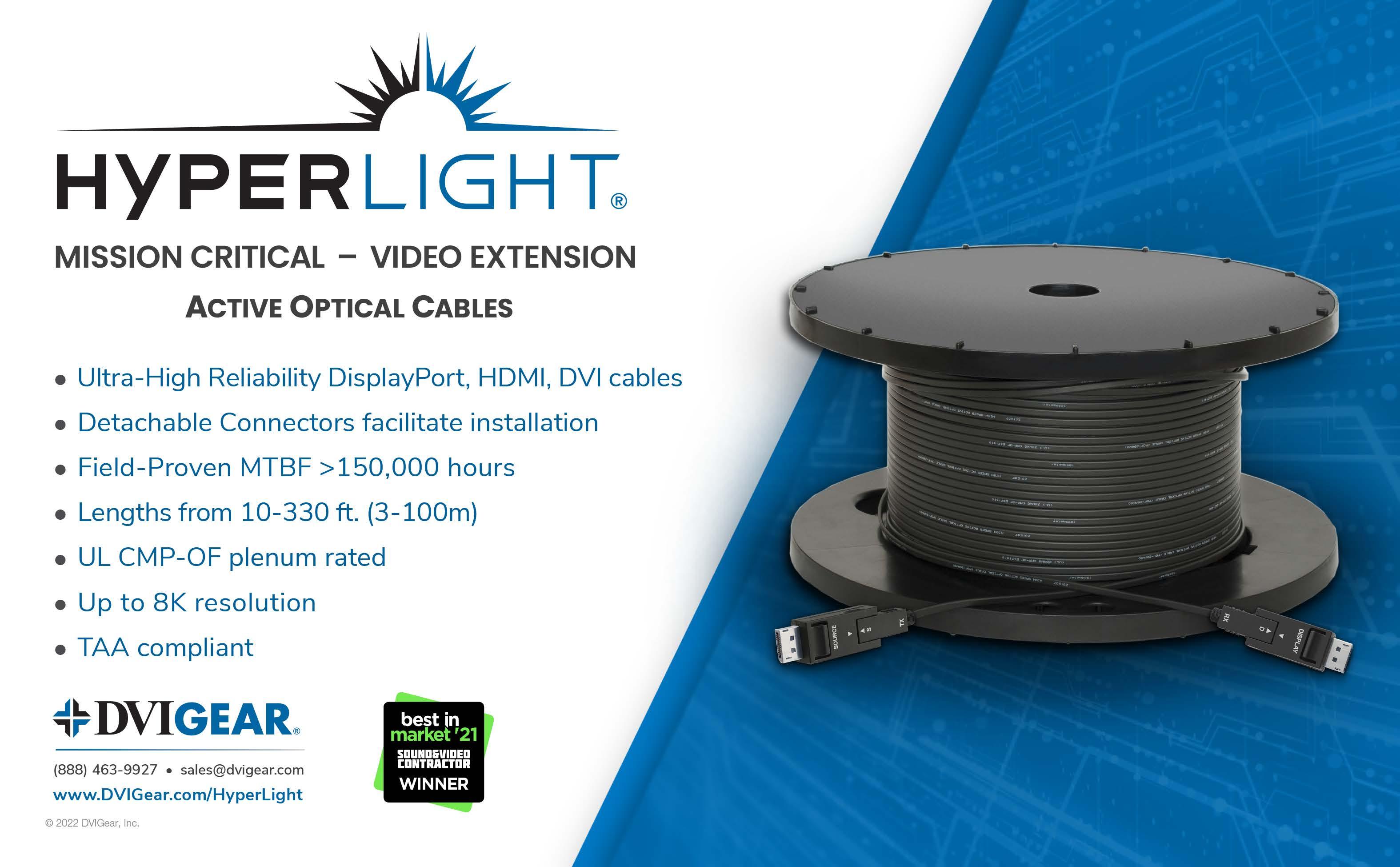
“It wasn’t just someone pushing their skews or forcing us to build a facility around their product,” said Reisig. “Visionary really jumped through and made new product for us, which was fun. I have never had a manufacturer help in that way.”
One of the custom solutions Visionary created was the Bluetooth-enabled PacketAV Duet Wall Plate Encoder, which combined Dante/AES67 audio embedding and de-embedding with 4K UHD video over a single gigabit Ethernet port. “At the time, it was the only wall plate with Dante audio integra tion,” said Scott Freshman, Visionary COO. “At the time, it was analog input and they asked if we could
change it to Bluetooth to save them from putting port drops separately next to each wall plate.” This flexibility was a game changer and allowed Technol ogy West Group to reduce overall power consump tion, number of ports, and costs related to integrating two products instead of one.
When collaborating with so many partners on a project of this scale, issues are bound to arise. But Q-SYS commended Perks on bringing together a group of partners that made the process fairly seamless, especially when you consider working through a global pandemic, among other challenges.
“A job like this doesn’t happen without some
thing going wrong. There is always something you don’t foresee. But we had the people and teams in place to talk it out and actually work through it. There was no finger pointing. Things just hap pened,” said Kalarchik.
As a robust network built on Q-SYS and Visionary technology, Perks is confident the system can accommodate growth and adapt to new or changing system requirements. “We have a lot of opportunity to add newer technology as it becomes available,” said Perks. “I think we’re pretty well poised to be able to do anything we need to do now and in the immi nent future.”

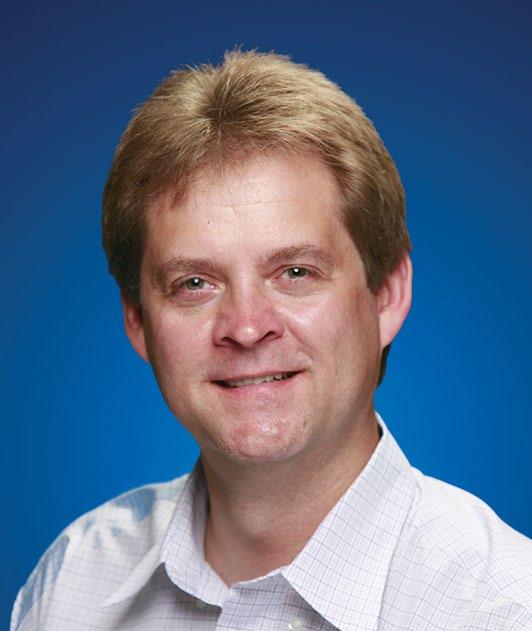
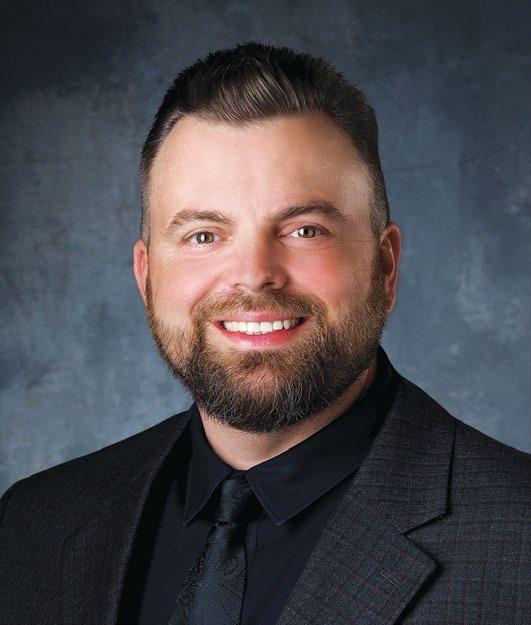

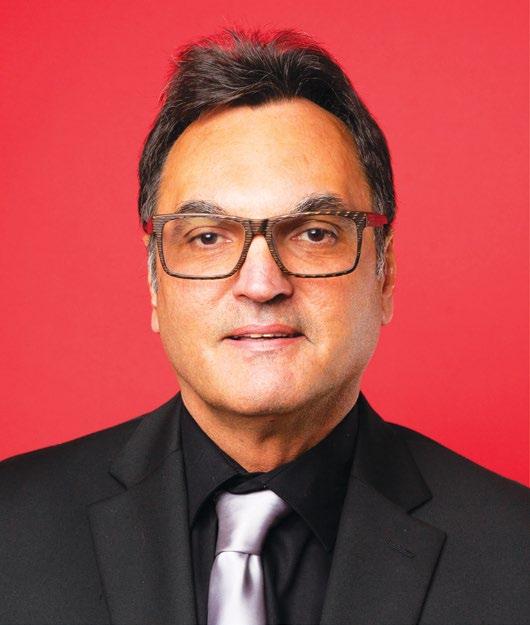
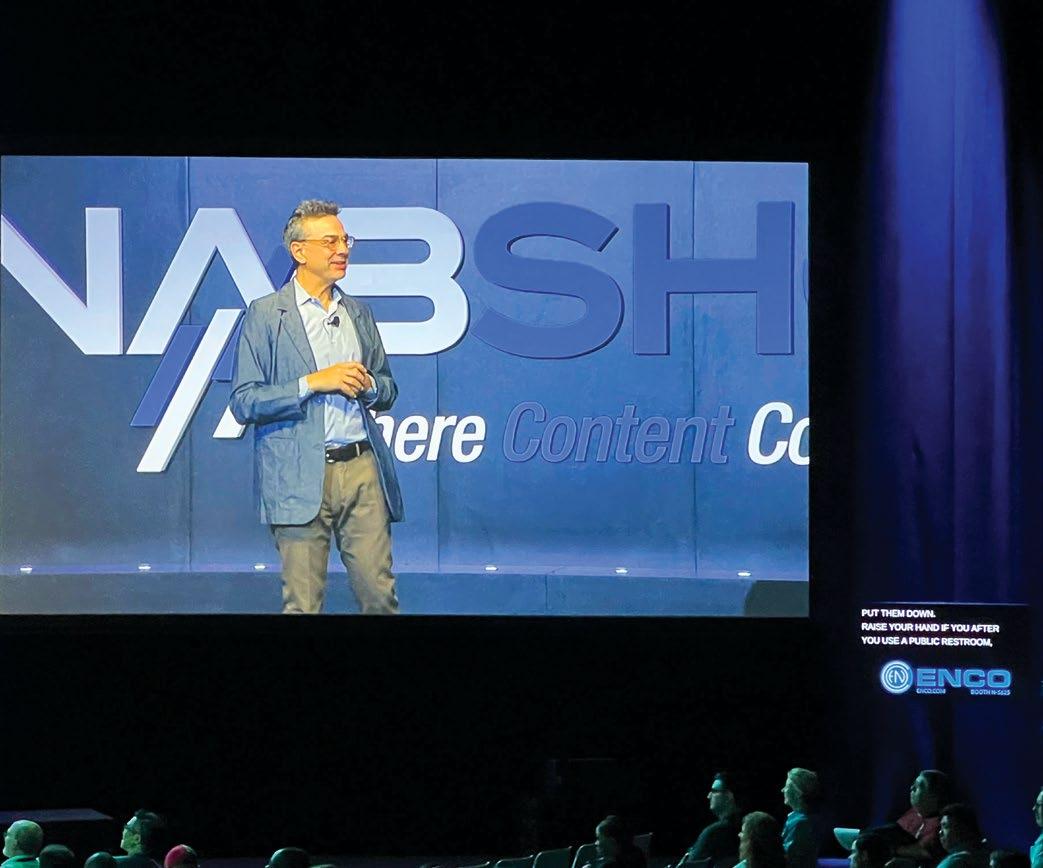
in SDI and IP transmission paths today.
So, you’re designing a new venue, intended to be state-of-the-art in every way (or perhaps upgrading an existing facility). Have you thought about the accessibility of your media? Moreover, have you thought about captions and translations?
No longer are captions necessary for only deaf or hard of hearing people. Considering people whose primary language may not be what’s being spoken on a PA system or in a video, captions can help them better understand what is said. Approximately 48 million Americans have a degree of hearing loss, whether from exposure to sustained loud noises or music, tinnitus, or other causes—your venue’s events will want to ensure everyone can enjoy why they are there.
Captions are so important that some have called them the “third rail” of content, following video and audio. In a venue, you can easily have a spectator wearing earbuds to listen to a play-by-play on the radio and not hear the PA announcements. They can still appreciate what is being said on the PA when it appears as captions on a video display in the venue. Expect this level of “multitasking” to increase.
Increasing numbers of municipal governments of all sizes are also passing legislation requiring captions to be shown for any video content on screens larger than a small desktop monitor—and some want the PA system announcements to be captioned, too. (Imag ine the life safety implications if deaf attendees can’t hear or read essential announcements.) The Ameri cans with Disabilities Act (ADA) also has a major impact on when captions are available.
Most captioning still relies on the same stenographer keyboard, process, and technology that originated in courtrooms more than 100 years ago. However, the technology behind captions has evolved considerably, with AI–based automatic captioning systems growing in popularity.
The process of delivering captions has also evolved, from the manual insertion of lower-third open captions on edited videos in 1972 by PBS (where each line was manually typed and keyed in post-production), to the clever analog video hack of sending caption data through vertical blanking interval (VBI) line 21 to caption live TV, to embedding
Captioning’s usage has evolved in many ways, too, including augmenting live audio announce ments via digital signage, generating meeting and event transcripts, enabling search engines to find words in massive audio and video archives quickly, or delivering live captions to smartphones, tablets, and even websites. However, as with any technol ogy, one broken link in a signal chain or workflow process can completely break an otherwise tight captioning ecosystem.
Venue AV designers, sports presentation teams, and outside broadcasters need to be aware of captions from a variety of sources and destina tions—and as with so many technical elements, there are different formats and standards to inter face with along the way. There are several aspects to consider, including infrastructure requirements, captioning for live feeds vs. recorded content, and choosing between a remote captioning service or an on-premise AI captioning solution.
Are the cabling, routers/switchers, DAs, video monitors, signage displays, and related systems all able to see, decode, or pass-through closed captions from video or caption data for direct display? There is a lot to unpack there. Newer systems, for example, tend to have firmware that can accept and process closed captions (also known as embedded CEA 608/708 captions) or the data embedded in SDI’s VANC field.
But if you have a router that only passes SDI audio and video but no VANC data, that is a blocker. HDMI can be another block—that specification does not support closed captions, so it’s another challenge (the devices that decode the IP streams or over-the-air (OTA) signals are what can render the captions onto the video). Legacy coax MATV distribution systems and modern IP video distribution systems also need to pass along embedded caption data, and, of course, video display endpoints need to be properly equipped (with captions enabled). Same with any streaming encoders; some may not support captions now but are just a firmware update away from doing so, so you need to check the documentation.
New transport protocols such as ST-2110 aim to support embedded closed captions from the start, which will help with those more advanced buildouts (it is crucial to check the technical specs before making the switch). Some venues dedicate particular LED ribbons or video displays for captions of the audio
coming through the PA all the time (historically called CART: Communication Access Realtime Translation).
Other sites key that caption data feed onto a section of their center-hung at least, with the same benefit.
Some display engines can accept a caption data feed directly, which can help give a designer more options on where to display them.
To keep ahead of ADA compliance regulations, you’ll likely need to either send it out to a traditional captioning service for human transcription or run it through an automated, on-prem AI-based captioning platform. Human transcription can take a while and be costly; captioned “sidecar” text files from an AI system take about half the time of the file’s length to produce, but those captions will have to be merged back into the video via desktop editor or during playout from a media management system.
Whether an inbound live feed or something originating in the venue, captioning live content is a very different process than with file-based material. To caption everything heard over a PA system, most legacy workflows require sending that audio to a stenographer outside the venue, who types the captions manually and sends them back to the venue as a data feed for deploy ment. An AI-based, on-prem captioning system is simpler, faster, more reliable, and very accurate.
There is much to consider when designing a media production and distribution system that fully supports all possible variations of captions associated with different forms of live and pre-recorded content.
What gets even more interesting is translation, which converts one language of captioned text into another, making the translated words available to the audience.
Many cloud-based options exist to do this with offline (file-based) projects, but are often more technically challenging if you want to do live, real-time transla tions across different languages. Thankfully, AI technology helps with this, too, and for some lan guages you can even do this entirely on-prem.
Bill Bennett is a media solutions and accounts manager for ENCO Systems.
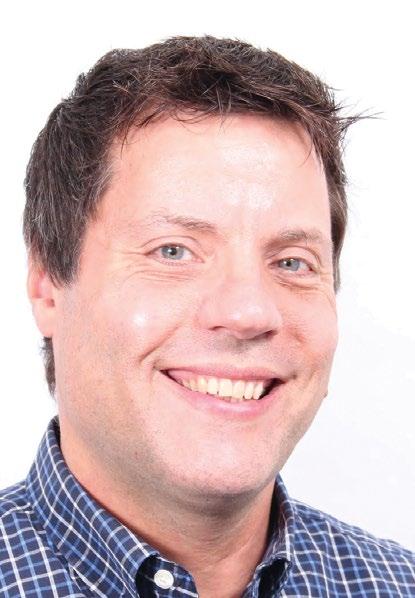
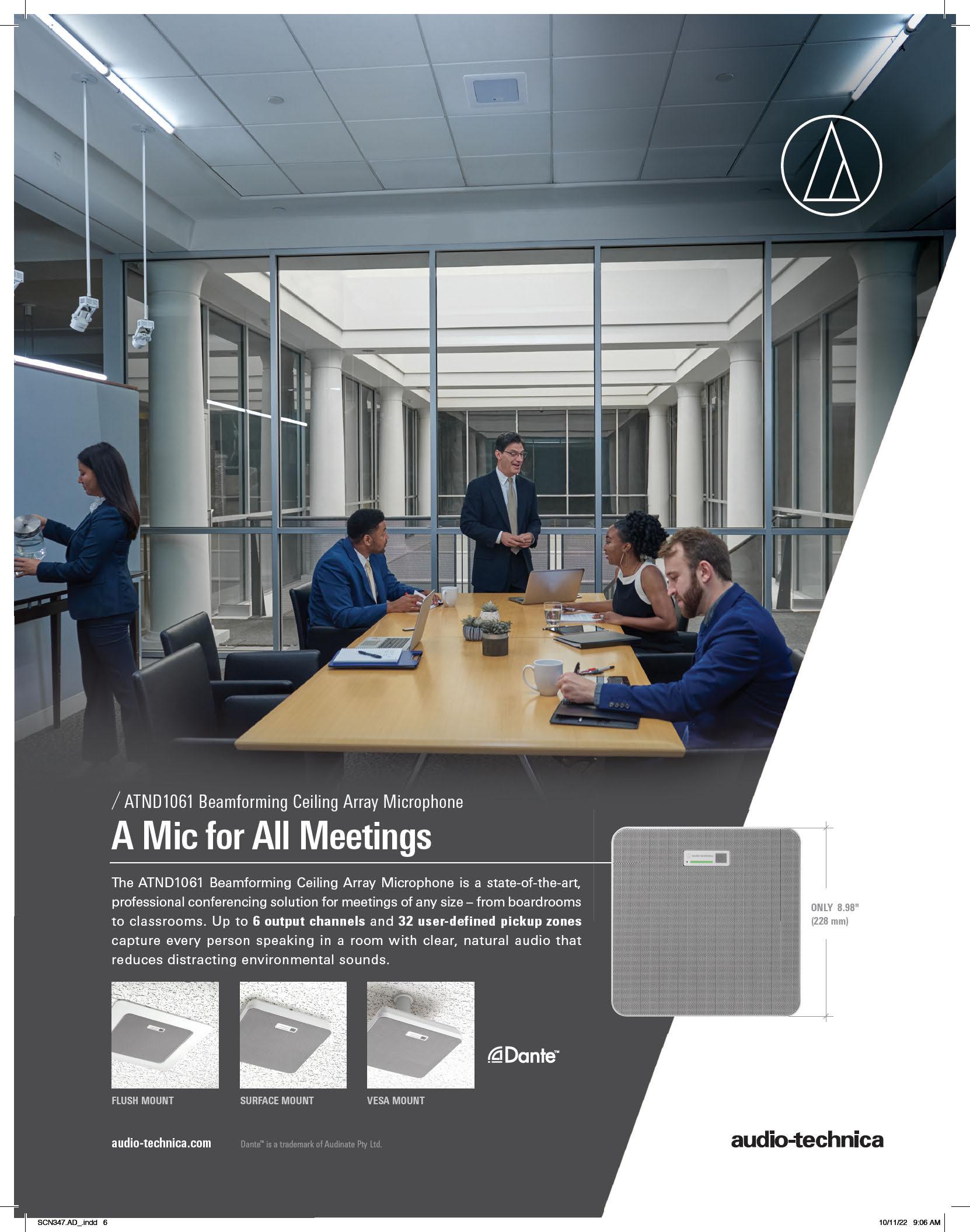
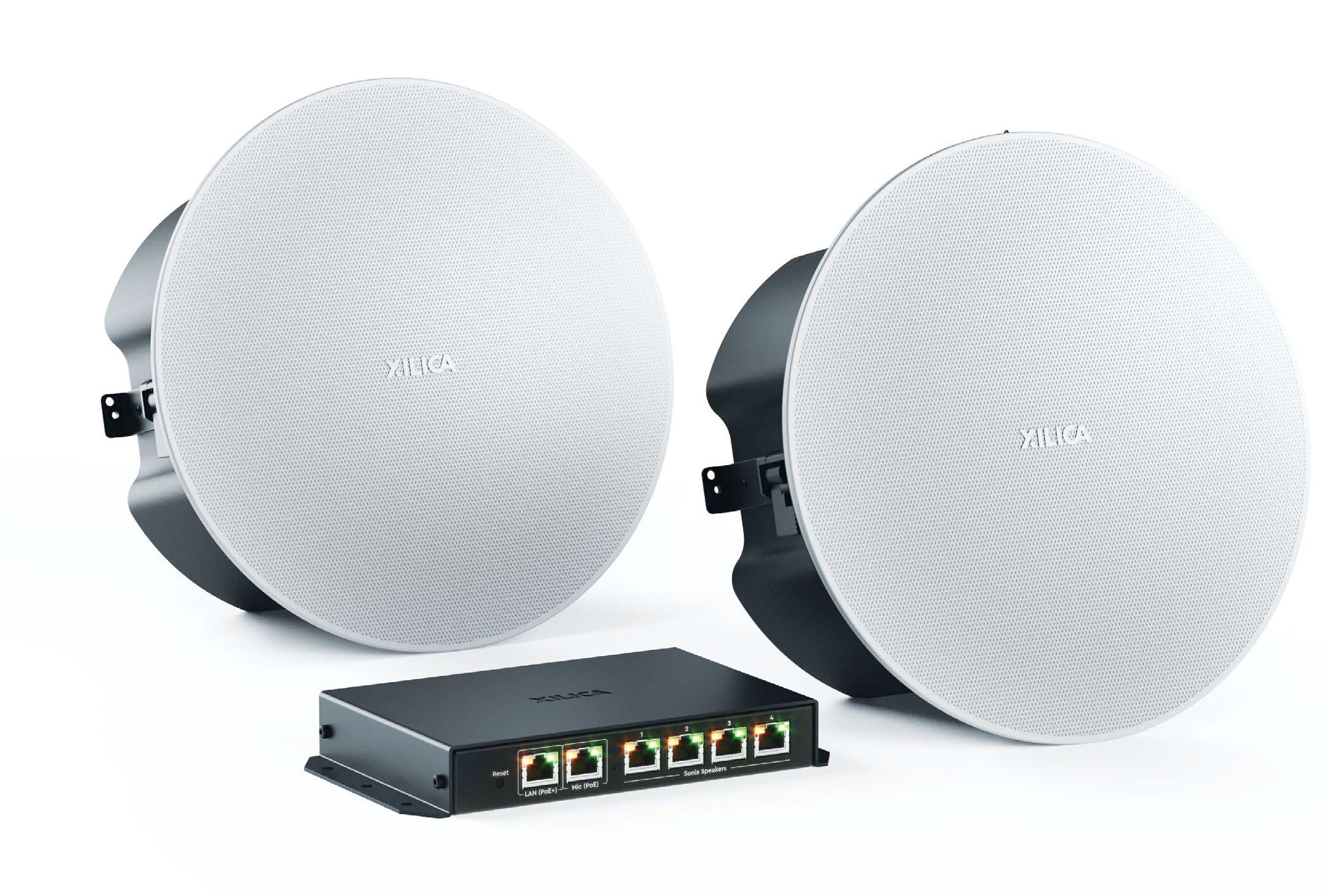 By Chuck Gloman
By Chuck Gloman
Videoconferencing has become the norm since the pandemic. During the isolation stage, people were Zooming rather than traveling to meetings. As a result, the quality of the visuals and sound needed to rise to a new level, so all parties could see and hear everything clearly.
Sennheiser, a trusted name in sound and conference room audio technology, and Xilica, with its state-of-the art amplification and speakers system, have partnered and created the Sennheiser and Xilica Medium Room Kit, which contains the TeamConnect Ceiling 2 (TCC2) Microphone Array, Xilica Solaro QR1 digital signal processor, Sonia Amp, and Sonia C5 speaker system.
Examining the Sennheiser microphone system first, the square, ceiling-mounted TCC2 utilizes 28 Sennheiser KE 10-237 microphone capsules and the company’s automatic dynamic beamforming technology to find and focus on who may be speaking, wherever they might be within the room. If a specific area of the room needs to be singled out, a priority zone can be estab lished and unwanted noise sources may be removed via its exclusion zone software.
Obviously, the human voice is the most critical factor when capturing audio in a meeting or conference. Using Sennheiser’s TruVoicelift technology, the intelligibility of the speech is increased and amplified. The TCC2 may be mounted on the ceiling one of three ways: slightly below the ceiling, suspended from it, or flush using the extension brackets.

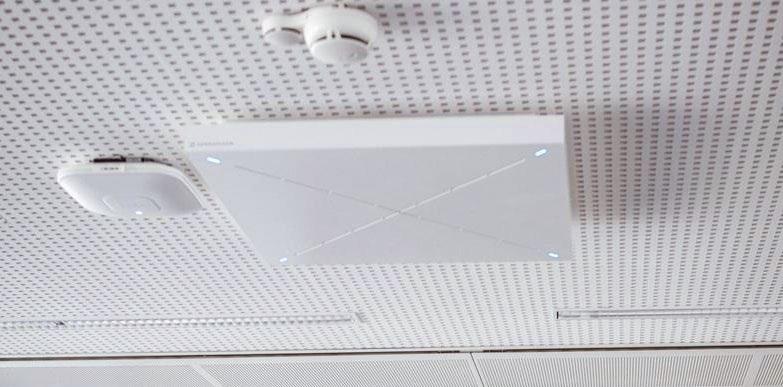
The back of the unit contains the connection ports:
Dante primary and secondary Ethernet (RJ45) sockets for redundancy, three-pin analog out (for Phoenix Contact MCVW 1.5-3-ST-3.81), and the Ethernet Power over Internet (PoE)/Ctrl socket, if you’re using software or a media control system to configure the system. There’s also a reset button that restores everything to the factory settings.
The next item in the chain is the Solaro QR1 DSP. The 2-pound, 6x4x1.65-inch black box mounts almost anywhere using the supplied mounting brackets. My review unit had five installed card bays and three blanking cards.
Internally, the dual core Linux processor with 40-bit floating point architecture handles all your audio filtering needs. On the front panel, LEDs indicate an active audio input, audio output, network connection, and power. There are also two RJ45 ports for PoE and Dante. The back of the QR1 includes an analog audio in, general purpose I/O (GPIO), analog audio out, and 2x2 USB audio.
To amplify and power your room’s speakers, Xilica’s Sonia Amp four-channel audio amplifier fits the bill.
Also powered by an Ethernet connection, up to eight speakers can fill the environment with sound. Not needing the usual copper speaker wire, Ethernet (RJ45) and Category cable make the installation faster. The fanless, convection-cooled amp weighs less than a pound and mounts easily to the back of any C5 speaker.
Just one Category cable drop is needed for the entire system. The amplifier offers up to 15 watts for a single channel of audio and consumes only 30 watts when powered by a PoE+ network or power injector. The back of the amp has a reset button, Ethernet LAN and microphone port, and four Ethernet Sonia speaker ports. The microphone port provides network connec tivity and PoE power to the ceiling microphone array, eliminating the need for additional cable drops.
Completing the system are the 5.25-inch, 5.5pound Sonia C5 Speakers using Ethernet cabling. These suspended ceiling speakers mount with the included tile brackets. The 8 ohm loudspeaker has a low-frequency 5.25-inch transducer and a .75-inch-high frequency transducer, and delivers a 180-degree angle of sound.
Each speaker has four ceiling panel clamps in the rear, which secure the speaker to the ceiling tile, as well as two Ethernet connections under a screw-secured connector cover. If you are using two speakers, attach an Ethernet cable to one speaker’s input and the other end to the Sonia Amp, then connect the second speaker to the first speaker via Ethernet. Both the Sonia Amp and Sonia C5 speakers are plenum-rated.
When I first received the Medium Room Kit, my initial intention was to mount the TCC2 flush with the drop ceiling in our new wing’s conference room. However, due to construction delays (thanks, supply chain), I instead decided to use our existing 15x20-foot conference room. The installation instructions included were easy to follow, and with the extension brackets, everything I needed was included.
The Sennheiser Control Cockpit is an optional but very useful accessory. Although not required, it helps with the specific configuration of your TCC2 and allows live monitoring while in use. Without this piece of equipment, however, I couldn’t test canceling out specific noises or selecting whom I wanted the microphones to follow.
Before I could begin with the installation,
The TeamConnect Ceiling 2 (TCC2) Microphone Array can be mounted slightly below the ceiling, suspended from it, or flush using the extension brackets. The Xilica Sonia Amp can connect up to eight speakers.though, I loaded up on Ethernet cable. Using a Non-DHCP enabled network, I needed to manually enter the IP address information from the Xilica Designer software after I installed it on my PC. Then, I ran an Ethernet cable from the PC to the Xilica Solaro QR1 LAN RJ45 port (cable one).
Using the Xilica Sonia Amp, the Ethernet cable looped from the QR1 to the LAN (PoE) port (cable two), then connected the mic output to the input on the Sennheiser TCC2 to power the microphone array (cable three). Still another Ethernet cable attached to the Sonia Speaker input on the Amp (cable four) and out to one of the C5 speakers (cable five), with the last Ethernet cable looped from the other free C5 port to the second speaker (cable six).
The Solaro QR1 does improve and enhance the understanding of the human voice. Every environ ment has acoustical obstacles to overcome, from
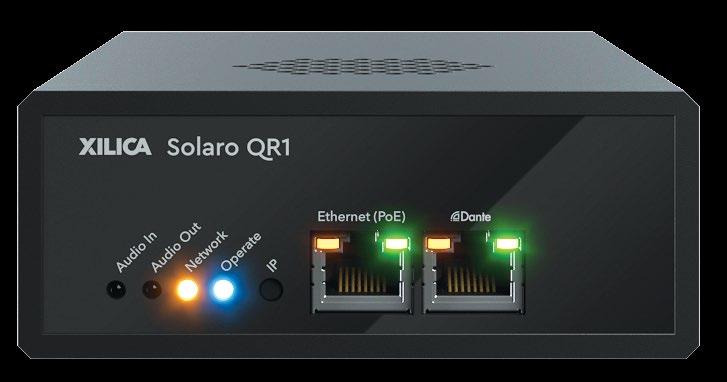
walls to windows to ceilings, etc. None of this seemed to be a problem for the QR1. Anytime I can sound more intelligent, I’ll take it. (I guess I’ll have to carry the QR1 with me everywhere.)
For our temporary install, I used our existing conference room with a 10-foot suspended ceiling. The TCC2 was attached with clamps to the suspended ceiling. The QR1 and Sonia Amp remained on the conference room table, while the two speakers were setup on C-stands at about head level. Again, this was a makeshift, not permanent, arrangement.
I saw very few challenges with setup. You don’t really need extensive installation skills, and it’s essentially a plug-and-play system. As long as you have the components, you are just connecting everything together. I would recommend having someone familiar with cutting the Ethernet cable to length from a spool and adding the connectors.
The TCC2’s sound was excellent. Sounding like a high-end lavaliere (rather than a shotgun micro phone), the mics in the array clearly picked up each speaker with an almost omnidirectional pattern.
There was room noise that the Sennheiser Cockpit Control would have eliminated, but the extraneous noise wasn’t overly objectionable. Once installed, the TCC2 is forgotten and blends in with the existing ceiling. I was distracted slightly by the blue lights, but that’s just me.
The Sonia C5 speakers spread the sound through out the room nicely. Many factors could have hindered that, including the number of people in the room, as well as the fact that hard surfaces reflect sound and soft surfaces absorb sound. I’m not an engineer, but if the speakers make the sound clear and understandable, I’m happy.
The Zoom meeting began and the Sennheiser array picked up the sound from both sides of the room. As the test subject, I purposely walked around the room to see if the sound was picked up. Not having the Sennheiser Control Cockpit, I couldn’t map out exactly what I wanted, but the sound was great, anyway.
The Sennheiser and Xilica Medium Room Kit has everything you need for your online meetings, apart from cabling. Installation is a breeze—and consider ing the same type of cable connects it all together and supplies power, there’s nothing keeping you from sounding better for your next meeting.
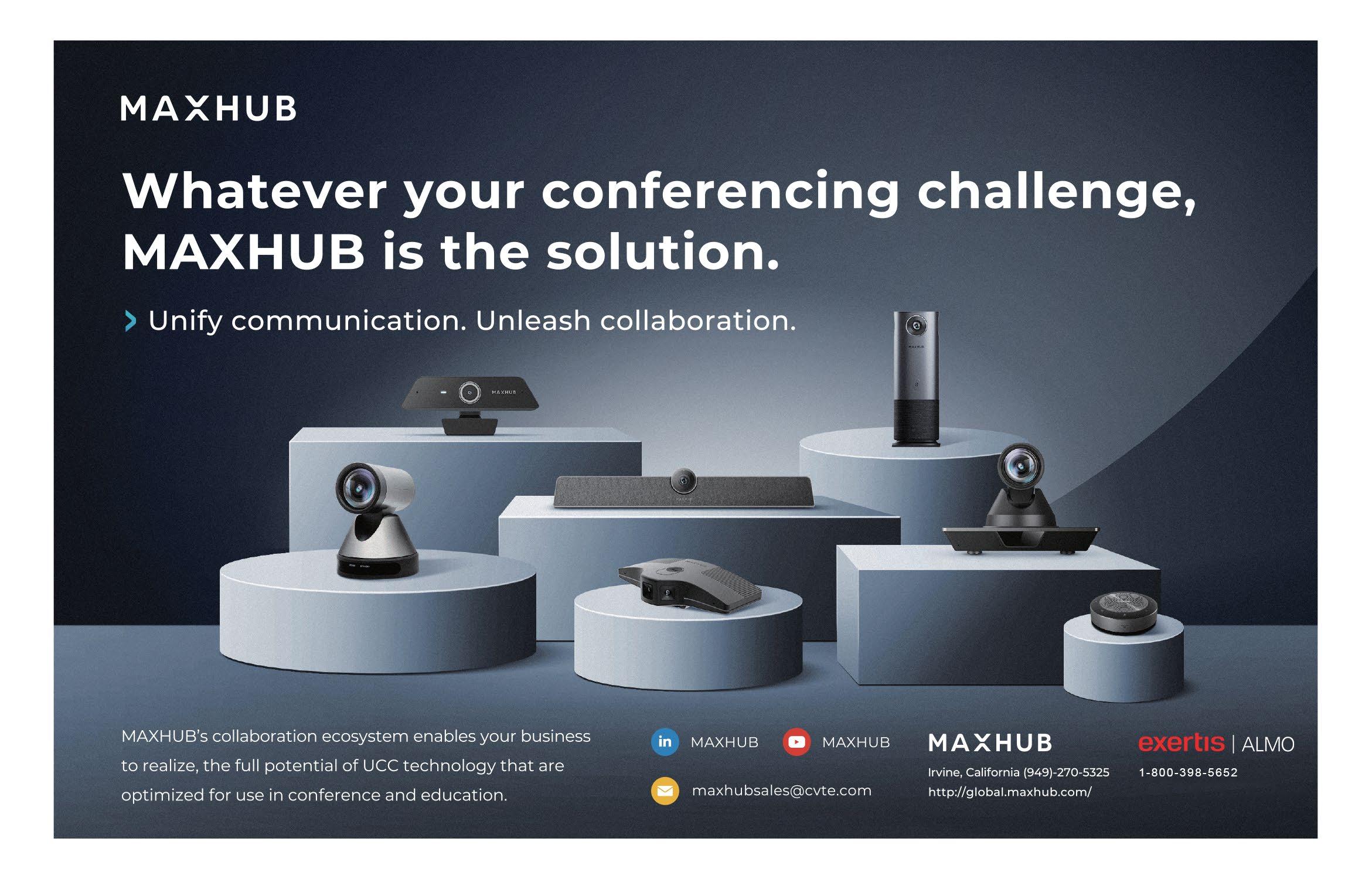
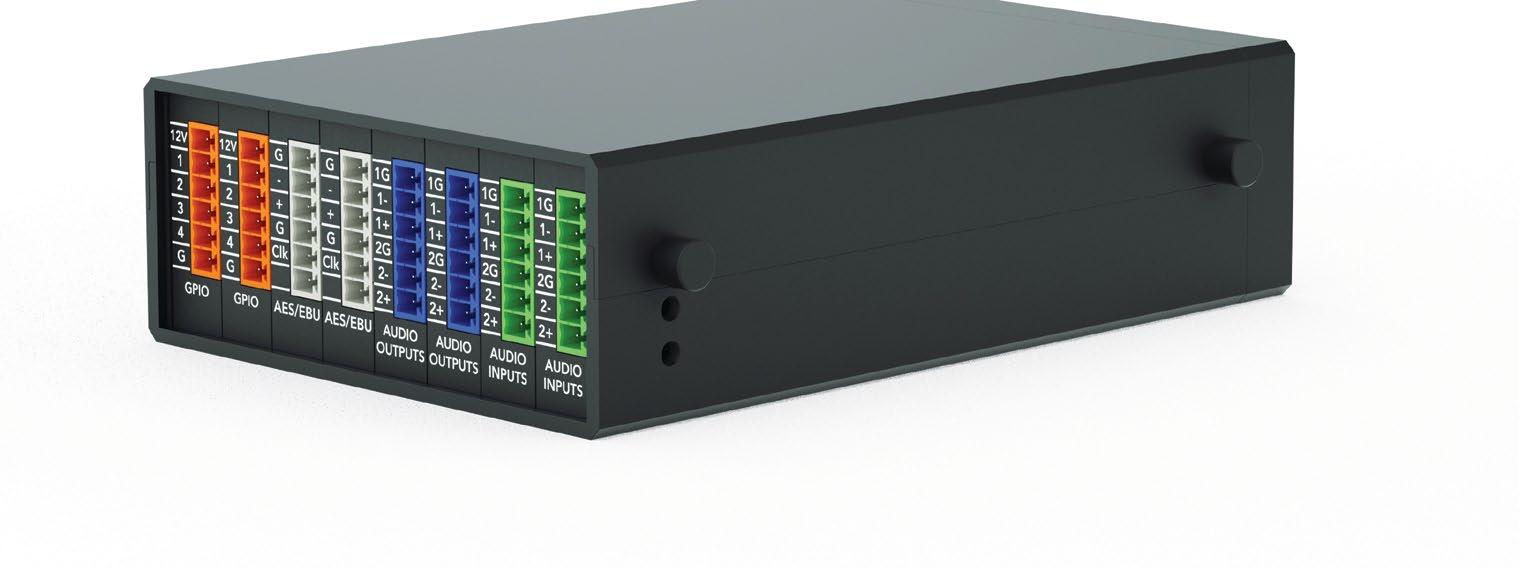 The Solaro QR1 handles the audio filtering needs for the kit.
The Solaro QR1 handles the audio filtering needs for the kit.
interest of Pro AV professionals this year? We reviewed the product announcements published on avnetwork.com since January 2022. The following group includes products from articles that earned the most clicks from curious readers. In other words, we’re not picking favorites— we’re picking favorites!
What
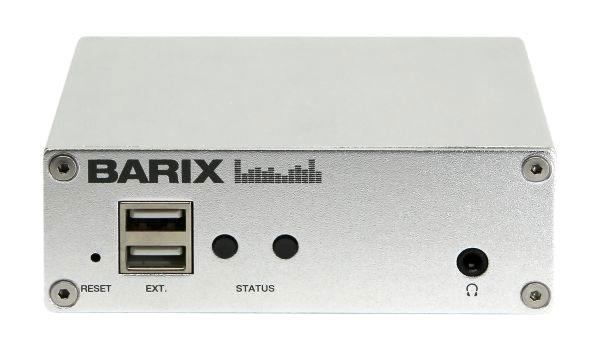
The Paging Gateway M400 hardware enables paging from smartphones into almost any existing analog public address system. Users can easily send announce ments through a web browser (no app needed) from Android, iOS mobile phones, or and computer on the local network. The hardware can also be used to extend Barix’s advanced IC complete, IP-based paging and two-way intercom platform in schools, businesses, and public facilities. This enables mobile phones and computers to be used as zone-capable paging stations in new or existing IC paging deployments. The user simply selects the zones to page into, and IC paging automati cally routes the announcements to the right speakers or zone amplifiers. Access protection ensures only authorized personnel can use the system.

Crestron’s enhanced software platform enables enterprise IT managers to deploy and scale room configurations quickly without sacrificing function ality. Crestron VC-4 allows IT specialists to design and configure a room’s UC, AV, and control solutions, save those configurations, and then automate them in a fraction of the time, significantly cutting down labor costs for common applications by streamlining the custom configuration experience. Since it is integrated with standard programming languages, including C# for IT and SIMPL for AV professionals, it does not require any new training to execute. VC-4 also comes equipped with the XiO Cloud Technology Operations Management platform, providing device lifecycles management, control, and remote support to maintain operational standards and maximize room uptime efficiently at scale, while providing enhanced data insights from a single dashboard.
The HYPERVSN SmartV Platform opens the possi bility of interactive holographic content, as the platform is built on Android, which enables customers to develop custom widgets for their brand. In 2022, a larger but lighter 3000-nit HYPERVSN SmartV high-bright model launched, which can be connected to camera, voice, and tablet controls. Other external triggers, such as motion sensors or Internet data sources, can be used to trigger the HYPERVSN SmartV display, providing the user with a completely interactive experience. Committed to sustainability, the enhanced SmartV uses fewer pixels to create the same high-resolu tion imaging, with the new HYPERVSN SmartV devices having a power consumption rate below 50W on average.
Plug-and-play simplicity and wireless convenience come together in this single-channel wireless micro phone. Ideal for webcasting and cloud-based collabora tion through Microsoft Teams, Zoom, WebEx, GoToMeeting, and other apps, the DIALOG 10 is also ideal for public events, live streaming, classroom presentations, and conferences. An included USB-C cable connects to any PC for audio, power, and control. Wide audio bandwidth provides superior speech clarity, and ultra-low audio latency significantly enhances the audio experience. Offering a robust frequency-hopping, spread-spectrum technology, with no frequency license restrictions worldwide, the auto-scan feature finds open channels for optimal reception, and standardsbased FIPS 197 AES-128 encryption ensures a secure link for wireless audio.
This zero-setup, plug-and-play auto-tracking camera features flexible options for nearly any setting, as well as built-in compatibility for a range of system configu rations. Users can simply unbox the camera, plug it into a USB 2.0 connection, and start recording or streaming with motion tracking—no software setup required.
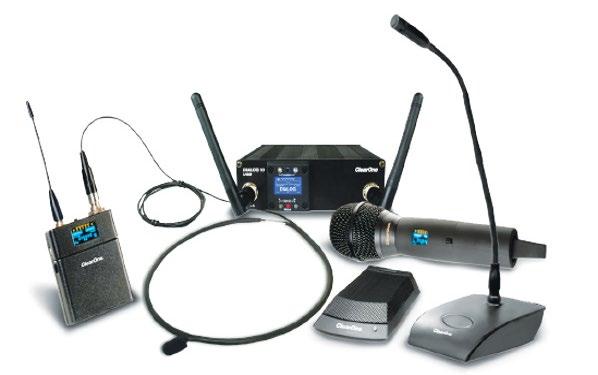
Thanks to its 20x optical zoom, the 1080p camera can be positioned up to 50 feet away from the subject. With a 59.5-degree field of view and 270 degrees of rotation, those being recorded are free to move about the tracking area. Fully compatible with most videoconferencing, lecture capture, and learning management systems, it can be easily integrated with practically any existing hardware due to its NDI|HX, USB, IP, SDI and HDMI output options.
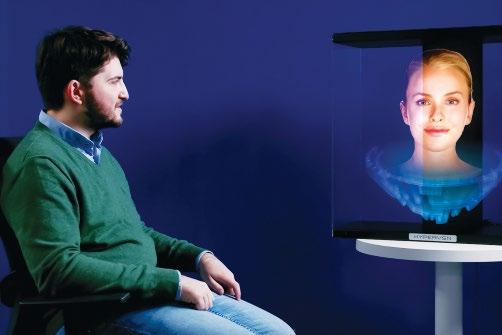
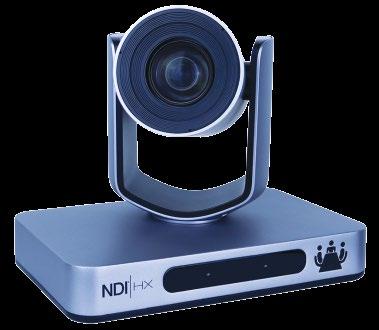
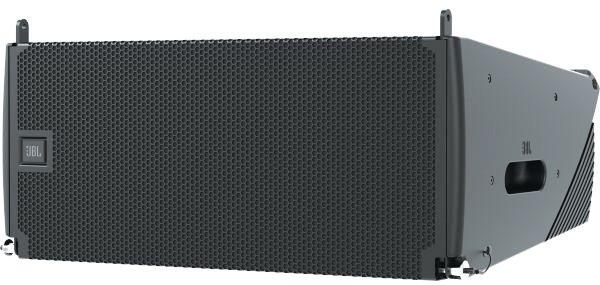
The SRX900 Series offers a complete system solution—including speakers, subwoofers, and accessories—that support a range of configurations and simplify storage, transport, and rigging. The latest family from JBL Professional includes dual 6.5-inch and dual 10-inch powered line array elements and 18-inch and dual 18-inch powered subwoofers, making it ideal for rental companies, fixed installations, and musicians seeking the combination of performance and portability. SBX900 Series speakers showcase acoustic innova tions like JBL’s patented Radiation Boundary Integrator (RBI), which mounts both the high and low-frequency transducers on a single horn, improving horizontal dispersion while minimizing cabinet size. SRX900 models feature built-in DSP that provides everything users need to optimize and tune their systems, including 24-band parametric EQ, 2,000ms of delay, and gain control.
The new 136-inch All-in-One DVLED display from LG Business Solutions USA combines a 1080p screen, on-board webOS controller, and built-in speakers to offer immediate operation in virtually any environment. With the new model, technology integrators can say goodbye to complicated
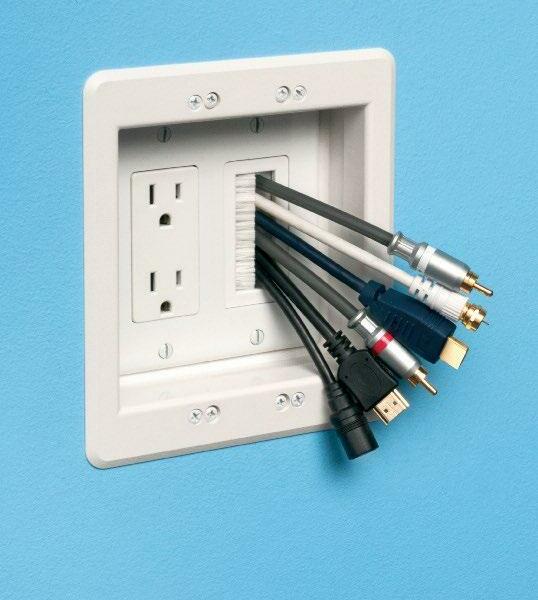

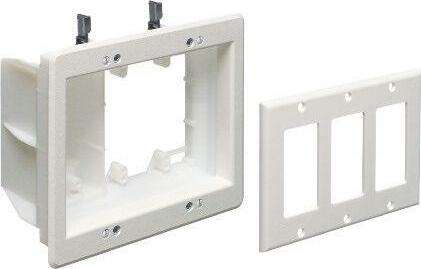
installation procedures and wiring. The display can be installed in one day and includes every compo nent necessary to serve a variety of needs and installation locations. Operating at up to 500 nits of brightness and featuring a 4.6mm bezel, 1.56mm pixel pitch, and total resolution of 1920x1080, the display has a rated lifespan of 100,000 hours to half-brightness. LG designed the cable-free LED modules to literally snap in using a magnetic tool, making the process virtually foolproof for integra tors, and enabling much faster installation than other dvLED display options.
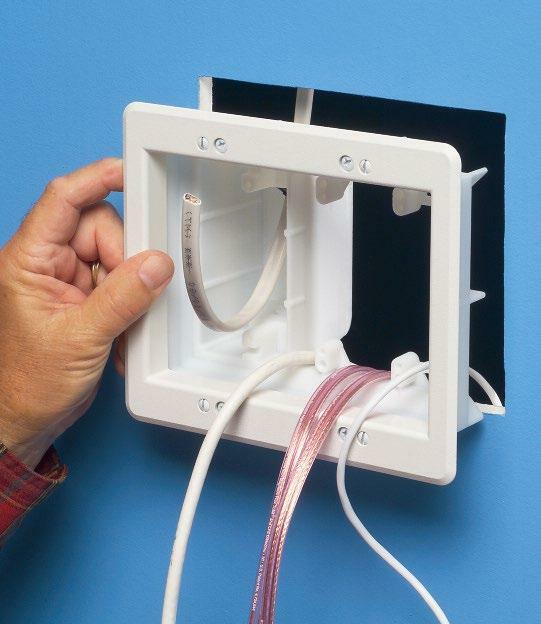
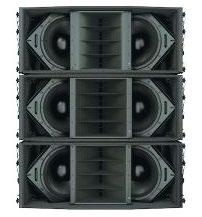
The Panther family consists of three cabinets with different horizontal coverage patterns: the Pan ther-M (95 degrees), Panther-W (110 degrees), and Panther-L (featuring an all-new long throw horn with a tightly defined 80-degree horizontal pattern). Panther also features new, longer-excur sion, 12-inch low-frequency cone drivers and new 3-inch compression drivers. Each incorporates advanced magnet structures using new materials for higher flux density despite substantial weight reduction. Combined with a new LF port design, Panther has a maximum peak output of more than 150 dB SPL. Weighing only 150 pounds, Panther is a significantly lighter box than anything in its class. Reduced weight means more Panther loud speakers can be flown on a single motor, and larger arrays can share the same truss and hang points with extensive video and lighting gear.
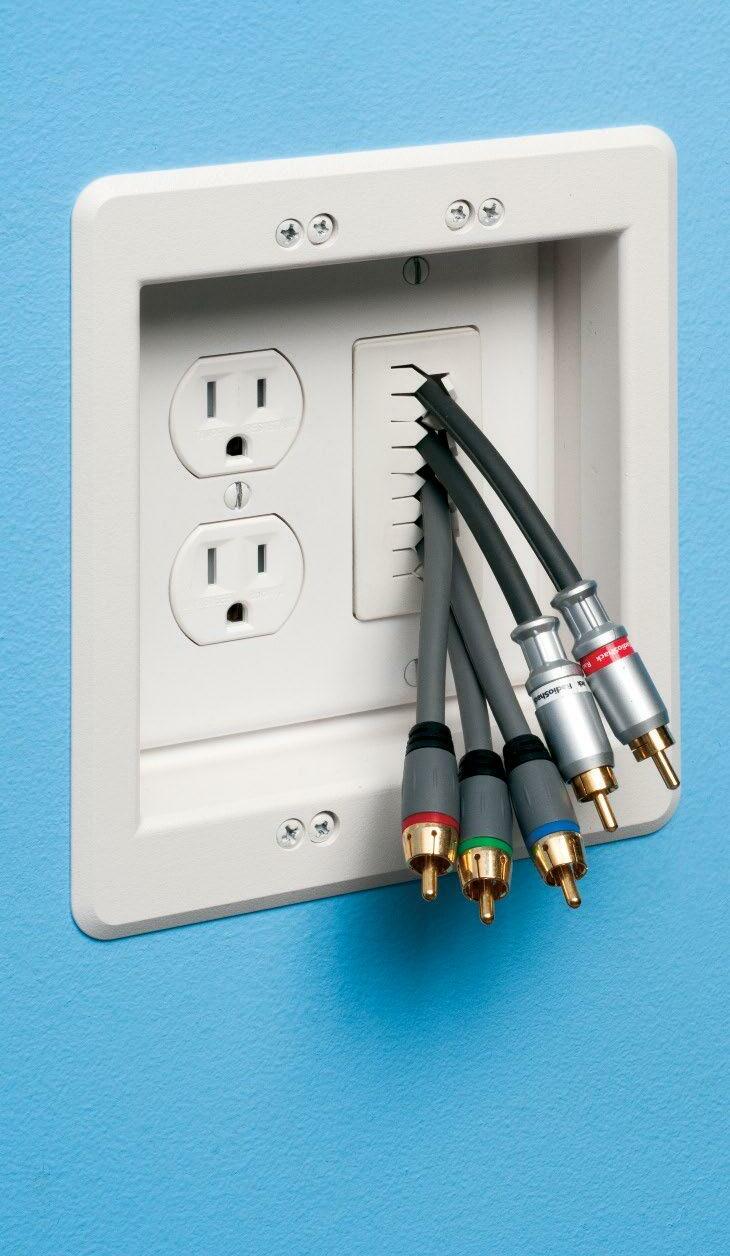

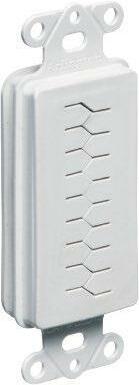
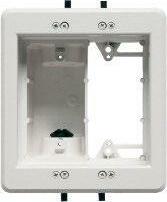
With Automatic Coverage technology, MXA920 provides pre-configured audio capture with minimal setup required, reducing the time and cost of deployments for integrators. The MXA920 also employs next-generation array architecture for enhanced directional pickup and more natural speech. The onboard IntelliMix DSP delivers noise and echo-free performance as well as audio clarity and intelligibility for AV conferencing across room types—executive boardrooms, higher education hybrid classrooms, corporate, and government
meeting spaces. Two form factors (square and round) support design integration into even the most sophisticated facilities and meeting spaces. The MXA920 is also certified for Microsoft Teams and has versatile mounting options for in-ceiling, on-ceiling, pole, or wire rope installations.
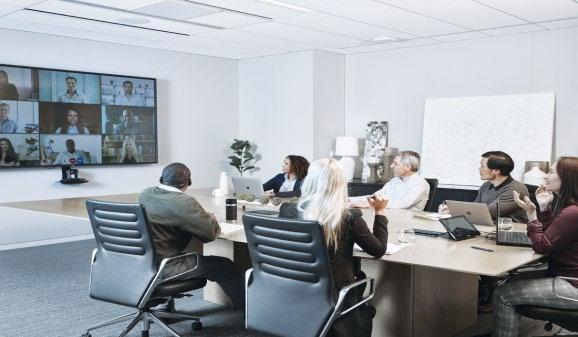
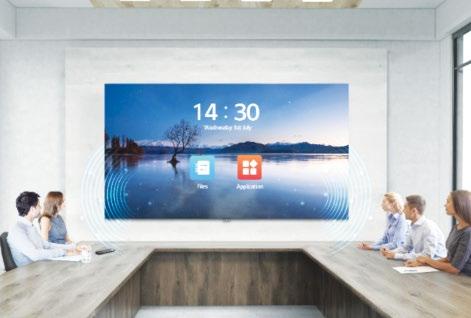

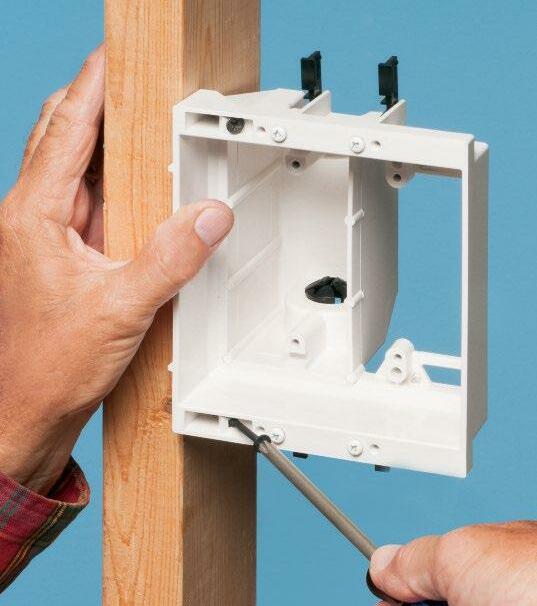
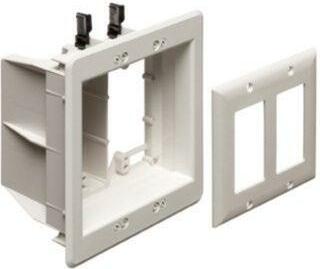
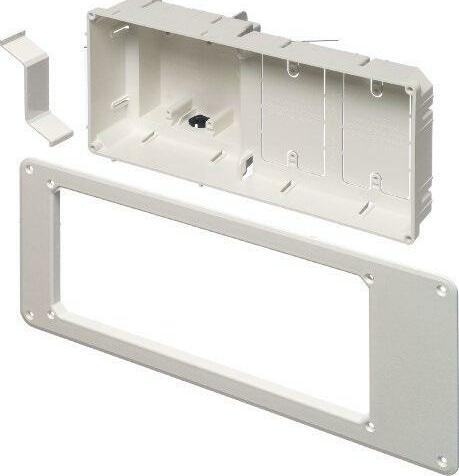
They say seeing is believing. But what hap pens when you don’t want to be seen?
In today’s evolving world of hybrid classrooms, meeting rooms, and even houses of worship, having the right technology is important, especially when needing to be heard. However, the right speaker can be invasive, with wires and bulky devices taking away from the aesthetics of the venue. In-ceiling speakers sound like an easy choice—but they aren’t a one-size-fits-all solution.
“The choice of in-ceiling speakers boils down to weighing coverage versus imaging and sound stage,” said Randy Blanchard, director of audio for Vanco. “They’re not appropriate for environments with extremely high ceilings—an eight-story hotel lobby, for instance. There are also times where you’re going for a strong directional, like live sound reinforcement, where you really want a point-
source system.”
So, when are in-ceiling speakers right for your project?
One of the advantages of in-ceiling speakers is they are architecturally pleasing. There is nothing jutting out from the walls or taking up valuable real estate on the floor. Being able to blend in with the with the interior design and not disrupt sightlines is a big deal.
“In commercial applications, including pro gram audio for hospitality and retail, public address, and emergency notification systems, in-ceiling speakers offer superior coverage uni formity—a well-designed system will deliver the same sound pressure and frequency response at every listener position, so no one misses any important messages,” said Blanchard.
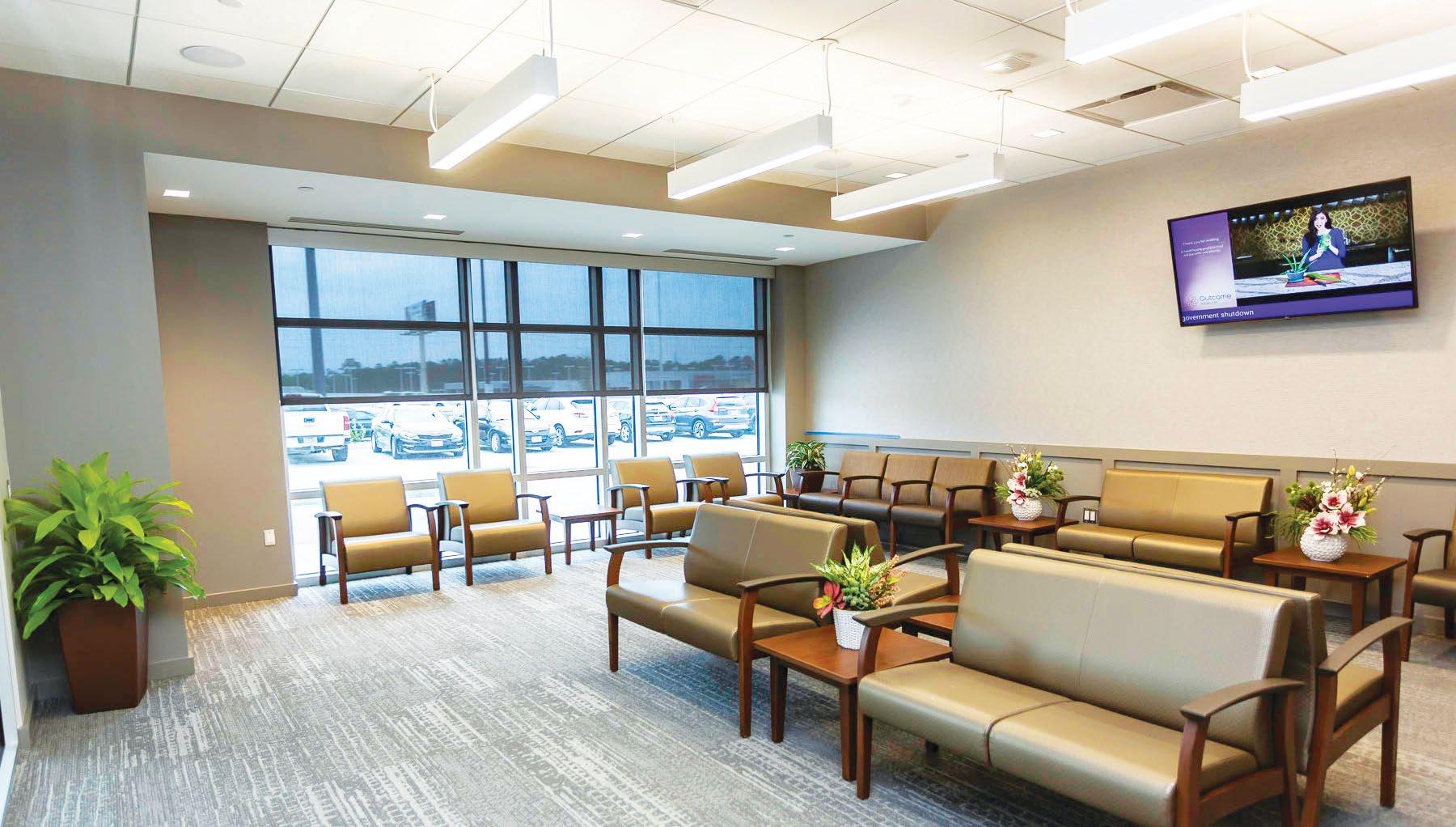
“It’s often difficult to project sound from a stage or wall-mounted speakers to the far side of a room,” added Rick Kamlet, senior global product
manager for installation loudspeakers, JBL Profes sional. “The result can be sound that’s too loud for the close listeners while being too soft for the farther-away listeners. Ceiling speakers can provide consistent sound levels for all listeners.”
“An in-ceiling speaker is another tool in the box for the sound designer, and careful consideration and design principles should still be applied to maximize intelligibility and coverage,” explained Graham Hendry, vice president of loudspeaker strategy at AtlasIED. “A good example of choosing in-ceiling speakers over surface-mount solutions would be in wide rooms with low ceilings. A distributed in-ceiling system will maintain the relative distance from the listener to the speaker and provide even distribution of SPL [sound pressure level] in a space.”
As with any audio upgrade, in-ceiling speaker installations offer some challenges. Kamlet said selecting the right speakers and an effective layout are affected by many factors. His list of installation considerations includes how reverberant the room is, as well as the height of the ceiling and the ceiling structure. Will paging be done through the system, and will there be “zoning” requirements? If so, the system will need to be designed for intelligibility. And, of course, what’s the budget?
“Typically, integrators face challenges with the amount of space above a ceiling and coordinating speaker locations with other trades,” added Joe da
Silva, vice president of marketing at Extron. “To make the design process easier, Extron offers several online calculators for speaker placement, power requirements, and more. Rooms with restricted space above the ceiling often benefit from low-profile speaker options.”
“It’s also important to remember that sound waves are physical vibrations that affect their environment,” Blanchard said. “Speaker operation can knock loose dust and debris, which can then fall into an unprotected driver and cause buzz or other distortions. Vibration from the speaker can also cause cracks in the drywall near the mounting. A well-tuned enclosure is the best solution for most of these issues, that will both protect the speaker elements and direct more sound energy through the front of the speaker, limiting negative effects from vibration or bleedthrough.”
While there are many choices, it sure seems like round speakers are the way to go. “Round speakers are so popular for one reason, and it’s less to do with the aesthetics and everything to do with installation,” said Hendry. “Simply put, it’s easier and takes less time to cut a round hole than a square one in a ceiling. Of course, square grills can be optional.”
Installation can be time efficient, which is highly valuable in turnaround times, especially when it comes to form factor. “Lay-in ceiling tile speakers eliminate the need for the installer to cut ceiling tiles, which can be time-intensive and can cause a mess,” said Kamlet. “In addition, because the ceiling tile form factor is wide, the speaker can be made fairly shallow, allowing it to fit in locations where deeper loudspeakers may not fit, or where there may be obstructions in the ceiling.”
With these types of speakers not being mounted, do they still provide solid sound? Hendry said the stigma of an in-ceiling loudspeaker being an inferior solution should be long gone.
“An in-ceiling speaker can be full bandwidth,
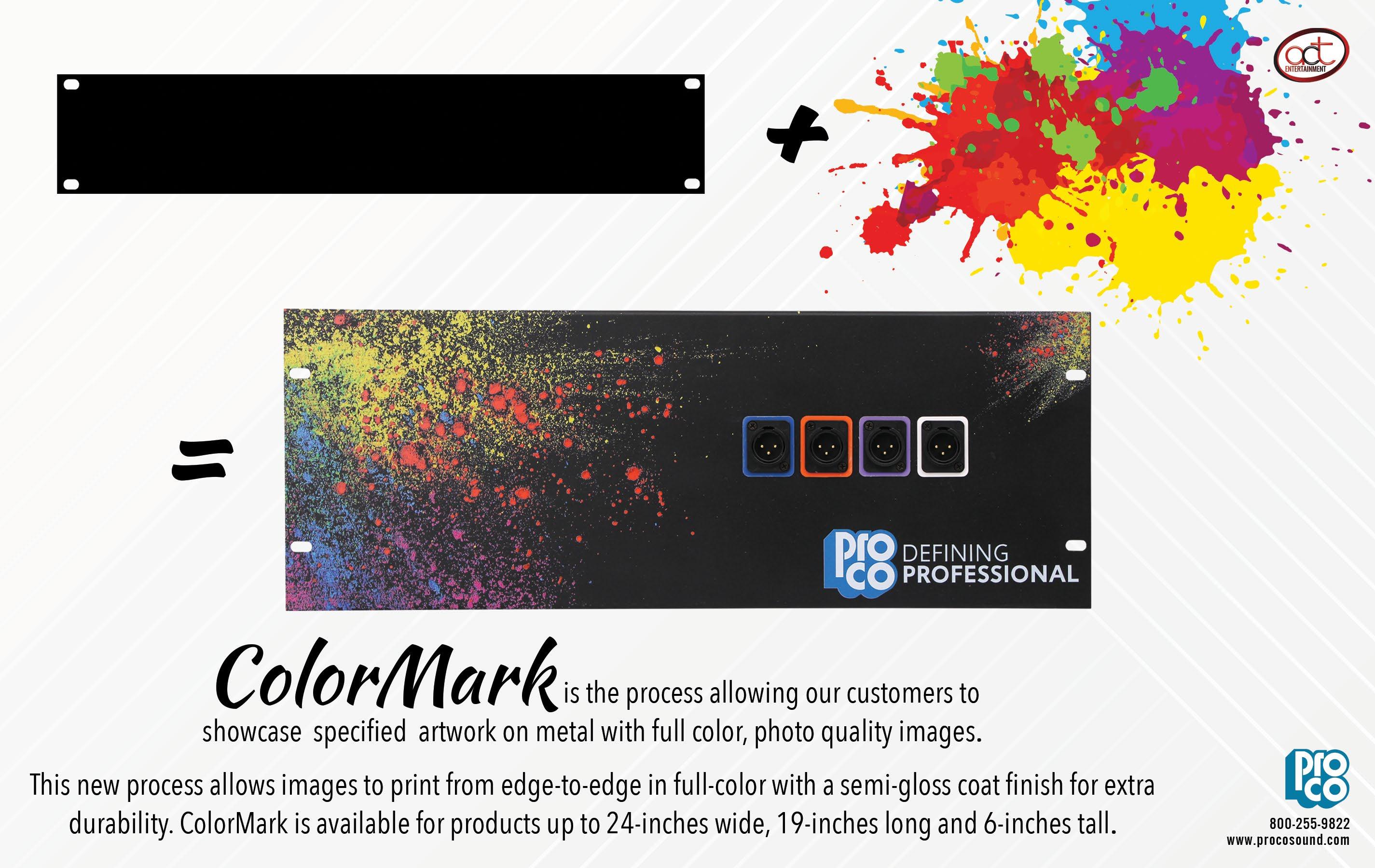
high sensitivity, with excellent constant directivity characteristics,” Hendry added. “In-ceiling speakers may be used in installations along with conventional surface mount loudspeakers installed in various other parts of the same project, so it’s important to have consistency throughout. Most of the audience under an in-ceiling loudspeaker will not be on axis with the loudspeaker, so off-axis performance should be a massive consideration— and one that is often overlooked.”
“A distributed in-ceiling speaker system provides even coverage across an entire area,” explained da Silva. “It’s very easy to leverage 70V/100V amplifiers to power dozens of speakers per channel, ensuring listeners are able to hear the audio wherever they might be within the facility. Wall-mounted options can sometimes be too loud
“A distributed in-ceiling speaker system provides even coverage across an entire area.”
Joe da Silva, Extron
near the speakers and not loud enough away from the speakers. In-ceiling speakers are also visually discreet, practically disappearing into a room.”
“They can sound incredible, but it takes a bit of extra engineering,” noted Blanchard. “In-ceiling speaker performance is highly variable—far more so than cabinet speakers.”
In-ceiling speakers can be paired with other solutions, such as subwoofers, for example. “But you cannot defeat the laws of physics,” Hendry cautioned. “A subwoofer, in essence, needs a specific amount of volume to create a specific amount of low frequency bandwidth. Generally, a ceiling subwoofer will be physically larger, and the challenge is disguising that amount of real estate in the ceiling.”
“Subwoofers require a lot of airflow, they tend to create resonances in the wall or ceiling cavities that can be transmitted into adjacent spaces and negatively affect the performance of the speaker,” added Blanchard. “They also tend to lose a lot of sound energy out of the back because low frequen cies require so much more energy to direct. They really need a backbox to be remotely consistent, but most backboxes also consistently limit their performance by restricting airflow.”
How valuable are pendant speakers in installa tions? While they are not quite in-ceiling speakers, they serve an important purpose in several use cases, like installations with high ceilings and open ceilings. It brings the speaker much closer to the listener, providing somewhat better coverage in that situation.
“Many spaces are built with open high ceilings for aesthetics, but still need even coverage. For these situations, pendant speakers offer an ideal solution,” da Silva explained. “Pendant speakers are also a great compliment to traditional in-ceiling speakers. Many spaces combine open ceilings with drop-tile ceilings, so Extron’s family of pendant speakers are voiced consistently with matching in-ceiling speakers to make for a smooth auditory transition as people move from one space to another within the facility.”
Understanding the many features and logistics of today’s in-ceiling speaker is half the battle. Finding the right one is the other half. Here is a selection of in-ceiling speakers from an assortment of manufacturers to consider.
Featuring a curved profile, AtlasIED designed the SHS-3T2-HD specifically for use in shallow, hard
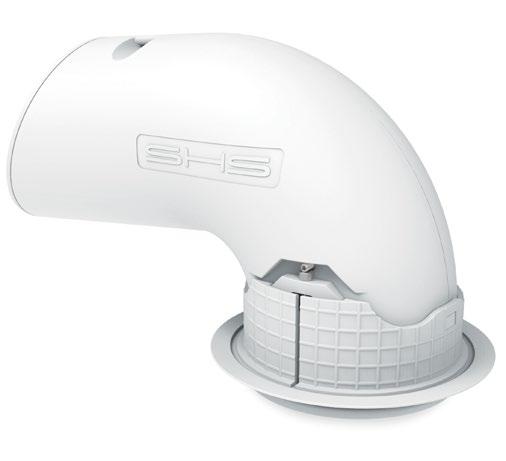
deck ceilings that can’t accommodate a larger plenum footprint of the SHS-6T2 or SHS-3T2. This simple-to-install, discreet, low-profile audio solution is even more powerful thanks to AtlasIED’s Adaptive Dispersion Lens Technology, which consists of a 3-inch diameter lens and a micro trim ring. The SHS-3T2-HD expands the high-quality sound capabilities of the company’s Strategically Hidden (SHS) line into a wider range of commercial environments.
Bose Professional FreeSpace FS2P (Pendant)
FreeSpace FS loudspeakers are engineered for high-quality performance in both back ground music and voice announcement applica tions, making them ideal for almost any commercial space. The line includes five loud speakers, two distinct levels of sound, new mount ing options, and a modern aesthetic to match. For those seeking consistent, quality installed sound, the FS2P is a dedicated pendant model with a full-range 2.25-inch transducer, low frequency range down to 83 Hz, and sensitivity of 87 dB SPL / 1W @ 1m.
The Electro-Voice EVID-C4.2LP is a low-profile (3.7-inch deep), 4-inch coaxial two-way ceiling loudspeaker system featuring a wave guide-coupled titanium-coated dome tweeter. Both UL1480A and CSA 22.2 205 certified, it utilizes a second-order crossover network at 2.5 kHz, with a comprehensive protection circuit to protect the network, woofer, and tweeter drivers from exces sive power levels. The low-profile enclosure makes it easy to mount in very tight spaces.
requirements for smoke and heat release in plenum air spaces. A magnetically attached grille with a thin-edged bezel gives the SF 26CT series a refined appearance on the ceiling while offering direct 8 ohm and 70/100V operation.
SPK–IC6 is a fire-rated, 40W in–ceiling speaker with a 1-inch titanium
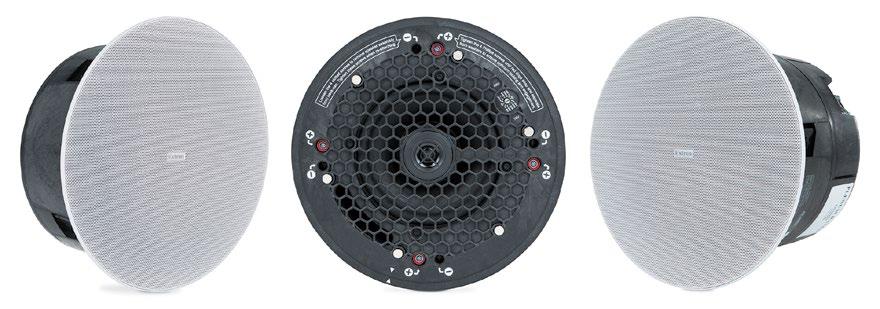
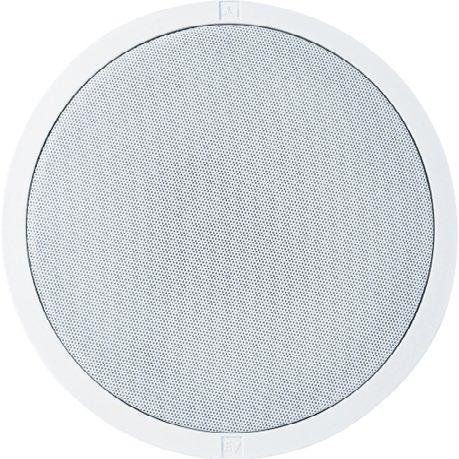
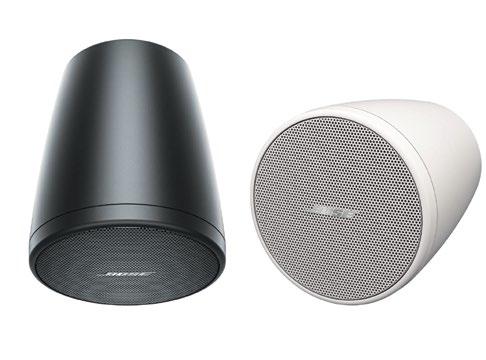
dome tweeter and a 6.5-inch graphite cone driver with rubber surround. The SPK–IC6 includes taps for 8 ohm, 100V, and 70V audio solutions and comes in a plenum fire rated back box. SPK–IC6 is perfect for classrooms and lecture halls, as well as medium to large meeting spaces.
The Control 45C/T is a premium in-ceiling profes sional loudspeaker designed for applications that can benefit from extremely wide bandwidth and very consistent coverage from a ceiling speaker with a small footprint. It is designed with a consistent 120-degree broadband pattern control featuring JBL’s Radiation Boundary Inte grator (RBI) technology.
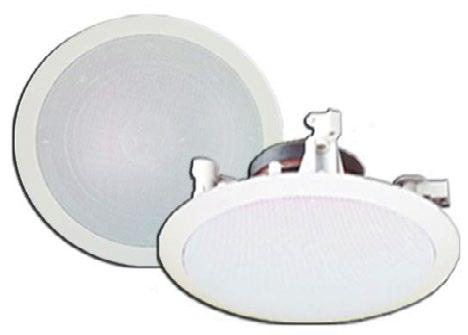
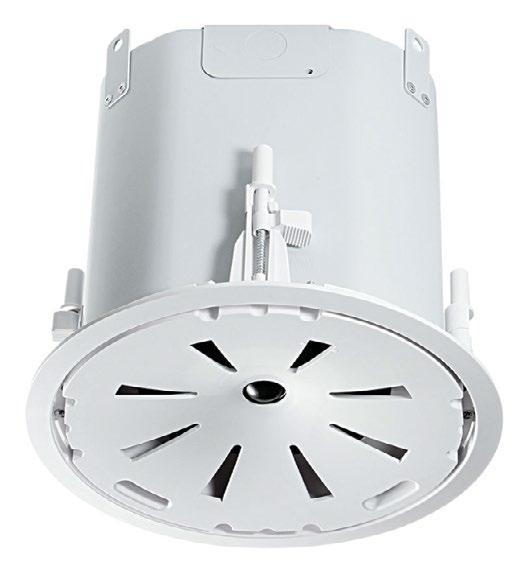
These in-ceiling speakers are both UL listed and CE certified with a 5.25-inch full range. Its white aluminum grill is paintable to match the style of installations, including covered outdoor settings. It provides plenty of power with 0.0625/0.125/0.25/0.5W at 25V, 0.5/1/2/4W at 70V, and 1/2/4/8W at 100V.
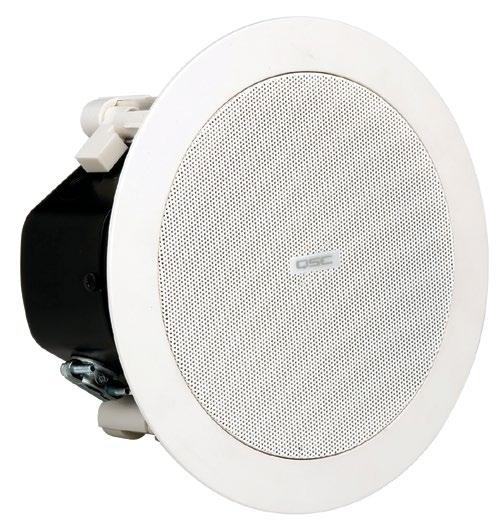
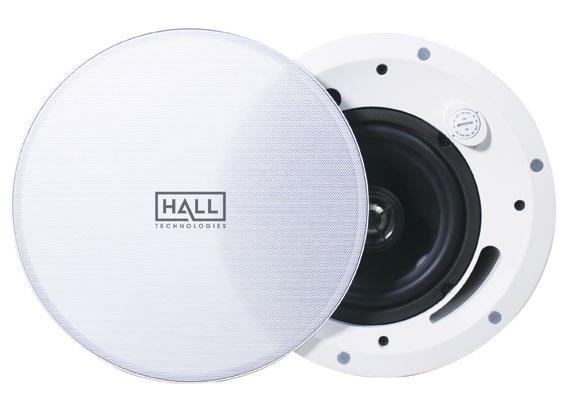
The SoundField XD SF 26CT models are 6.5-inch two-way ceiling speakers featuring an 8-inch or 4.2-inch deep composite back can for use in standard or restricted height ceiling environments. The driver complement includes a 6.5-inch woofer coupled to a 3/4-inch ferrofluidcooled dome tweeter. The SF 26CT series meets stringent UL
The Q-SYS NL-C4 is a network PoE loudspeaker that delivers clear speech and music repro duction natively to
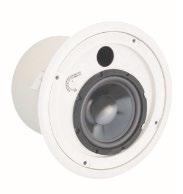
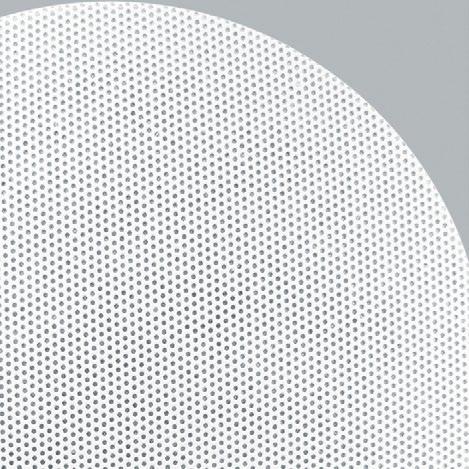


Q-SYS. The ceiling-mount loudspeaker features a 4-inch, full-range driver, and can be integrated into the space with a single Ethernet cable to reduce the overall hardware footprint and lower system cost. As a native Q-SYS product, users can take advantage of the drag-and-drop integration and simple control capabilities offered by Q-SYS.
All CM series speakers are designed specifi cally for low and suspended ceilings. SoundTube’s in-celling speakers dramatically reduce installation time with the SpeedWing con stant-tension mounting system, while the four-pin Euroblock connector speeds up wiring, daisy-chain ing, and prewiring. The CMi Series incorporates low-profile styling and seamless coverage in a one-piece, integrated unit. Using BroadBeam technol ogy, the CM models greatly expand the coverage area, providing full-frequency dispersion and reducing the number of speakers needed for an installation.


The FB-3862CU is a high-per formance, flush-mount ceiling subwoofer assembly for low frequency enhancement of distributed loudspeaker systems. A 60W 70/100V transformer is included, and the bandpass design eliminates the need for a bi-amplified system. The 8-ohm bypass allows for applications using electronic crossovers and dedicated low impedance power amplifiers, offering a full spectrum sonic experience suitable for retail environments, restaurants, lounges, conference rooms, and any application where music or video content require high-quality sound.
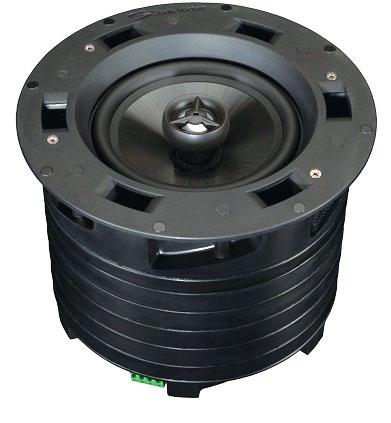

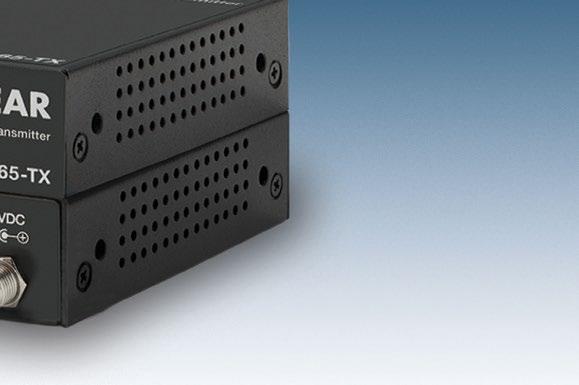
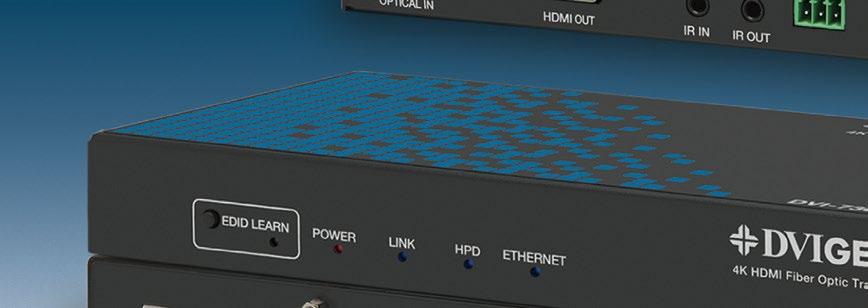
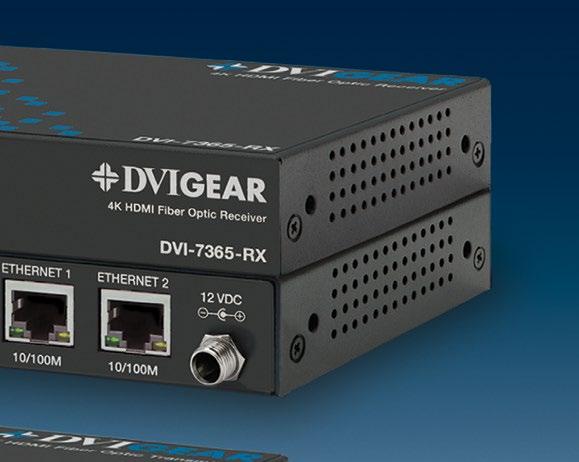


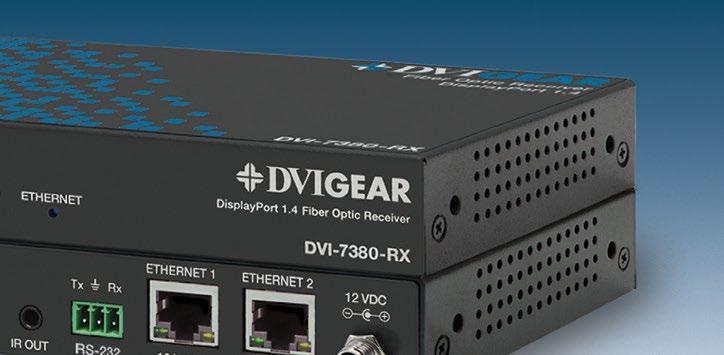
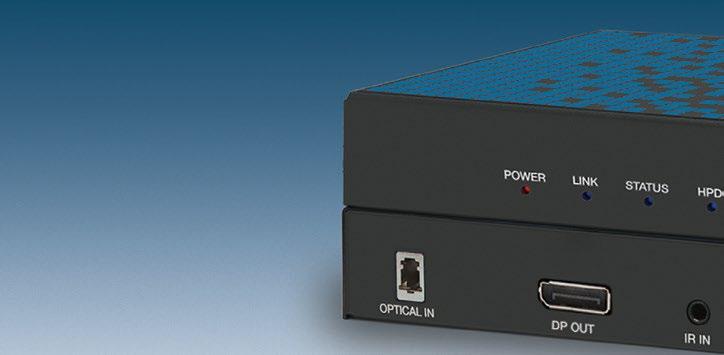

IC53




Triad’s IC53 speaker is engineered for music enthusiasts who are looking for excep tional sound in every room. This speaker utilizes a woven
carbon-fiber woofer for superior bass response and durability. A 1-inch silk dome tweeter offers smooth, high-frequency sound and is aimable to offer greater installation flexibility.
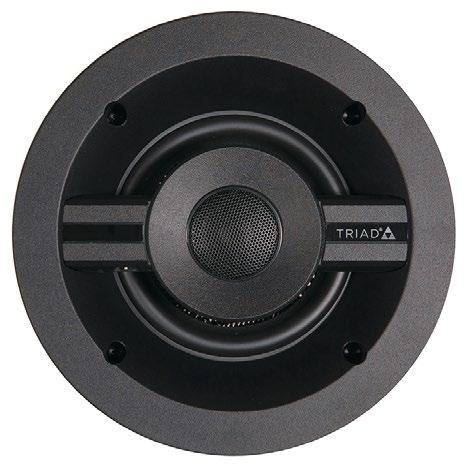



The Beale Street Audio architectural speaker line’s patented Sonic Vortex enclosure directs all sound energy into the listening area, with no bleedthrough to adjacent spaces or harmful resonance. As a result, Beale Street Audio delivers deep, rich, bass with a 6-9 dB boost over traditional architectural loud speakers with the same enclosure size. The TIC801 8-inch 70/100V in-ceiling loudspeaker brings Sonic Vortex performance to constant voltage applications, with a 35Hz–24KHz frequency response and a 92 dB sensitivity. It features an 8-inch fluted poly woofer and a 1-inch aluminum pivoting tweeter.

The new BrightSign XD5 lineup of media players includes two models, the XD235 and XD1035. Both have been carefully engineered to deliver inspiring 4K experiences for any enterprise-level digital signage application. The upgraded 4K HTML engine is optimized for responsive interactivity and display of real-time dashboards through significant upgrades to HTML rendering, motion graphics, and JavaScript performance. Hardware-accelerated 4K content rotation and a dynamic mosaic mode add flexibility to the authoring and playback experience. Power over Ethernet (PoE+), a perfected industrial design, and a stable supply chain of components make BrightSign’s new XD5 lineup a highly reliable solution to meet or exceed any enterprise digital signage need now and well into the future. All BrightSign media players feature BrightSign OS 8, the company’s proprietary operating system purpose-built for digital signage.
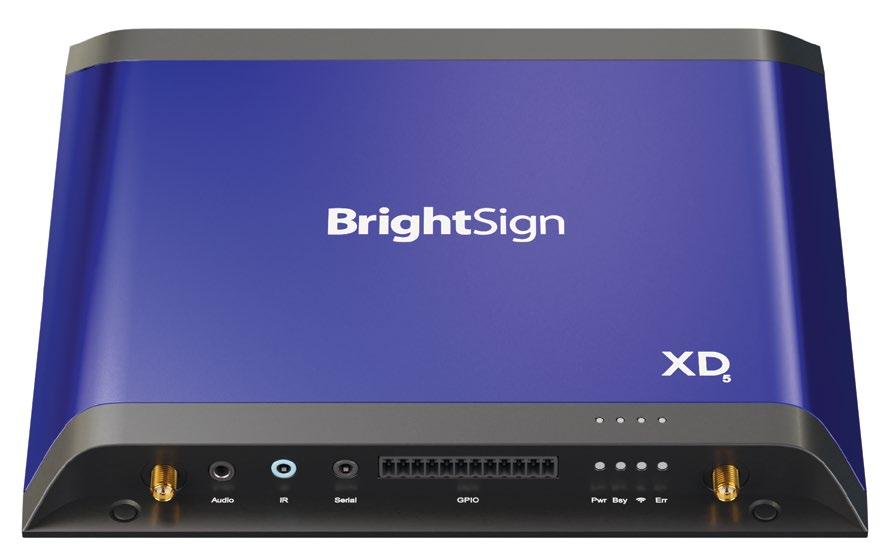
Building off its popular Terra LuminSound outdoor speaker portfolio, Leon adds a new, taller model to the line. The Terra LuminSound Bollard speaker features the same handcrafted components and built-in low-voltage lighting as the shorter landscape version but stands taller, thanks to a 21-inch aircraft-grade aluminum base. At an overall height of 32 inches and available with both halo and adjustable pathway lighting, the Terra LuminSound Bollard beautifully defines and enhances any outdoor commercial environment. Incorporating audio and lighting in one compact, IP67-rated waterproof enclosure, the Terra LuminSound Bollard is built to withstand harsh climates. It’s available with commercial-grade LED lighting that can be adjusted to illuminate pathways, landscaping, and architectural details. The speakers blend discreetly into a variety of regional landscapes, thanks to a choice of seven different finishes.
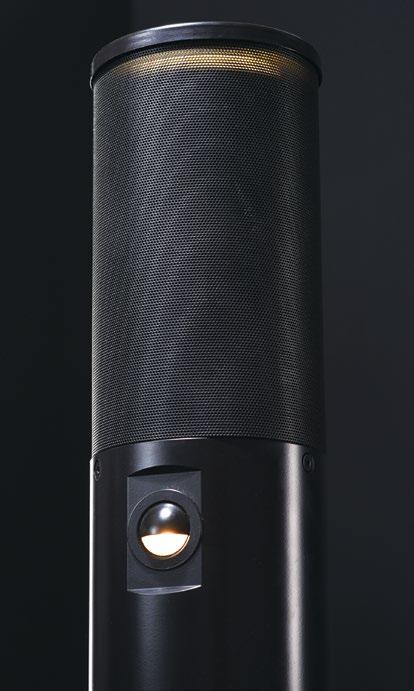
Short for Software Optimized Appliance Revolutionalized, FOR-A’s new SOAR-A line marks the company’s direction toward a software-based strategy for a variety of applications. First out of the gate are the SOAR-A Edge Server, which is expandable to 16 channels, and the two-channel SOAR-A Edge Mini. Both provide powerful RIST, enabling the secure and synchronized packaging of audio and video for transfer. With WebRTC (Web Real-time Communication) compatibility, SOAR-A Edge can stream video without a gateway from any browser to any browser. It supports seamless switching, low-latency previews, and cellular bonding for faster connections even from the most challenging locations. The SOAR-A system serves content creators transitioning to all flavors of IP, and the SOAR-A workflow enables highly secure REMI production and gateway-free streaming.

environments. The built-in control processor delivers robust capabilities to maximize integration with connected devices, including support for two-way drivers, the RTiPanel Mobile App, and use as either a standalone processor or as a secondary processor in larger configurations. Back panel connections enable direct control of connected devices via IR, IP, RS-232, six voltage sense ports with sense-event capabilities, and four relays for control via contact closure.
With the launch of RackMac Studio and xMac Studio professional rack mount systems for Apple Mac Studio computers, Sonnet offers pro content creators multiple options to fulfill their workflow requirements. The RackMac Studio is an enclosure to install and secure one or two Mac Studio computers. Available in three configurations, the xMac Studio holds a single Mac Studio computer plus a Thunderbolt-to-PCIe card expansion module (the same card modules used in the DuoModo line). Both systems are only 3 RU, designed to fit in standard 19-inch equipment racks, and include space beneath each computer that enables users to securely store connected Thunderbolt or USB SSDs behind a panel.
The new KX4 touchpanel with built-in processor simplifies single-room commercial installations, from boardrooms to lecture halls, that require both on-wall control and processing power to control multiple devices. It combines a 4-inch capacitive touchscreen and five-button configurable interface (that can be customized with RTI’s Laser Shark engraving) with a control processor for fast and cost-effective installations in all single-room
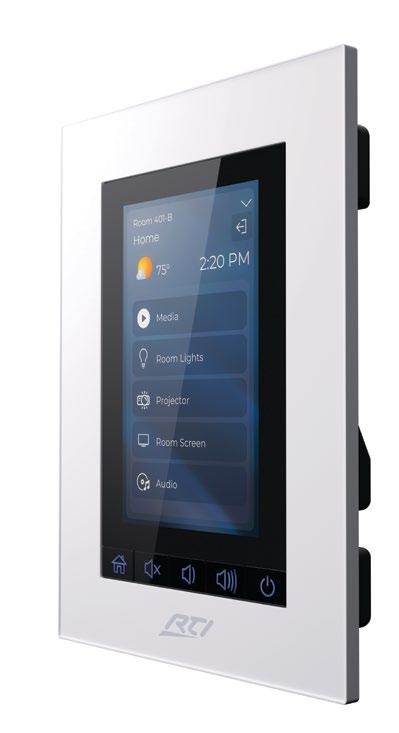
Engineered to cost-effectively deliver sophisticated video wall displays using consumer panels and monitors, the new Key Digital KD-VW4x4ProK 4K UHD video wall processor and seamless matrix switcher is an all-in-one solution featuring four HDMI inputs and outputs, plus four mirrored UHDoTP outputs, providing signal extension to four included KD-EXMLVRx UHDoTP receivers. The KD-VW4x4ProK has functionality that optimizes its use with consumer video displays. Bezel compensation allows the image to be extended off screen to create fluid screen transitions between co-joined monitors. Five supported video wall layouts make the KDVW4x4ProK ideal for building budget-friendly video walls for any application. Source selection in video wall or matrix modes is seamless. Audio routing is independent of video source selection, with deembedding on optical digital connections on each KD-VW4x4ProK output.

The UC P25 PTZ 4K UHD camera brings complete videoconferencing clarity to meeting spaces of all sizes. With a 12x optical and 16x digital zoom, the UC P25 PTZ ensures that every meeting participant is highlighted in detail. Designed with hybrid working
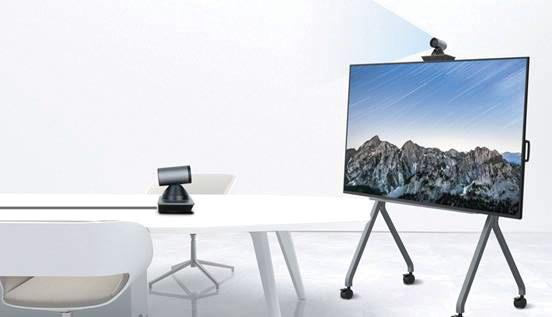
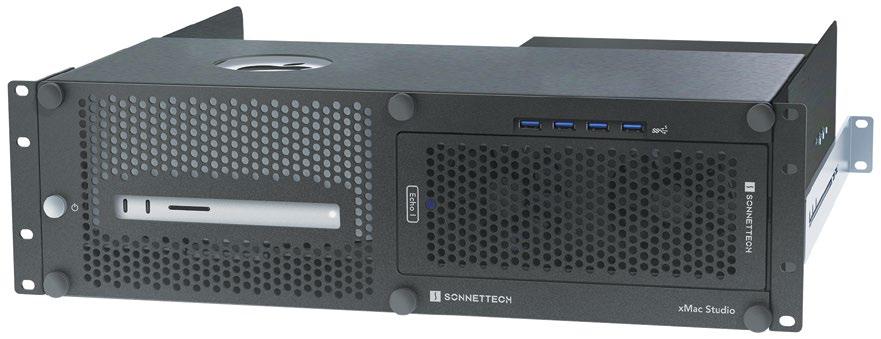
in mind, the camera neutralizes any disruptive glare and shadows, presenting crystal-clear picture quality in all conditions. In addition, the camera has an adaptive PTZ system with quiet mechanical controls, so meetings can remain distraction-free. The 8MP camera also has built-in low-lux technology and intelligent algorithms to showcase brilliant color and detail, while a built-in gravity sensor automatically adjusts to match the user’s mounting choice. Allowing for plug-and-play simplicity, the camera also seamlessly integrates with all major unified communications (UC) platforms.
the efficient front panel design. The NX1 offers fast boot times, instant operation, and the ability to process eight universes right inside the console. The NX1 is also expandable with the dedicated NX P motorized playback wing, which replicates the full playback section of the NX1, and the compact USBpowered NX K keypad, which replicates the full keypad and command section of larger consoles.

The compact, lightweight NX1 is the newest member of the ONYX family of lighting consoles, designed to handle a variety of shows where an intuitive console is needed without a PC. Features include an HD multitouch screen, four assignable parameter encoders, 10 full motorized playbacks with four freely assignable buttons, plus an extra playback and function key hybrid array. A dedicated Master Go section rounds out
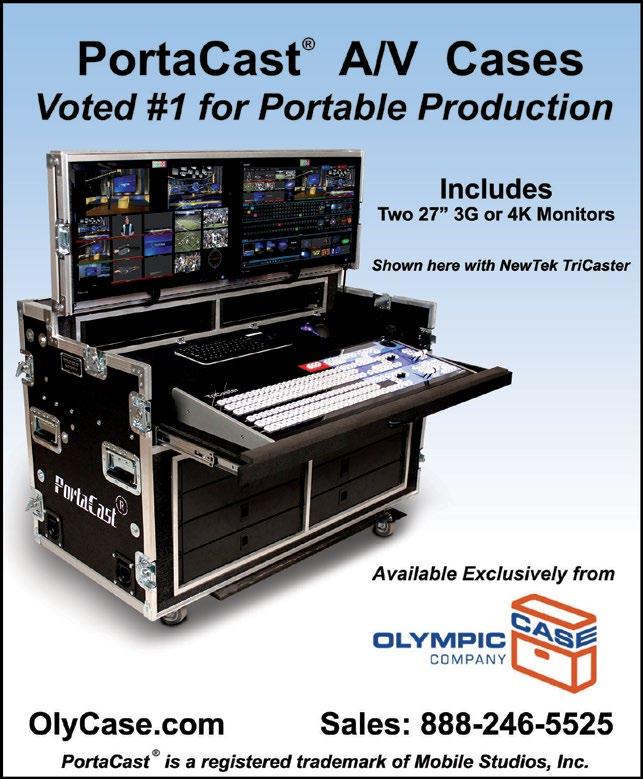
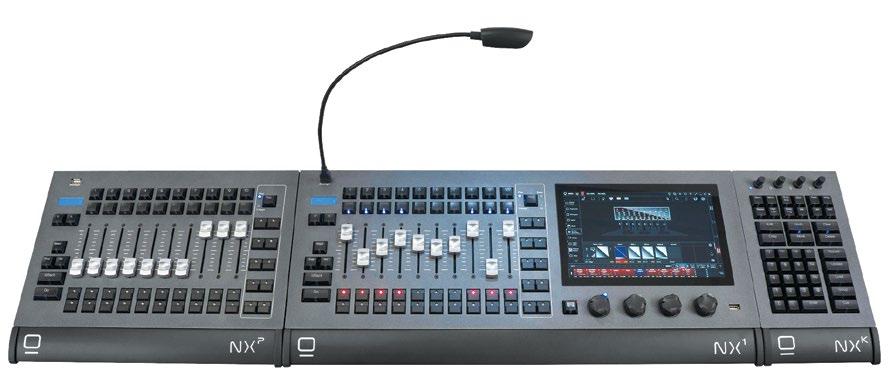

Video Mount Products has launched the ER-HCM Series horizontal cable manager system. Designed for standard 19-inch racks and cabinets, the 1 RU ER-HCM1 and 2 RU ER-HCM2 provide functional management for a variety of cables, with 1.4-inch wide spacing between guide fingers for easy cable routing, adds, changes, and moves. Its generous pass-through ports allow front-to-back cabling. A snap-on cover opens up or down. Smooth edges prevent cable snags and damage, and the black powder coat finish helps provide a clean, finished look to an installation.

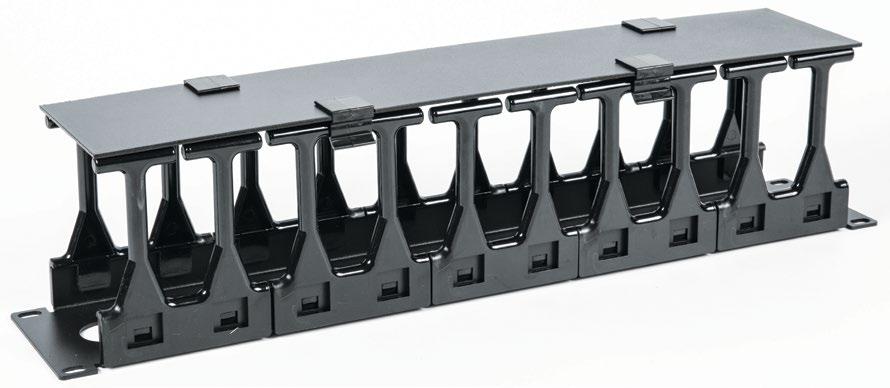
The new VEXO series of high-output loudspeakers includes six models: VEXO110(A), VEXO112(A), and VEXO115(A), which are available both in active and passive versions. The low-frequency transducer is combined with a 1.7-inch voice coil compression driver, enabling high sound pressure levels and a tight driver response with a rotatable 90x70-degree coverage pattern for a wide range of applications. When not in use, the active versions of the VEXO series devices automatically go into an energysaving standby mode, so active versions can also be used in fixed installations. The front side of the VEXO is finished with a powder-coated steel grill with acoustical foam, making the loudspeaker ball impact-proof as well for fixed installations in indoor sports facilities. The VEXO series comes equipped with a wide variety of mounting possibilities.
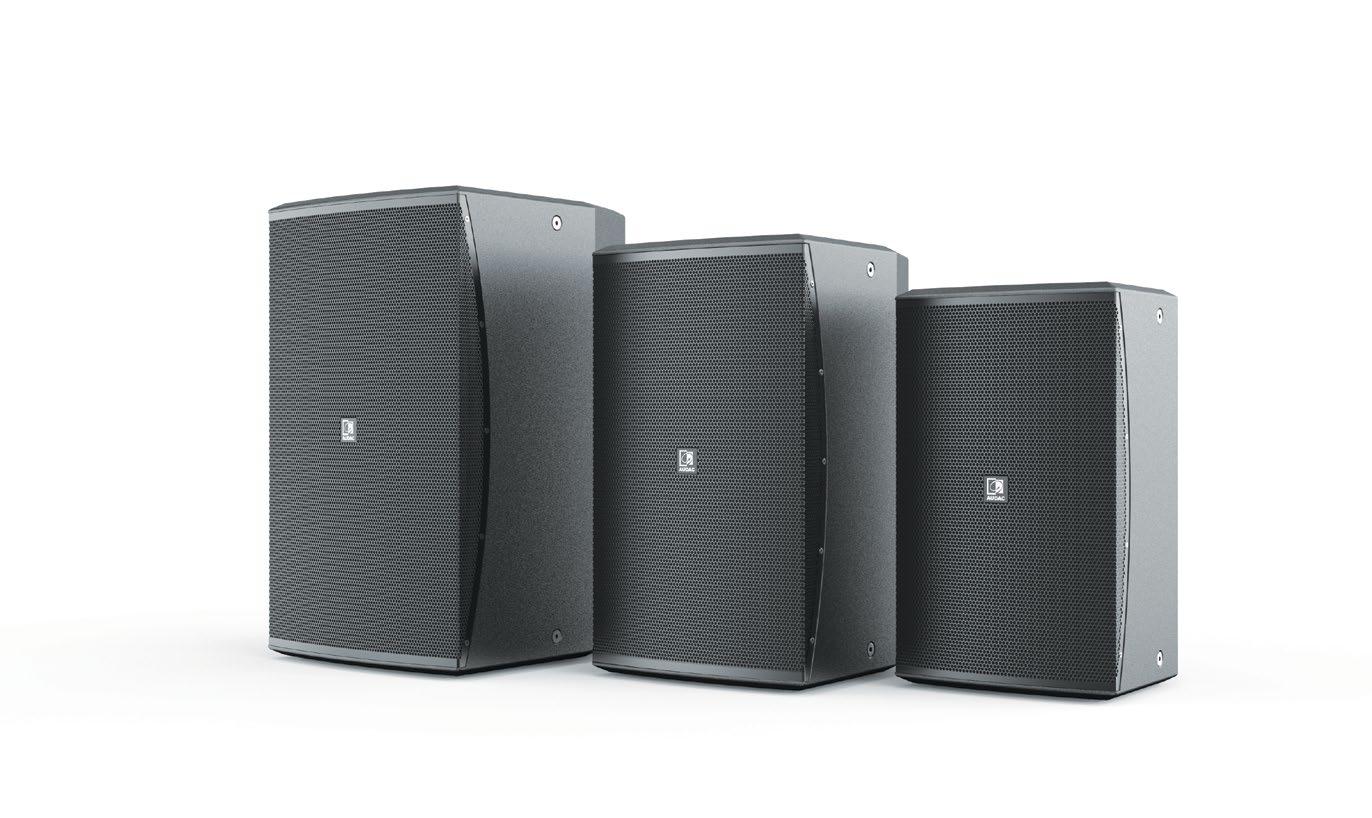
Professionalism has been a hot topic in recent months, as the live event industry roars back to life from a two-year hiatus. In August, Live Nation reported it had sold more than 100 million tickets for concerts this year, which was more than the full ticket count for 2019 (and that was a recordsetting year). That means the demand of labor in the events industry, not just in traditional corporate events but large scale social and entertainment, is at an all-time high, and companies are looking to hire the best talent available.
Being a professional is more than dressing the part or being on time. Although those are important pieces to consider, there are certain characteristics that can allow someone to stand out as a professional.
This industry needs people who are ready to take on challenges, galvanize one another, and lean on each other’s strengths. There are no “easy gigs” right now; time and resources are scarce. We need people to help drive the success of events going into 2023, because there is no sign of demand slowing on the horizon.
Bringing a positive attitude to work every day is not always easy with long days and quick turnarounds, but we are all fighting the same battle and trying to accomplish the same goals. That’s why we need to work together.
A concept discussed in The 15 Commitments of Conscious Leadership is “above the line and below the line.” If you are operating above the line, you are open, curious, and committed to learning. You can respond effectively and usefully in any given situation. If you are below the line, you’re closed off to ideas—your results might support you in the near term, but will be at the
detriment to the rest of your team. Be ready to be a team player and collaborate with others. Be open to change and be ready to lend a hand.
Being able to relate to one another is critical during these stressful times. We are all human beings, and we want to be understood and appreci ated. People aren’t perfect.
This industry is growing rapidly, and mistakes will be made along the way. There are a lot of missing positions and pieces. We can’t scale up without people giving grace, and there is no time for anyone to be a jerk. How you communicate and carry yourself matters.
If you have a fixed mindset of how things were in the before times, you are not open to new ways of doing things. Professionals will have a growth mindset, being open to others, and challenging the status quo in a respectful, not condescending way. This will foster an environment of respect, create higher levels of produc tivity, allow more efficient conflict resolution, and enhance communication. Actions always speak louder than words—how you act even under times of stress shows the kind of professional you truly are.
Maintaining effective work habits is a skill that not everyone has, but it’s instrumental in being a successful professional. Doing what you say you will do, by when you say you will do it, not only shows people they can trust you, but it also shows your professionalism and how you manage priorities. You can be a great engineer or technician, but if you cannot keep up with your schedule, projects, and deadlines, you can never truly be successful.
The lack of accountability is a ripple effect that’s larger than anyone can comprehend. From labor coordinators to project managers, everyone will need to put in extra time and resources to cover for your shortcomings. You may find that you are offered less work in the future, because companies aren’t willing to put up with inconsistencies, especially with such a tight labor market.
Everyone needs to be accountable for their actions on and off the clock. Calling out of an event last minute because you double-booked yourself— or missing a deadline because you lost track of time—is unacceptable and will not be tolerated. People will notice and it could impact your ability to get work in the future.
The live event industry isn’t slowing down. According to the Occupational Outlook Handbook from the U.S. Bureau of Labor Statistics, approximately 16,600 openings for meeting, convention, and event planners are projected on average each year over the next decade. Many of those openings will be from people exiting the labor force or changing occupations.
This is the time to strive for raising the bar on professionalism. We need to show up to support each other, allow room for new ways of thinking and growth, and be accountable. Show up to put your best work forward.
Mel Baglio is director of operations for AV Chicago.


